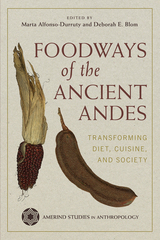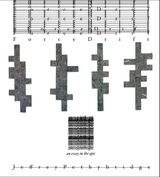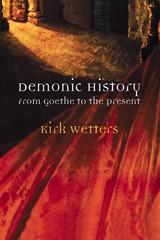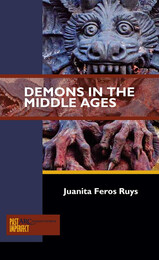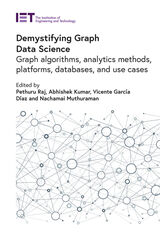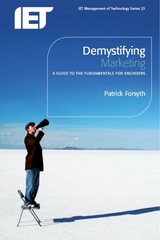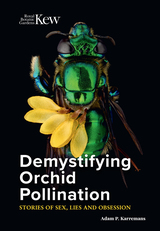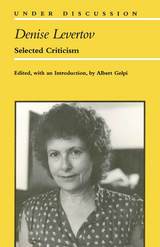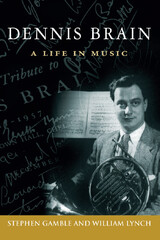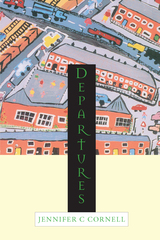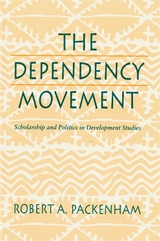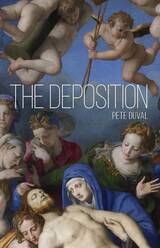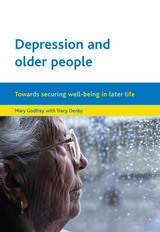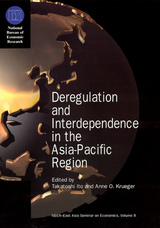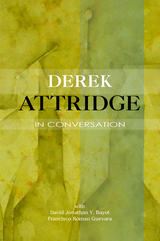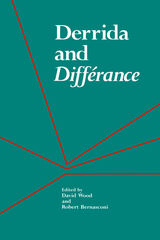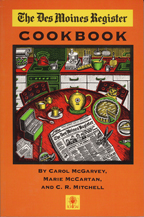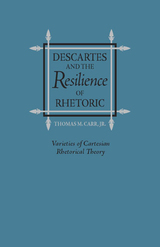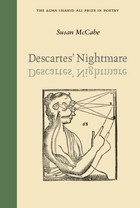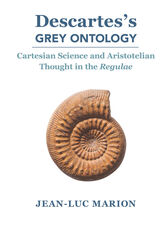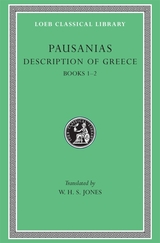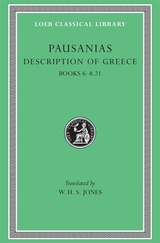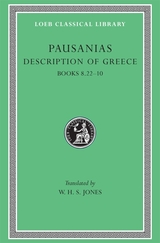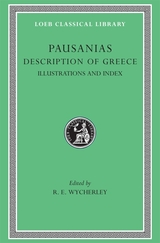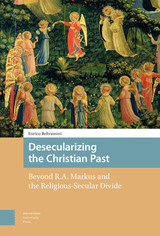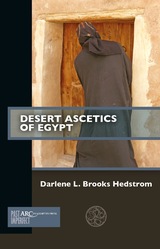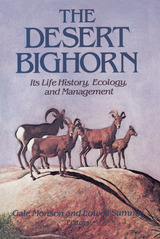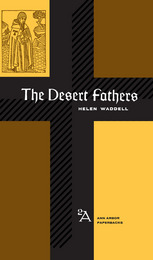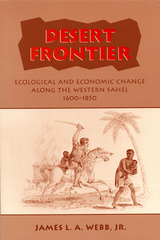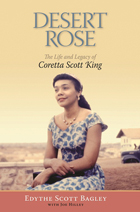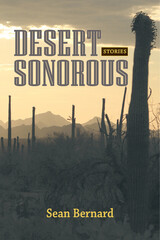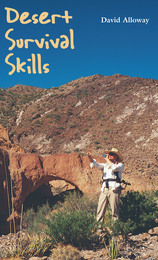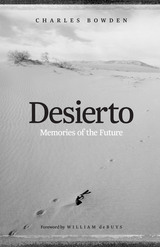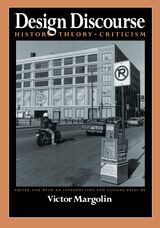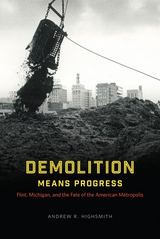 Demolition Means Progress: Flint, Michigan, and the Fate of the American Metropolis
Andrew R. Highsmith
University of Chicago Press, 2015 In 1997, after General Motors shuttered a massive complex of factories in the gritty industrial city of Flint, Michigan, signs were placed around the empty facility reading, “Demolition Means Progress,” suggesting that the struggling metropolis could not move forward to greatness until the old plants met the wrecking ball. Much more than a trite corporate slogan, the phrase encapsulates the operating ethos of the nation’s metropolitan leadership from at least the 1930s to the present. Throughout, the leaders of Flint and other municipalities repeatedly tried to revitalize their communities by demolishing outdated and inefficient structures and institutions and overseeing numerous urban renewal campaigns—many of which yielded only more impoverished and more divided metropolises. After decades of these efforts, the dawn of the twenty-first century found Flint one of the most racially segregated and economically polarized metropolitan areas in the nation.
In one of the most comprehensive works yet written on the history of inequality and metropolitan development in modern America, Andrew R. Highsmith uses the case of Flint to explain how the perennial quest for urban renewal—even more than white flight, corporate abandonment, and other forces—contributed to mass suburbanization, racial and economic division, deindustrialization, and political fragmentation. Challenging much of the conventional wisdom about structural inequality and the roots of the nation’s “urban crisis,” Demolition Means Progress shows in vivid detail how public policies and programs designed to revitalize the Flint area ultimately led to the hardening of social divisions.
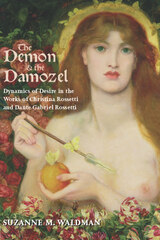 The Demon and the Damozel: Dynamics of Desire in the Works of Christina Rossetti and Dante Gabriel Rossetti
Suzanne M. Waldman
Ohio University Press, 2008 Developing a perspective on Victorian culture as the breeding ground for early theories of the unconscious and the divided psyche, The Demon and the Damozel: Dynamics of Desire in the Works of Christina Rossetti and Dante Gabriel Rossetti offers a new reading of these eminent Victorian siblings’ literature and visual arts. Suzanne M. Waldman views well-known poems and artworks such as Christina Rossetti’s Goblin Market and Dante Gabriel Rossetti’s The Blessed Damozel and Venus Verticordia in new ways that expose their authors’ savvy anticipation of concepts that would come to be known as narcissism, fetishism, and the symbolic and imaginary orders, among many others. Waldman makes a strong case for the particular psychoanalytic importance of the Rossettis by looking at how the two Rossetti siblings’ own psyches were divided by conflicts between the period’s religious scruples and its taste for gothic sensationalism. The Demon and the Damozel is a close and contextualized reading of their writings and artwork that displays, for the first time, continuity between the medieval cosmologies these Pre-Raphaelites drew upon and the psychoanalytic theories they looked ahead to—and locates the intricate patterns of proto-psychoanalytic understanding in the rich tapestry of Pre-Raphaelite aestheticism.
 Demon in the Box: Jews, Arabs, Politics, and Culture in the Making of Israeli Television
Oren, Tasha G
Rutgers University Press, 2004 What does a country's television programming say about its deep character, beliefs, dreams, and fears? In Demon in the Box, Tasha G. Oren recounts the volatile history of Israeli television and thereby reveals the history of the nation itself. Initially rejected as a corrupting influence on "the people of the book," television became the object of fantasies and anxieties that went to the heart of Israel's most pressing concerns: Arab-Israeli relations, immigration, and the forging of a modern Israeli culture. Television broadcasting was aimed toward external relations-the flow of messages across borders, Arab-Israeli conflict, and the shaping of public opinion worldwide-as much as it was toward internal needs and interests. Through archival research and analysis of public scandals and early programs, Oren traces Israeli television's transformation from a feared agent of decadence to a powerful national communication tool, and eventually, to a vastly popular entertainment medium.
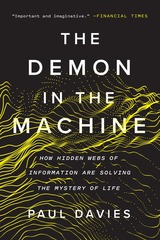 The Demon in the Machine: How Hidden Webs of Information Are Solving the Mystery of Life
Paul Davies
University of Chicago Press, 1991 Physics World Book of the Year
A Financial Times, Sunday Times, and Telegraph Best Science Book of the Year
What is life? For generations, scientists have struggled to make sense of this fundamental question, for life really does look like magic: even a humble bacterium accomplishes things so dazzling that no human engineer can match it. Huge advances in molecular biology over the past few decades have served only to deepen the mystery.
In this penetrating and wide-ranging book, world-renowned physicist and science communicator Paul Davies searches for answers in a field so new and fast-moving that it lacks a name; it is a domain where biology, computing, logic, chemistry, quantum physics, and nanotechnology intersect. At the heart of these diverse fields, Davies explains, is the concept of information: a quantity which has the power to unify biology with physics, transform technology and medicine, and force us to fundamentally reconsider what it means to be alive—even illuminating the age-old question of whether we are alone in the universe.
From life’s murky origins to the microscopic engines that run the cells of our bodies, The Demon in the Machine journeys across an astounding landscape of cutting-edge science. Weaving together cancer and consciousness, two-headed worms and bird navigation, Davies reveals how biological organisms garner and process information to conjure order out of chaos, opening a window onto the secret of life itself.
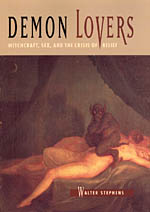 Demon Lovers: Witchcraft, Sex, and the Crisis of Belief
Walter Stephens
University of Chicago Press, 2002 On September 20, 1587, Walpurga Hausmännin of Dillingen in southern Germany was burned at the stake as a witch. Although she had confessed to committing a long list of maleficia (deeds of harmful magic), including killing forty—one infants and two mothers in labor, her evil career allegedly began with just one heinous act—sex with a demon. Fornication with demons was a major theme of her trial record, which detailed an almost continuous orgy of sexual excess with her diabolical paramour Federlin "in many divers places, . . . even in the street by night."
As Walter Stephens demonstrates in Demon Lovers, it was not Hausmännin or other so-called witches who were obsessive about sex with demons—instead, a number of devout Christians, including trained theologians, displayed an uncanny preoccupation with the topic during the centuries of the "witch craze." Why? To find out, Stephens conducts a detailed investigation of the first and most influential treatises on witchcraft (written between 1430 and 1530), including the infamous Malleus Maleficarum (Hammer of Witches).
Far from being credulous fools or mindless misogynists, early writers on witchcraft emerge in Stephens's account as rational but reluctant skeptics, trying desperately to resolve contradictions in Christian thought on God, spirits, and sacraments that had bedeviled theologians for centuries. Proof of the physical existence of demons—for instance, through evidence of their intercourse with mortal witches—would provide strong evidence for the reality of the supernatural, the truth of the Bible, and the existence of God. Early modern witchcraft theory reflected a crisis of belief—a crisis that continues to be expressed today in popular debates over angels, Satanic ritual child abuse, and alien abduction.
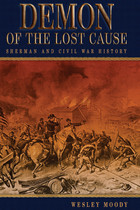 Demon of the Lost Cause: Sherman and Civil War History
Wesley Moody
University of Missouri Press, 2011 At the end of the Civil War, Union general William Tecumseh Sherman was surprisingly more popular in the newly defeated South than he was in the North. Yet, only thirty years later, his name was synonymous with evil and destruction in the South, particularly as the creator and enactor of the “total war” policy. In Demon of the Lost Cause, Wesley Moody examines these perplexing contradictions and how they and others function in past and present myths about Sherman. Throughout this fascinating study of Sherman’s reputation, from his first public servant role as the major general for the state of California until his death in 1891, Moody explores why Sherman remains one of the most controversial figures in American history. Using contemporary newspaper accounts, Sherman’s letters and memoirs, as well as biographies of Sherman and histories of his times, Moody reveals that Sherman’s shifting reputation was formed by whoever controlled the message, whether it was the Lost Cause historians of the South, Sherman’s enemies in the North, or Sherman himself. With his famous “March to the Sea” in Georgia, the general became known for inventing a brutal warfare where the conflict is brought to the civilian population. In fact, many of Sherman’s actions were official tactics to be employed when dealing with guerrilla forces, yet Sherman never put an end to the talk of his innovative tactics and even added to the stories himself. Sherman knew he had enemies in the Union army and within the Republican elite who could and would jeopardize his position for their own gain. In fact, these were the same people who spread the word that Sherman was a Southern sympathizer following the war, helping to place the general in the South’s good graces. That all changed, however, when the Lost Cause historians began formulating revisions to the Civil War, as Sherman’s actions were the perfect explanation for why the South had lost. Demon of the Lost Cause reveals the machinations behind the Sherman myth and the reasons behind the acceptance of such myths, no matter who invented them. In the case of Sherman’s own mythmaking, Moody postulates that his motivation was to secure a military position to support his wife and children. For the other Sherman mythmakers, personal or political gain was typically the rationale behind the stories they told and believed. In tracing Sherman’s ever-changing reputation, Moody sheds light on current and past understanding of the Civil War through the lens of one of its most controversial figures.
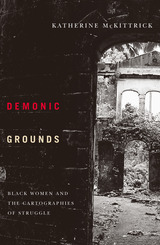 Demonic Grounds: Black Women And The Cartographies Of Struggle
Katherine McKittrick
University of Minnesota Press, 2006 IIn a long overdue contribution to geography and social theory, Katherine McKittrick offers a new and powerful interpretation of black women’s geographic thought. In Canada, the Caribbean, and the United States, black women inhabit diasporic locations marked by the legacy of violence and slavery. Analyzing diverse literatures and material geographies, McKittrick reveals how human geographies are a result of racialized connections, and how spaces that are fraught with limitation are underacknowledged but meaningful sites of political opposition.
Demonic Grounds moves between past and present, archives and fiction, theory and everyday, to focus on places negotiated by black women during and after the transatlantic slave trade. Specifically, the author addresses the geographic implications of slave auction blocks, Harriet Jacobs’s attic, black Canada and New France, as well as the conceptual spaces of feminism and Sylvia Wynter’s philosophies.
Central to McKittrick’s argument are the ways in which black women are not passive recipients of their surroundings and how a sense of place relates to the struggle against domination. Ultimately, McKittrick argues, these complex black geographies are alterable and may provide the opportunity for social and cultural change.
Katherine McKittrick is assistant professor of women’s studies at Queen’s University.
Demonic History: From Goethe to the Present
Kirk Wetters
Northwestern University Press, 2014 In this ambitious book, Kirk Wetters traces the genealogy of the demonic in German literature from its imbrications in Goethe to its varying legacies in the work of essential authors, both canonical and less well known, such as Gundolf, Spengler, Benjamin, Lukács, and Doderer. Wetters focuses especially on the philological and metaphorological resonances of the demonic from its core formations through its appropriations in the tumultuous twentieth century. Propelled by equal parts theoretical and historical acumen, Wetters explores the ways in which the question of the demonic has been employed to multiple theoretical, literary, and historico-political ends. He thereby produces an intellectual history that will be consequential both to scholars of German literature and to comparatists.
 Demonic Warfare: Daoism, Territorial Networks, and the History of a Ming Novel
Mark R.E. Meulenbeld
University of Hawaii Press, 2015 Revealing the fundamental continuities between vernacular fiction and exorcist, martial rituals in the vernacular language, Meulenbeld argues that a specific type of Daoist exorcism helped shape vernacular novels in the late Ming dynasty (1368–1644). Focusing on the once famous novel Fengshen yanyi (“Canonization of the Gods”), the author maps out the general ritual structure and divine protagonists that it borrows from much older systems of Daoist exorcism. By exploring how the novel reflects the specific concerns of communities associated with Fengshen yanyi and its ideology, Meulenbeld is able to reconstruct the cultural sphere in which Daoist exorcist rituals informed late imperial “novels.” He first looks at temple networks and their religious festivals, then shows that it is by means of dramatic practices like ritual, theatre, and temple processions that divine acts were embodied and brought to life. Meulenbeld makes a convincing case for the need to debunk the retrospective reading of China through the modern, secular Western categories of “literature,” “society,” and “politics.” He shows that this disregard of religious dynamics has distorted our understanding of China and that “religion” cannot be conveniently isolated from scholarly analysis.
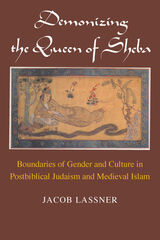 Demonizing the Queen of Sheba: Boundaries of Gender and Culture in Postbiblical Judaism and Medieval Islam
Jacob Lassner
University of Chicago Press, 1993 Over the centuries, Jewish and Muslim writers transformed the biblical Queen of Sheba from a clever, politically astute sovereign to a demonic force threatening the boundaries of gender. In this book, Jacob Lassner shows how successive retellings of the biblical story reveal anxieties about gender and illuminate the processes of cultural transmission.
The Bible presents the Queen of Sheba's encounter with King Solomon as a diplomatic mission: the queen comes "to test him with hard questions," all of which he answers to her satisfaction; she then praises him and, after an exchange of gifts, returns to her own land. By the Middle Ages, Lassner demonstrates, the focus of the queen's visit had shifted from international to sexual politics. The queen was now portrayed as acting in open defiance of nature's equilibrium and God's design. In these retellings, the authors humbled the queen and thereby restored the world to its proper condition.
Lassner also examines the Islamization of Jewish themes, using the dramatic accounts of Solomon and his female antagonist as a test case of how Jewish lore penetrated the literary imagination of Muslims. Demonizing the Queen of Sheba thus addresses not only specialists in Jewish and Islamic studies, but also those concerned with issues of cultural transmission and the role of gender in history.
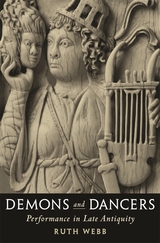 Demons and Dancers: Performance in Late Antiquity
Ruth Webb
Harvard University Press, 2008 Compared to the wealth of information available to us about classical tragedy and comedy, not much is known about the culture of pantomime, mime, and dance in late antiquity. Charges of obscenity and polemical anti-theater discourse have, at times, erased these popular performance traditions from the modern imagination. Demons and Dancers returns us to the times and places where those great ancient theaters were more than picturesque ruins dotting the Mediterranean landscape.
Ruth Webb fills this gap in our knowledge of the ancient world and provides us with a richly detailed look at social life in the late antique period through an investigation of its performance culture. The book focuses on the eastern empire, from Greece proper to modern-day Turkey and Egypt, between the second and sixth centuries CE. Using some of the tools provided by modern performance theory, this book explains how audiences interpreted the actions on stage, how the status of male and female performers shifted across time and place, how skilled the actors actually were (it was commonplace to dismiss these performers for their lack of skill), and what role spectacles involving spoken and sung words, as well as stylized gestures, had in Greco-Roman civic life.
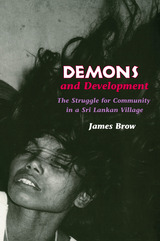 Demons and Development: The Struggle for Community in a Sri Lankan Village
James Brow
University of Arizona Press, 1996 In contemporary Sri Lanka, long-established modes of rural life are being disrupted in the name of progress. As this occurs, instances of "demonic possession" have been known to take place—incidents that may both express the conflicts that result and attempt to resolve them. When residents of the village of Kukulewa were promised sixty new houses, a factional rift arose between those who benefited from the project and those who did not. The breach between what became in effect two separate villages resulted in both divisive accusations of sorcery and spirit-inspired appeals for cooperation.
James Brow witnessed these possession trances and sorcery accusations as they occurred, enabling him to convey this richly textured story interweaving political factionalism and troubled spirits. Official projects of development have proceeded apace in Sri Lanka, but until now there have been few accounts of their tendency to tear apart the fabric of rural society. Demons and Development combines an engaging narrative of how development was experienced in one particular village with an original contribution to theories of hegemony, the social anthropology of South Asia, the ethnography of nationalism, and the sociology of development.
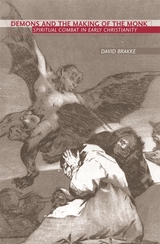 Demons and the Making of the Monk: Spiritual Combat in Early Christianity
David Brakke
Harvard University Press, 2006 Demons--whether in embodied form or as inward temptation--make vivid appearances in early Christian monastic literature. In this finely written study of demonology and Christian spirituality in fourth- and fifth-century Egypt, David Brakke examines how the conception of the monk as a holy and virtuous being was shaped by the combative encounter with demons.
Brakke studies the "making of the monk" from two perspectives. First, he describes the social and religious identities that monastic authors imagined for the demon-fighting monk: the new martyr who fights against the pagan gods, the gnostic who believes he knows both the tricks of the demons and the secrets of God, and the prophet who discerns the hidden presence of Satan even among good Christians. Then he employs recent theoretical ideas about gender and racial stereotyping to interpret accounts of demon encounters, especially those in which demons appear as the Other--as Ethiopians, as women, or as pagan gods.
Drawing on biographies of exceptional monks, collections of monastic sayings and stories, letters from ascetic teachers to their disciples, sermons, and community rules, Brakke crafts a compelling picture of the embattled religious celibate. Demons and the Making of the Monk is an insightful and innovative exploration of the development of Christian monasticism.
 Demons in Eden: The Paradox of Plant Diversity
Jonathan Silvertown
University of Chicago Press, 2005 At the heart of evolution lies a bewildering paradox. Natural selection favors above all the individual that leaves the most offspring—a superorganism of sorts that Jonathan Silvertown here calls the "Darwinian demon." But if such a demon existed, this highly successful organism would populate the entire world with its own kind, beating out other species and eventually extinguishing biodiversity as we know it. Why then, if evolution favors this demon, is the world filled with so many different life forms? What keeps this Darwinian demon in check? If humankind is now the greatest threat to biodiversity on the planet, have we become the Darwinian demon?
Demons in Eden considers these questions using the latest scientific discoveries from the plant world. Readers join Silvertown as he explores the astonishing diversity of plant life in regions as spectacular as the verdant climes of Japan, the lush grounds of the Royal Botanical Gardens at Kew, the shallow wetlands and teeming freshwaters of Florida, the tropical rainforests of southeast Mexico, and the Canary Islands archipelago, whose evolutionary novelties—and exotic plant life—have earned it the sobriquet "the Galapagos of botany." Along the way, Silvertown looks closely at the evolution of plant diversity in these locales and explains why such variety persists in light of ecological patterns and evolutionary processes. In novel and useful ways, he also investigates the current state of plant diversity on the planet to show the ever-challenging threats posed by invasive species and humans.
Bringing the secret life of plants into more colorful and vivid focus than ever before, Demons in Eden is an empathic and impassioned exploration of modern plant ecology that unlocks evolutionary mysteries of the natural world.
Demons in the Middle Ages
Juanita Feros Ruys
Arc Humanities Press, 2017 The medieval world was full of malicious demons: fallen angels commissioned to tempt humans away from God. From demons disguised as beautiful women to demons that took frightening animal-like forms, this book explores the history of thought about demons: what they were, what they could and could not do, and how they affected human lives. It considers the debates, stories, and writing that eventually gave shape to the witchcraze of the early modern period.
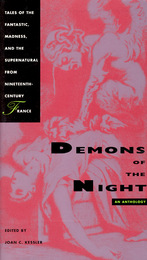 Demons of the Night: Tales of the Fantastic, Madness, and the Supernatural from Nineteenth-Century France
Edited by Joan C. Kessler
University of Chicago Press, 1995 Demons of the Night is a trove of haunting fiction—a gathering, for the first time in English, of the best nineteenth-century French fantastic tales. Featuring such authors as Balzac, Mérimée, Dumas, Verne, and Maupassant, this book offers readers familiar with the works of Edgar Allan Poe and E. T. A. Hoffman some of the most memorable stories in the genre. With its aura of the uncanny and the supernatural, the fantastic tale is a vehicle for exploring forbidden themes and the dark, irrational side of the human psyche.
The anthology opens with "Smarra, or the Demons of the Night," Nodier's 1821 tale of nightmare, vampirism, and compulsion, acclaimed as the first work in French literature to explore in depth the realm of dream and the unconscious. Other stories include Balzac's "The Red Inn," in which a crime is committed by one person in thought and another in deed, and Mérimée's superbly crafted mystery, "The Venus of Ille," which dramatizes the demonic power of a vengeful goddess of love emerging out of the pagan past. Gautier's protagonist in "The Dead in Love" develops an obsessive passion for a woman who has returned from beyond the grave, while the narrator of Maupassant's "The Horla" imagines himself a victim of psychic vampirism.
Joan Kessler has prepared new translations of nine of the thirteen tales in the volume, including Gérard de Nerval's odyssey of madness, "Aurélia," as well as two tales that have never before appeared in English. Kessler's introduction sets the background of these tales—the impact of the French Revolution and the Terror, the Romantics' fascination with the subconscious, and the influence of contemporary psychological and spiritual currents. Her essay illuminates how each of the authors in this collection used the fantastic to articulate his own haunting obsessions as well as his broader vision of human experience.
 Demonstration and Scientific Knowledge in William of Ockham: A Translation of Summa Logicae III-II: De Syllogismo Demonstrativo, and Selections from the Prologue to the Ordinatio
John Lee Longeway
University of Notre Dame Press, 2007 This book makes available for the first time an English translation of William Ockham's work on Aristotle's Posterior Analytics, which contains his theory of scientific demonstration and philosophy of science. John Lee Longeway also includes an extensive commentary and a detailed history of the intellectual background to Ockham's work in the Latin Middle Ages. Longeway puts Ockham into context by providing a scholarly account of the reception and study of the Posterior Analytics in the Latin Middle Ages, with a detailed discussion of Robert Grosseteste, Albert the Great, Thomas Aquinas, Duns Scotus, and Giles of Rome. In a series of appendices, Longeway includes shorter translations of some important related work by Giles of Rome and John of Cornwall.
In his introductory discussion, Longeway examines the exact character of the highest sort of demonstration (demonstratio potissima), the relations of the empirical sciences to mathematics, natural causation and the manner in which natural laws come to be known, the possibility of natural knowledge, our knowledge of God, and the relation of theology to the other sciences. Longeway discusses the way in which scientific epistemology and theory of demonstration corresponds to the metaphysical position of its interpreter, in particular to the Neoplatonism of Grosseteste, the radical Aristotelianism of Giles of Rome and Albert the Great, the more moderate Aristotelianism of Aquinas, and the nominalistic empiricism of Ockham. Throughout the book, Longeway makes a case for Ockham's importance as the founder of Empiricism in the West.
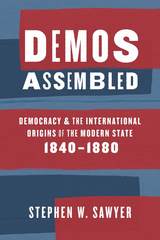 Demos Assembled: Democracy and the International Origins of the Modern State, 1840–1880
Stephen W. Sawyer
University of Chicago Press, 2018 An intelligent, engaging, and in-depth reading of the nature of the state and the establishment of the modern political order in the mid-nineteenth century.
Previous studies have covered in great detail how the modern state slowly emerged from the early Renaissance through the seventeenth century, but we know relatively little about the next great act: the birth and transformation of the modern democratic state. And in an era where our democratic institutions are rife with conflict, it’s more important now than ever to understand how our institutions came into being.
Stephen W. Sawyer’s Demos Assembled provides us with a fresh, transatlantic understanding of that political order’s genesis. While the French influence on American political development is well understood, Sawyer sheds new light on the subsequent reciprocal influence that American thinkers and politicians had on the establishment of post-revolutionary regimes in France. He argues that the emergence of the stable Third Republic (1870–1940), which is typically said to have been driven by idiosyncratic internal factors, was in fact a deeply transnational, dynamic phenomenon. Sawyer’s findings reach beyond their historical moment, speaking broadly to conceptions of state formation: how contingent claims to authority, whether grounded in violence or appeals to reason and common cause, take form as stateness.
 Demos Rising: Democracy and the Popular Construction of Public Power in France, 1800–1850
Stephen W. Sawyer
University of Chicago Press, 2025 A political history exploring the concept of demos in the French government during the period of 1800 to 1850.
In his previous book, Demos Assembled, historian Stephen W. Sawyer offered a transatlantic account of the birth and transformation of the modern democratic state. In Demos Rising, he presents readers of political history with a prequel whose ambitious claim is that a genuine demos became possible in France only with the development of government regulation and administration. Focusing on democracy as a form of administration rather than as a form of sovereignty allows Sawyer to explore urban planning, work and private enterprise, health administration, and much more as cornerstones of a self-governing society of equals.
Examining the period between 1800 and 1850, Sawyer studies a set of thinkers who debated at length over the material problems of everyday life, sparking calls for political action and social reform in the face of conflict wreaked by deforestation, urbanization, health crises, labor relations, industrial capitalism, religious tensions, and imperial expansion. The solutions to these problems, Sawyer argues, were sought—and sometimes found—not through elections, as one might assume, but rather through the “care for all” promised by modern administrative power, regulatory intervention, and social welfare programs. By studying this profound transformation in governance, the book wagers, we can better understand the origin and meaning of democracy—even when events in our own time have thrown the concept into doubt.
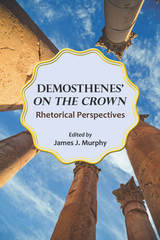 Demosthenes' "On the Crown": Rhetorical Perspectives
Edited by James J. Murphy
Southern Illinois University Press, 2016 Demosthenes’ speech On the Crown (330 B.C.E.), in which the master orator spectacularly defended his public career, has long been recognized as a masterpiece. The speech has been in continuous circulation from Demosthenes’ lifetime to the present day, and multiple generations have acclaimed it as the greatest speech ever written. In addition to a clear and accessible translation, Demosthenes’“On the Crown”:Rhetorical Perspectives includes eight essays that provide a thorough analysis—based on Aristotelian principles—of Demosthenes’ superb rhetoric.
The volume includes biographical and historical background on Demosthenes and his political situation; a structural analysis of On the Crown; and an abstract of Aeschines’ speech Against Ctesiphon to which Demosthenes was responding. Four essays by contributors analyze Demosthenes’ speech using key elements of rhetoric defined by Aristotle: ēthos, the speaker’s character or authority; pathos, or emotional appeals; logos, or logical appeals; and lexis, a speaker’s style. An introduction and an epilogue by Murphy frame the speech and the rhetorical analysis of it.
By bringing together contextual material about Demosthenes and his speech with a translation and astute rhetorical analyses, Demosthenes’“On the Crown”:Rhetorical Perspectives highlights the oratorical artistry of Demosthenes and provides scholars and students with fresh insights into a landmark speech.
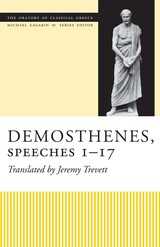 Demosthenes, Speeches 1–17
Translated by Jeremy Trevett
University of Texas Press, 2011 This is the fourteenth volume in the Oratory of Classical Greece. This series presents all of the surviving speeches from the late fifth and fourth centuries BC in new translations prepared by classical scholars who are at the forefront of the discipline. These translations are especially designed for the needs and interests of today's undergraduates, Greekless scholars in other disciplines, and the general public. Classical oratory is an invaluable resource for the study of ancient Greek life and culture. The speeches offer evidence on Greek moral views, social and economic conditions, political and social ideology, law and legal procedure, and other aspects of Athenian culture that have recently been attracting particular interest: women and family life, slavery, and religion, to name just a few. This volume contains translations of all the surviving deliberative speeches of Demosthenes (plus two that are almost certainly not his, although they have been passed down as part of his corpus), as well as the text of a letter from Philip of Macedon to the Athenians. All of the speeches were purportedly written to be delivered to the Athenian assembly and are in fact almost the only examples in Attic oratory of the genre of deliberative oratory. In the Olynthiac and Philippic speeches, Demosthenes identifies the Macedonian king Philip as a major threat to Athens and urges direct action against him. The Philippic speeches later inspired the Roman orator Cicero in his own attacks against Mark Antony, and became one of Demosthenes' claims to fame throughout history.
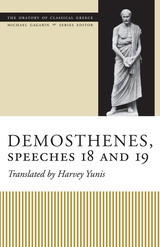 Demosthenes, Speeches 18 and 19
Translated by Harvey Yunis
University of Texas Press, 2005 2006 — Soeurette Diehl Fraser Award for Best Translation of a Book, Texas Institute of Letters This is the ninth volume in the Oratory of Classical Greece. This series presents all of the surviving speeches from the late fifth and fourth centuries BC in new translations prepared by classical scholars who are at the forefront of the discipline. These translations are especially designed for the needs and interests of today's undergraduates, Greekless scholars in other disciplines, and the general public. Classical oratory is an invaluable resource for the study of ancient Greek life and culture. The speeches offer evidence on Greek moral views, social and economic conditions, political and social ideology, law and legal procedure, and other aspects of Athenian culture that have recently been attracting particular interest: women and family life, slavery, and religion, to name just a few. Demosthenes is regarded as the greatest orator of classical antiquity. The two speeches translated here grew out of his longtime rivalry with the orator Aeschines. In Speech 19 (On the Dishonest Embassy) delivered in 343 BC, Demosthenes attacks Aeschines for corruption centered around an ultimately disastrous embassy to Philip of Macedon that both men took part in. This speech made Demosthenes the leading politician in Athens for a time. Speech 18 (On the Crown or De Corona), delivered in 330 BC, is Demosthenes' most famous and influential oration. It resulted not only in Demosthenes receiving one of Athens' highest political honors but also in the defeat and disgrace of Aeschines, who retired from public life and left Athens forever.
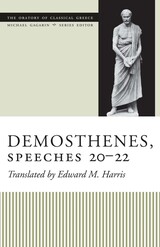 Demosthenes, Speeches 20-22
Translated by Edward M. Harris
University of Texas Press, 2008 This is the twelfth volume in the Oratory of Classical Greece. This series presents all of the surviving speeches from the late fifth and fourth centuries BC in new translations prepared by classical scholars who are at the forefront of the discipline. These translations are especially designed for the needs and interests of today's undergraduates, Greekless scholars in other disciplines, and the general public. Classical oratory is an invaluable resource for the study of ancient Greek life and culture. The speeches offer evidence on Greek moral views, social and economic conditions, political and social ideology, law and legal procedure, and other aspects of Athenian culture that have recently been attracting particular interest: women and family life, slavery, and religion, to name just a few. Demosthenes is regarded as the greatest orator of classical antiquity. This volume contains three important speeches from the earliest years of his political career: Against Leptines, a prosecution brought against a law repealing all exemptions from liturgies; Against Meidias, a prosecution for aggravated insult (hybris) brought against an influential politician; and Against Androtion, an indictment of a decree of honors for the Council of Athens. Edward M. Harris provides contemporary English translations of these speeches, two of which (Leptines and Androtion) have not been translated into English in over sixty years, along with introductions and extensive notes that take account of recent developments in Classical scholarship.
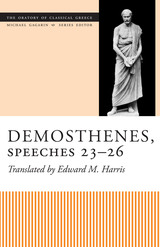 Demosthenes, Speeches 23-26
Translated by Edward M. Harris
University of Texas Press, 2018 This is the fifteenth volume in the Oratory of Classical Greece. This series presents all of the surviving speeches from the late fifth and fourth centuries BC in new translations prepared by classical scholars who are at the forefront of the discipline. These translations are especially designed for the needs and interests of today’s undergraduates, Greekless scholars in other disciplines, and the general public. Classical oratory is an invaluable resource for the study of ancient Greek life and culture. The speeches offer evidence on Greek moral views, social and economic conditions, political and social ideology, law and legal procedure, and other aspects of Athenian culture that have recently been attracting particular interest: women and family life, slavery, and religion, to name just a few. This volume provides introductions, translations, and notes for four speeches found in the Demosthenic corpus that have not been translated in recent times. Against Aristocrates deals with matters of foreign policy involving a mercenary general, Charidemus, and is a valuable source for Athenian homicide law. Against Timocrates involves domestic politics and provides important information about Athenian procedures for enacting legislation. In both speeches, the litigants stress the importance of the rule of law in Athenian democracy and emphasize key ideas, such as the monopoly of legitimate force by the state, the need for consistency in statutes, and the principle of no punishment without a written law. The remaining two speeches, Against Aristogeiton, are forgeries composed in the Hellenistic period, as Edward Harris demonstrates conclusively through a study of laws and legal procedures and an analysis of style and vocabulary.
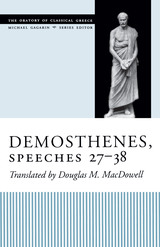 Demosthenes, Speeches 27-38
Translated by Douglas M. MacDowell
University of Texas Press, 2004 This is the eighth volume in the Oratory of Classical Greece. This series presents all of the surviving speeches from the late fifth and fourth centuries BC in new translations prepared by classical scholars who are at the forefront of the discipline. These translations are especially designed for the needs and interests of today's undergraduates, Greekless scholars in other disciplines, and the general public. Classical oratory is an invaluable resource for the study of ancient Greek life and culture. The speeches offer evidence on Greek moral views, social and economic conditions, political and social ideology, law and legal procedure, and other aspects of Athenian culture that have recently been attracting particular interest: women and family life, slavery, and religion, to name just a few. Demosthenes is regarded as the greatest orator of classical antiquity. This volume contains five speeches written for lawsuits in which Demosthenes sought to recover his inheritance, which he claimed was fraudulently misappropriated and squandered by the trustees of the estate. These speeches shed light on Athenian systems of inheritance, marriage, and dowry. The volume also contains seven speeches illustrating the legal procedure known as paragraphe, or "counter-indictment." Four of these are for lawsuits involving commercial shipping, a vital aspect of the Athenian economy that was crucial to maintaining the city's imported food supply. Another concerns the famous Athenian silver mines.
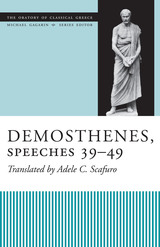 Demosthenes, Speeches 39-49
Translated by Adele C. Scafuro
University of Texas Press, 2011 This is the thirteenth volume in the Oratory of Classical Greece. This series presents all of the surviving speeches from the late fifth and fourth centuries BC in new translations prepared by classical scholars who are at the forefront of the discipline. These translations are especially designed for the needs and interests of today's undergraduates, Greekless scholars in other disciplines, and the general public. Classical oratory is an invaluable resource for the study of ancient Greek life and culture. The speeches offer evidence on Greek moral views, social and economic conditions, political and social ideology, law and legal procedure, and other aspects of Athenian culture that have recently been attracting particular interest: women and family life, slavery, and religion, to name just a few. Demosthenes is regarded as the greatest orator of classical antiquity. This volume contains eleven law court speeches ascribed to Demosthenes, though modern scholars believe that only two or three of them are actually his. Most of the speeches here concern inheriting an estate, recovering debts owed to an estate, or exchanging someone else's estate for one's own. Adele Scafuro's supplementary material allows even non-specialists to follow the ins and outs of the legal arguments as she details what we know about the matters involved in each case, including marriage laws, adoptions, inheritances, and the financial obligations of the rich. While Athenian laws and family institutions (e.g., the marriages of heiresses) differ from ours in quite interesting ways, nevertheless the motives and strategies of the litigants often have a contemporary resonance.
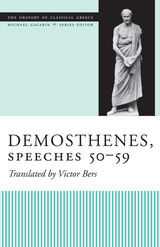 Demosthenes, Speeches 50-59
Translated by Victor Bers
University of Texas Press, 2003 This is the sixth volume in the Oratory of Classical Greece. This series presents all of the surviving speeches from the late fifth and fourth centuries BC in new translations prepared by classical scholars who are at the forefront of the discipline. These translations are especially designed for the needs and interests of today's undergraduates, Greekless scholars in other disciplines, and the general public. Classical oratory is an invaluable resource for the study of ancient Greek life and culture. The speeches offer evidence on Greek moral views, social and economic conditions, political and social ideology, law and legal procedure, and other aspects of Athenian culture that have been largely ignored: women and family life, slavery, and religion, to name just a few. Demosthenes is regarded as the greatest orator of classical antiquity; indeed, his very eminence may be responsible for the inclusion under his name of a number of speeches he almost certainly did not write. This volume contains four speeches that are most probably the work of Apollodorus, who is often known as "the Eleventh Attic Orator." Regardless of their authorship, however, this set of ten law court speeches gives a vivid sense of public and private life in fourth-century BC Athens. They tell of the friendships and quarrels of rural neighbors, of young men joined in raucous, intentionally shocking behavior, of families enduring great poverty, and of the intricate involvement of prostitutes in the lives of citizens. They also deal with the outfitting of warships, the grain trade, challenges to citizenship, and restrictions on the civic role of men in debt to the state.
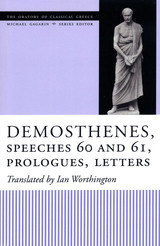 Demosthenes, Speeches 60 and 61, Prologues, Letters
Translated by Ian Worthington
University of Texas Press, 2006 This is the tenth volume in the Oratory of Classical Greece. This series presents all of the surviving speeches from the late fifth and fourth centuries BC in new translations prepared by classical scholars who are at the forefront of the discipline. These translations are especially designed for the needs and interests of today's undergraduates, Greekless scholars in other disciplines, and the general public. Classical oratory is an invaluable resource for the study of ancient Greek life and culture. The speeches offer evidence on Greek moral views, social and economic conditions, political and social ideology, law and legal procedure, and other aspects of Athenian culture that have recently been attracting particular interest: women and family life, slavery, and religion, to name just a few. Demosthenes is regarded as the greatest orator of classical antiquity. This volume contains his Funeral Oration (Speech 60) for those who died in the Battle of Chaeronea in 338 BC, in which Philip of Macedonia secured his dominance over Greece, as well as the so-called Erotic Essay (Speech 61), a rhetorical exercise in which the speaker eulogizes the youth Epicrates for his looks and physical prowess and encourages him to study philosophy in order to become a virtuous and morally upright citizen. The volume also includes fifty-six prologues (the openings to political speeches to the Athenian Assembly) and six letters apparently written during the orator's exile from Athens. Because so little literature survives from the 330s and 320s BC, these works provide valuable insights into Athenian culture and politics of that era.
Demystifying Graph Data Science: Graph algorithms, analytics methods, platforms, databases, and use cases
Pethuru Raj
The Institution of Engineering and Technology, 2022 With the growing maturity and stability of digitization and edge technologies, vast numbers of digital entities, connected devices, and microservices interact purposefully to create huge sets of poly-structured digital data. Corporations are continuously seeking fresh ways to use their data to drive business innovations and disruptions to bring in real digital transformation. Data science (DS) is proving to be the one-stop solution for simplifying the process of knowledge discovery and dissemination out of massive amounts of multi-structured data.
 Demystifying Online Instruction in Libraries: People, Process, and Tools
Dominique Turnbow and Amanda Roth
American Library Association, 2019 The design of information literacy instruction and the building of it are two distinct skillsets and processes; yet all too often everything gets mashed together, creating needless confusion and stress. In this book Turnbow, an instructional designer, and Roth, an instructional technologist, suggest a better way to organize the work. They shed light on the people, processes, and resources required to create a sustainable portfolio of online instruction. With the goal of fostering conversations in your library about the most streamlined and effective ways to get the work done, they provide guidance on such topics as - design and development processes, complete with “I.D. in Action” examples and sample design documents;
- thumbnail descriptions of ADDIE, SAM, and design thinking methods;
- creating learning objects;
- types of software tools and how to evaluate them;
- crafting the best documentation of your work for efficient maintenance and reuse;
- adapting assessment to your learning outcomes and purpose;
- when to design for performance support, an underutilized method in libraries; and
- starting points for those interested in developing instructional design and development skills.
Demystifying the instructional design and development process used to create online learning objects, this book will help you understand how instructional design principles and approaches can benefit your learners.
Demystifying Orchid Pollination: Stories of Sex, Lies and Obsession
Adam P. Karremans
Royal Botanic Gardens, Kew, 2023 An engaging and authoritative account of the fertilization of orchid flowers.
Demystifying Orchid Pollination explores the fascinating history of orchids and the means by which they reproduce. Adam P. Karremans reveals orchids’ hidden secrets, highlights the key role of pollinators in securing the survival of these delicate plants, and provides past and present scientific knowledge that challenges common beliefs about orchid reproduction. Demystifying Orchid Pollination celebrates biodiversity while stressing the importance of further ecological study and advocating for increased conservation efforts and thorough research and development.
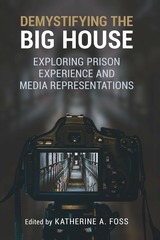 Demystifying the Big House: Exploring Prison Experience and Media Representations
Edited by Katherine A. Foss
Southern Illinois University Press, 2018 Essays in this volume illustrate how shows such as Orange Is the New Black and Oz impact the public’s perception of crime rates, the criminal justice system, and imprisonment. Contributors look at prison wives on reality television series, portrayals of death row, breastfeeding while in prison, transgender prisoners, and black masculinity. They also examine the ways in which media messages ignore an individual’s struggle against an all too frequently biased system and instead dehumanize the incarcerated as violent and overwhelmingly masculine. Together these essays argue media reform is necessary for penal reform, proposing that more accurate media representations of prison life could improve public support for programs dealing with poverty, abuse, and drug addiction—factors that increase the likelihood of criminal activity and incarceration.
Scholars from cultural and critical studies, feminist studies, queer studies, African American studies, media studies, sociology, and psychology offer critical analysis of media depictions of prison, bridging the media’s portrayals of incarcerated lives with actual experiences and bringing to light forgotten voices in prison narratives.
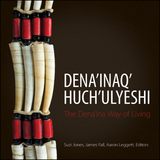 Dena'inaq' Huch'ulyeshi: The Dena'ina Way of Living
Edited by Suzi Jones, James Fall, and Aaron Leggett
University of Alaska Press, 2013 The range of the Dena’ina people stretches from the Cook Inlet region to southcentral Alaska and has been established for a thousand years. Yet their culture has largely been overlooked, leaving large gaps in the literature. Dena’inaq’ Huch’ulyeshi, a new catalog of Dena’ina materials, is an ambitious project that finally brings their culture to light. Lavishly illustrated with more than six hundred photographs, maps, and drawings, Dena’inaq’ Huch’ulyeshi contains 469 entries on Dena’ina objects in European and American collections. It is enriched with examples of traditional Dena’ina narratives, first-person accounts, and interviews. Thirteen essays on the history and culture of the Athabascan people put the pieces into a larger historical context. This catalog is a comprehensive reference that will also accompany a large-scale exhibition running September 2013 through January 2014 at the Anchorage Museum.
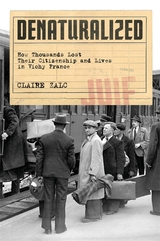 Denaturalized: How Thousands Lost Their Citizenship and Lives in Vichy France
Claire Zalc
Harvard University Press, 2020 “In Denaturalized, Claire Zalc combines the precision of the scholar with the passion of a storyteller…This is a deftly written book. Zalc combines in an accessible style (smoothly translated by Catherine Porter) the stories of people trapped within a bureaucracy that was as obsessed, perhaps, with clearing files as with hunting Jews. In other words, Zalc reminds us how cruel the banality of indifference could be.”—Wall Street Journal
Winner of the Prix d’histoire de la justice
A leading historian radically revises our understanding of the fate of Jews under the Vichy regime.
Thousands of naturalized French men and women had their citizenship revoked by the Vichy government during the Second World War. Once denaturalized, these men and women, mostly Jews who were later sent to concentration camps, ceased being French on official records and walked off the pages of history. As a result, we have for decades severely underestimated the number of French Jews murdered by Nazis during the Holocaust. In Denaturalized, Claire Zalc unearths this tragic record and rewrites World War II history.
At its core, this is a detective story. How do we trace a citizen made alien by the law? How do we solve a murder when the body has vanished? Faced with the absence of straightforward evidence, Zalc turned to the original naturalization papers in order to uncover how denaturalization later occurred. She discovered that, in many cases, the very officials who granted citizenship to foreigners before 1940 were the ones who retracted it under Vichy rule.
The idea of citizenship has always existed alongside the threat of its revocation, and this is especially true for those who are naturalized citizens of a modern state. At a time when the status of millions of naturalized citizens in the United States and around the world is under greater scrutiny, Denaturalized turns our attention to the precariousness of the naturalized experience—the darkness that can befall those who suddenly find themselves legally cast out.
 Denazification in Soviet-Occupied Germany: Brandenburg, 1945–1948
Timothy R. Vogt
Harvard University Press, 2000 In his study of Brandenburg, Germany, Timothy Vogt directly challenges both the "antifascist" paradigm employed by East German historians and the "sovietization" interpretive model that has dominated western studies. He argues that Soviet denazification was neither an effective purge of society nor part of a methodical "sovietization" of the eastern zone. Instead, in a detailed study, denazification is pictured as a failure, which fell short of its goals and was eventually abandoned by the frustrated Soviet and German leadership.The case example of Brandenburg is an effective means of putting "flesh and blood" into the study and giving the reader insight into both broader developments and the human actors who propelled events. The result is an analysis that is based not simply on policymakers and their policies, but rather on how policy was continuously reformulated in response to developments on the local level.
The study encompasses significant aspects of contemporary European history: everyday life in Nazi Germany, Germany's postwar coming to terms with its Nazi past, the Cold War division of Germany, postwar Soviet policy, and the construction of a one-party communist system in Eastern Europe.
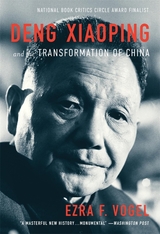 Deng Xiaoping and the Transformation of China
Ezra F. Vogel
Harvard University Press, 2011 Winner of the Lionel Gelber Prize
National Book Critics Circle Award Finalist
An Economist Best Book of the Year | A Financial Times Book of the Year | A Wall Street Journal Book of the Year | A Washington Post Book of the Year | A Bloomberg News Book of the Year | An Esquire China Book of the Year | A Gates Notes Top Read of the Year
Perhaps no one in the twentieth century had a greater long-term impact on world history than Deng Xiaoping. And no scholar of contemporary East Asian history and culture is better qualified than Ezra Vogel to disentangle the many contradictions embodied in the life and legacy of China’s boldest strategist.
Once described by Mao Zedong as a “needle inside a ball of cotton,” Deng was the pragmatic yet disciplined driving force behind China’s radical transformation in the late twentieth century. He confronted the damage wrought by the Cultural Revolution, dissolved Mao’s cult of personality, and loosened the economic and social policies that had stunted China’s growth. Obsessed with modernization and technology, Deng opened trade relations with the West, which lifted hundreds of millions of his countrymen out of poverty. Yet at the same time he answered to his authoritarian roots, most notably when he ordered the crackdown in June 1989 at Tiananmen Square.
Deng’s youthful commitment to the Communist Party was cemented in Paris in the early 1920s, among a group of Chinese student-workers that also included Zhou Enlai. Deng returned home in 1927 to join the Chinese Revolution on the ground floor. In the fifty years of his tumultuous rise to power, he endured accusations, purges, and even exile before becoming China’s preeminent leader from 1978 to 1989 and again in 1992. When he reached the top, Deng saw an opportunity to creatively destroy much of the economic system he had helped build for five decades as a loyal follower of Mao—and he did not hesitate.
 Denial and Repression of Anti-Semitism: Post-Communist Rehabilitation of the Serbian Bishop Nikolaj Velimirovic
Jovan Byford
Central European University Press, 2008 Bishop Nikolaj Velimirovic (1881–1956) is arguably one the most controversial figures in contemporary Serbian national culture. Having been vilified by the former Yugoslav Communist authorities as a fascist and an antisemite, this Orthodox Christian thinker has over the past two decades come to be regarded in Serbian society as the most important religious person since medieval times and an embodiment of the authentic Serbian national spirit. Velimirovic was formally canonised by the Serbian Orthodox Church in 2003. In this book, Jovan Byford charts the posthumous transformation of Velimirovic from 'traitor' to 'saint' and examines the dynamics of repression and denial that were used to divert public attention from the controversies surrounding the bishop's life, the most important of which is his antisemitism. Byford offers the first detailed examination of the way in which an Eastern Orthodox Church manages controversy surrounding the presence of antisemitism within its ranks and he considers the implications of the continuing reverence of Nikolaj Velimirovic for the persistence of antisemitism in Serbian Orthodox culture and in Serbian society as a whole. This book is based on a detailed examination of the changing representation of Bishop Nikolaj Velimirovic in the Serbian media and in commemorative discourse devoted to him. The book also makes extensive use of exclusive interviews with a number of Serbian public figures who have been actively involved in the bishop’s rehabilitation over the past two decades.
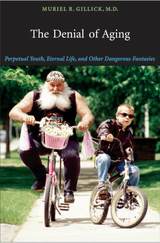 The Denial of Aging: Perpetual Youth, Eternal Life, and Other Dangerous Fantasies
Muriel R. Gillick M.D.
Harvard University Press, 2006 You’ve argued politics with your aunt since high school, but failing eyesight now prevents her from keeping current with the newspaper. Your mother fractured her hip last year and is confined to a wheelchair. Your father has Alzheimer’s and only occasionally recognizes you. Someday, as Muriel Gillick points out in this important yet unsettling book, you too will be old. And no matter what vitamin regimen you’re on now, you will likely one day find yourself sick or frail. How do you prepare? What will you need?
With passion and compassion, Gillick chronicles the stories of elders who have struggled with housing options, with medical care decisions, and with finding meaning in life. Skillfully incorporating insights from medicine, health policy, and economics, she lays out action plans for individuals and for communities. In addition to doing all we can to maintain our health, we must vote and organize—for housing choices that consider autonomy as well as safety, for employment that utilizes the skills and wisdom of the elderly, and for better management of disability and chronic disease.
Most provocatively, Gillick argues against desperate attempts to cure the incurable. Care should focus on quality of life, not whether it can be prolonged at any cost. “A good old age,” writes Gillick, “is within our grasp.” But we must reach in the right direction.
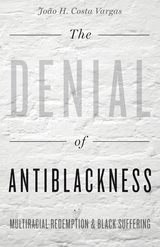 The Denial of Antiblackness: Multiracial Redemption and Black Suffering
João H. Costa Vargas
University of Minnesota Press, 2018 An incisive new look at the black diaspora, examining the true roots of antiblackness and its destructive effects on all of society
Thanks to movements like Black Lives Matter, Western society’s chronic discrimination against black individuals has become front-page news. Yet, there is little awareness of the systemic factors that make such a distinct form of dehumanization possible. In both the United States and Brazil—two leading nations of the black diaspora—a very necessary acknowledgment of black suffering is nonetheless undercut by denial of the pervasive antiblackness that still exists throughout these societies. In The Denial of Antiblackness, João H. Costa Vargas examines how antiblackness affects society as a whole through analyses of recent protests against police killings of black individuals in both the United States and Brazil, as well as the everyday dynamics of incarceration, residential segregation, and poverty. With multisite ethnography ranging from a juvenile prison in Austin, Texas, to grassroots organizing in Los Angeles and Black social movements in Brazil, Vargas finds the common factors that have perpetuated antiblackness, regardless of context. Ultimately, he asks why the denial of antiblackness persists, whom this narrative serves, and what political realities it makes possible.
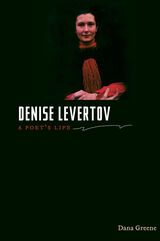 Denise Levertov: A Poet's Life
Dana Greene
University of Illinois Press, 2014 Kenneth Rexroth called Denise Levertov (1923–1997) "the most subtly skillful poet of her generation, the most profound, . . . and the most moving." Author of twenty-four volumes of poetry, four books of essays, and several translations, Levertov became a lauded and honored poet. Born in England, she published her first book of poems at age twenty-three, but it was not until she married and came to the United States in 1948 that she found her poetic voice, helped by the likes of William Carlos Williams, Robert Duncan, and Robert Creeley. Shortly before her death in 1997, the woman who claimed no country as home was nominated to be America's poet laureate. Levertov was the quintessential romantic. She wanted to live vividly, intensely, passionately, and on a grand scale. She wanted the persistence of Cézanne and the depth and generosity of Rilke. Once she acclimated herself to America, the dreamy lyric poetry of her early years gave way to the joy and wonder of ordinary life. By the late 1960s and early 1970s, however, her poems began to engage the issues of her times. Vehement and strident, her poetry of protest was both acclaimed and criticized. The end of both the Vietnam War and her marriage left her mentally fatigued and emotionally fragile, but gradually, over the span of a decade, she emerged with new energy. The crystalline and luminous poetry of her last years stands as final witness to a lifetime of searching for the mystery embedded in life itself. Through all the vagaries of life and art, her response was that of a "primary wonder." In this illuminating biography, Dana Greene examines Levertov's interviews, essays, and self-revelatory poetry to discern the conflict and torment she both endured and created in her attempts to deal with her own psyche, her relationships with family, friends, lovers, colleagues, and the times in which she lived. Denise Levertov: A Poet's Life is the first complete biography of Levertov, a woman who claimed she did not want a biography, insisting that it was her work that she hoped would endure. And yet she confessed that her poetry in its various forms--lyric, political, natural, and religious--derived from her life experience. Although a substantial body of criticism has established Levertov as a major poet of the later twentieth century, this volume represents the first attempt to set her poetry within the framework of her often tumultuous life.
Denise Levertov: Selected Criticism
Edited with an Introduction by Albert Gelpi
University of Michigan Press, 1993 Illuminating reflections on the achievements of poet Denise Levertov
 Dental Ethics at Chairside: Professional Obligations and Practical Applications, Third Edition
David T. Ozar, David J. Sokol, and Donald E. Patthoff
Georgetown University Press, 2023 In the last two decades, more than ever before dentists must determine how to properly maintain their focus on ethics and professionalism in the face of powerful commercial pressures. While there is encouragement for ethical conduct within the dental profession, there is still relatively little assistance available to dentists and dental students for judging what conduct is ethically best in concrete situations. For many years, Dental Ethics at Chairside has served as an invaluable resource for tens of thousands of dentists and dentistry students, and this third edition of the gold standard in the field is thoroughly revised and updated. In addition to exploring ongoing and critical issues such as the patient-professional relationship, patients with compromised capacity, confidentiality, justice and the inadequacies of society's health care systems, and dentistry as a business, the third edition addresses emerging ethical issues related to conflicts of interest, dental professionalism, advertising and social media, the serious indebtedness of graduating dental students, bad outcomes and bad work, the explosion of aesthetic dentistry, acquiring new skills and new technology, the impact of the market on the professional-patient relationship, and many others. The book includes fourteen realistic cases and commentary about dilemmas in dentistry, as well as online resources for further research and study.
 Dental Ethics at Chairside: Professional Principles and Practical Applications, Second Edition
David T. Ozar and David J. Sokol
Georgetown University Press, 2002 Every health care practitioner from Hippocrates to our own day has had to deal with questions of ethics in the effort to serve patients properly and well. The dental professional is no different. For nearly a decade, it has had sound ethical reflection on its side in the form of Dental Ethics at Chairside. In issues ranging from ordinary chairside decision making to HIV/AIDS and ethical business practices, the first edition of this book has guided thousands of dentists, dental hygienists, students, and other oral health care practitioners to an understanding of the essential practice of ethics. Now a revised, updated, and expanded edition of Dental Ethics at Chairside responds to the challenges of oral health care in the new century with chapters on managed care, confidentiality and electronic record-keeping, among other important topics.
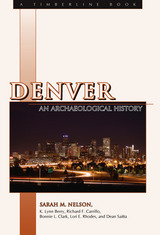 Denver: An Archaeological History
Sarah M. Nelson
University Press of Colorado, 2008 A vivid account of the prehistory and history of Denver as revealed in its archaeological record, Denver: An Archaeological History invites us to imagine Denver as it once was. Around 12,000 B.C., groups of leather-clad Paleoindians passed through the juncture of the South Platte River and Cherry Creek, following the herds of mammoth or buffalo they hunted. In the Archaic period, people rested under the shade of trees along the riverbanks, with baskets full of plums as they waited for rabbits to be caught in their nearby snares. In the early Ceramic period, a group of mourners adorned with yellow pigment on their faces and beads of eagle bone followed Cherry Creek to the South Platte to attend a funeral at a neighboring village. And in 1858, the area was populated by the crude cottonwood log shacks with dirt floors and glassless windows, the homes of Denver's first inhabitants. For at least 10,000 years, Greater Denver has been a collection of diverse lifeways and survival strategies, a crossroads of interaction, and a locus of cultural coexistence. Setting the scene with detailed descriptions of the natural environment, summaries of prehistoric sites, and archaeologists' knowledge of Denver's early inhabitants, Nelson and her colleagues bring the region's history to life. From prehistory to the present, this is a compelling narrative of Denver's cultural heritage that will fascinate lay readers, amateur archaeologists, professional archaeologists, and academic historians alike.
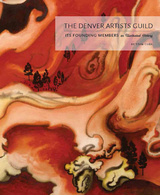 The Denver Artists Guild: Its Founding Members; An Illustrated History
Stan Cuba
University Press of Colorado, 2015 In 1928, the newly organized Denver Artists Guild held its inaugural exhibition in downtown Denver. Little did the participants realize that their initial effort would survive the Great Depression and World War II—and then outlive all of the group’s fifty-two charter members.
The guild’s founders worked in many media and pursued a variety of styles. In addition to the oils and watercolors one would expect were masterful pastels by Elsie Haddon Haynes, photographs by Laura Gilpin, sculpture by Gladys Caldwell Fisher and Arnold Rönnebeck, ceramics by Anne Van Briggle Ritter and Paul St. Gaudens, and collages by Pansy Stockton. Styles included realism, impressionism, regionalism, surrealism, and abstraction. Murals by Allen True, Vance Kirkland, John E. Thompson, Louise Ronnebeck, and others graced public and private buildings—secular and religious—in Colorado and throughout the United States. The guild’s artists didn’t just contribute to the fine and decorative arts of Colorado; they enhanced the national reputation of the state.
Then, in 1948, the Denver Artists Guild became the stage for a great public debate pitting traditional against modern. The twenty-year-old guild split apart as modernists bolted to form their own group, the Fifteen Colorado Artists. It was a seminal moment: some of the guild’s artists became great modernists, while others remained great traditionalists.
Enhanced by period photographs and reproductions of the founding members’ works, The Denver Artists Guild chronicles a vibrant yet overlooked chapter of Colorado’s cultural history. The book includes a walking tour of guild members’ paintings and sculptures viewable in Denver and elsewhere in Colorado, by Leah Naess and author Stan Cuba.
In honor of the book’s release, the Byers-Evans House Gallery will showcase a collection of founding guild members’ works starting June 26, 2015. The exhibit, also titled The Denver Artists Guild: Its Founding Members, contains paintings from artists such as the famed Paschal Quackenbush, Louise Ronnebeck, Albert Byron Olson, Elisabeth Spalding, Waldo Love and Vance Kirkland. The show will be on display through September 26, 2015.
 Denver In Slices: A Historical Guide to the City
Louisa Ward Arps
Ohio University Press, 1983 The Old West has been viewed from many perspectives, from the scornful to the uncritically romantic. But seldom has it been treated with the honest nostalgia of the wonderful accounts and pictures gathered in Denver in Slices.
Ohio University Press/Swallow Press is proud to reissue this Western classic, which includes a brief survey of all Denver history, some slices depicting the most fascinating places and characters. The City Ditch, Cherry Creek, River Front Park, the Denver Mint, the Tabors, the Windsor Hotel, the Baron of Montclair, Overland Park, Buffalo Bill, Elitch's Gardens, and Eugene Field—they're all here. Illustrating these stories is an array of nearly one hundred pictures of the people, buildings, and street scenes: a fascinating panorama of the gold rush camp that became the Rocky Mountain metropolis.
With a new foreword by renowned Denver historian Thomas J. Noel, this classic will once again help preserve Denver's lively past.
 Denver Inside and Out
Jeanne E. Colorado Historical Society
University Press of Colorado, 2011 Denver turned 150 just a few years ago--not too shabby for a city so down on its luck in 1868 that Cheyenne boosters deemed it "too dead to bury." Still, most of the city's history is a recent memory: Denver's entire story spans just two human lifetimes. In Denver Inside and Out, eleven authors illustrate how pioneers built enduring educational, medical, and transportation systems; how Denver's social and political climate contributed to the elevation of women; how Denver residents wrestled with-and exploited-the city's natural features; and how diverse cultural groups became an essential part of the city's fabric. By showing how the city rose far above its humble roots, the authors illuminate the many ways that Denver residents have never stopped imagining a great city. Published in time for the opening of the new History Colorado Center in Denver in 2012, Denver Inside and Out hints at some of the social, economic, legal, and environmental issues that Denverites will have to consider over the next 150 years. Finalist for the 2012 Colorado Book Awards
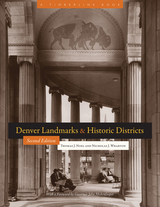 Denver Landmarks and Historic Districts
Thomas J. Noel
University Press of Colorado, 2016 A Timberline Book
Denver Landmarks and Historic Districts, Second Edition is the newest, most thorough guide to Denver’s 51 historic districts and more than 331 individually landmarked properties. This lavishly illustrated volume celebrates Denver’s oldest banks, churches, clubs, hotels, libraries, schools, restaurants, mansions, and show homes.
Denver is unusually fortunate to retain much of its significant architectural heritage. The Denver Landmark Preservation Commission (1967), Historic Denver, Inc. (1970), Colorado Preservation, Inc. (1984), and History Colorado (1879) have all worked to identify and preserve Denver buildings notable for architectural, geographical, or historical significance. Since the 1970s, Denver has designated more landmarks than any other US city of comparable size. Many of these landmarks, both well-known and obscure, are open to the public. These landmarks and districts have helped make Denver one of the healthiest and most attractive core cities in the United States, transforming what was once Skid Row into the Lower Downtown Historic District of million-dollar lofts and $7 craft beers.
Entries include the Daniels & Fisher Tower, the Brown Palace Hotel, Red Rocks Outdoor Amphitheatre, Elitch Theatre, Fire Station No. 7, the Richthofen Castle, the Washington Park Boathouse and Pavilion, and the Capitol Hill, Five Points, and Highlands historic districts. Denver Landmarks and Historic Districts highlights the many officially designated buildings and neighborhoods of note. This crisply written guide serves as a great starting point for rubbernecking around Denver, whether by motor vehicle, by bicycle, or afoot.
 Denver: Mining Camp to Metropolis
Stephen J. Leonard
University Press of Colorado, 1990 This lively best seller by leading Colorado historians Steve Leonard and Tom Noel is the most comprehensive survey ever written of the Mile High metropolis. Informative and richly illustrated, Denver covers the developing region from the mountain towns of Boulder and Jefferson counties to the High Plains settlements of Adams and Arapahoe counties, with more than two-thirds of the book devoted to the burgeoning five-county region since 1900. In retelling the tale of conquest and city building, the authors explore the role of previously neglected peoples--notably women, ethnic minorities, and the working class--while weaving several key themes throughout the book: Denver's persistent reliance on natural resources, the important role of transportation to overcome the city's isolation, and the city's emphasis on privatization rather than on the public, common good. Denver: Mining Camp to Metropolis will fascinate and educated students and scholars, as well as all readers curious about the boom-and-bust metropolis of the Rockies.
 Denver's Lakeside Amusement Park: From the White City Beautiful to a Century of Fun
David Forsyth
University Press of Colorado, 2016 Denver's Lakeside Amusement Park details the history of Lakeside, exploring how it has managed to remain in business for more than a century (something less than thirty amusement parks have accomplished), and offers a unique view on larger changes in society and the amusement park industry itself.
Once nicknamed White City in part for its glittering display of more than 100,000 lights, the park opened in 1908 in conjunction with Denver's participation in the national City Beautiful movement. It was a park for Denver elites, with fifty different forms of amusement, including the Lakeshore Railway and the Velvet Coaster, a casino, a ballroom, a theater, a skating rink, and avenues decorated with Greek statues. But after metropolitan growth, technological innovation, and cultural shifts in Denver, it began to cater to a working-class demographic as well. Additions of neon and fluorescent lighting, roller coasters like the Wild Chipmunk, attractions like the Fun House and Lakeside Speedway, and rides like the Scrambler, the Spider, and most recently the drop tower Zoom changed the face and feel of Lakeside between 1908 and 2008. The park also has weathered numerous financial and structural difficulties but continues to provide Denverites with affordable, family-friendly amusement today.
To tell Lakeside's story, Forsyth makes use of various primary and secondary sources, including Denver newspapers, Denver's official City Beautiful publication Municipal Facts, Billboard magazine, and interviews with people connected to the park throughout its history. Denver's Lakeside Amusement Park is an important addition to Denver history that will appeal to anyone interested in Colorado history, urban history, entertainment history, and popular culture, as well as to amusement park aficionados.
Denying Flight: Strategic Options for Employing No-Fly Zones
Karl P. Mueller
RAND Corporation, 2013 In the past two decades, the U.S. Air Force has participated in three contingencies involving no-fly zones (NFZs) over Bosnia, Iraq, and Libya, and NFZ proposals have been proffered for some time as an option for intervention in the Syrian civil war that would avoid placing Western troops on the ground. This paper is intended as a preliminary look at NFZs as a strategic approach in such situations, with an emphasis on the forms they might take, their potential utility, and their probable limitations.
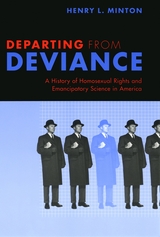 Departing from Deviance: A History of Homosexual Rights and Emancipatory Science in America
Henry L. Minton
University of Chicago Press, 2001 The struggle to remove the stigma of sickness surrounding same-sex love has a long history. In 1973, the American Psychiatric Association removed homosexuality from its diagnostic classification of mental illness, but the groundwork for this pivotal decision was laid decades earlier. In this new study, Henry L. Minton looks back at the struggle of the American gay and lesbian activists who chose scientific research as a path for advancing homosexual rights. He traces the history of gay and lesbian emancipatory research from its early beginnings in the late nineteenth century to its role in challenging the illness model in the 1970s. By examining archival sources and unpublished manuscripts, Minton reveals the substantial accomplishments made by key researchers and relates their life stories. He also considers the contributions of mainstream sexologists such as Alfred C. Kinsey and Evelyn Hooker, who supported the cause of homosexual rights through the advancement of scientific knowledge. By uncovering this hidden chapter in the story of gay liberation, Departing from Deviance makes an important contribution to both the history of science and the history of sexuality.
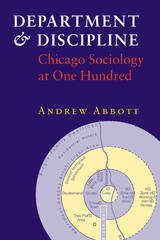 Department and Discipline: Chicago Sociology at One Hundred
Andrew Abbott
University of Chicago Press, 1999 In this detailed history of the Chicago School of Sociology, Andrew Abbott investigates central topics in the emergence of modern scholarship, paying special attention to "schools of science" and how such schools reproduce themselves over time. What are the preconditions from which schools arise? Do they exist as rigid rules or as flexible structures? How do they emerge from the day-to-day activities of academic life such as editing journals and writing papers?
Abbott analyzes the shifts in social scientific inquiry and discloses the intellectual rivalry and faculty politics that characterized different stages of the Chicago School. Along the way, he traces the rich history of the discipline's main journal, the American Journal of Sociology.
Embedded in this analysis of the school and its practices is a broader theoretical argument, which Abbott uses to redefine social objects as a sequence of interconnected events rather than as fixed entities. Abbott's theories grow directly out of the Chicago School's insistence that social life be located in time and place, a tradition that has been at the heart of the school since its founding one hundred years ago.
The Department of War, 1781–1795
Harry M. Ward
University of Pittsburgh Press, 1962 Harry M. Ward examines the formative years of the Department of War as a microcosm of the development of a centralized federal government. The Department of War was unique among early government agencies, as the only office that continued under the same administrator from the time of the Confederation to government under the Constitution. After the peace was established with Britain, citizens were suspicious of keeping a standing army, but administrator Benjamin Lincoln's efficient administration did much to dispel their fears. Henry Knox was the second Secretary, and he faced the problem of maintaining peace on the frontier, as his tiny army twice lost battles with Indians. It was only after the Whiskey Rebellion and Shay's Rebellion, that the young nation fully comprehended the importance of a maintaining a national military.
Departures
Jennifer Cornell
University of Pittsburgh Press, 1996 The stories in this extraordinary collection are set in Northern Ireland, specifically Belfast, the center for more than thirty years of fighting between Roman Catholic nationalists and Protestants loyal to the British crown. Cornell is not preoccupied, however, with the details of the war. Her stories explore the emotional and psychological consequences of the struggle to endure not only violence, but loss, failure, and the inability to believe.
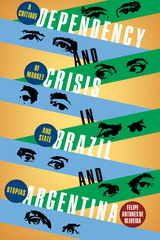 Dependency and Crisis in Brazil and Argentina: A Critique of Market and State Utopias
Felipe de Oliviera Antunes
University of Pittsburgh Press, 2024 In the two largest countries in South America, successive waves of structural reforms adopted in the name of development invariably have ended in disappointment. The promise of development never seems to materialize. Dependency and Crisis in Brazil and Argentina examines why. Instead of looking for policy failures, F. Antunes de Oliveira’s focus is on the parameters of the public debate about “development” itself. An unfruitful dispute between neoliberalism and neodevelopmentalism has dominated Brazilian and Argentine political economy debates to the detriment of both countries. Antunes de Oliveira presents a comprehensive theoretical and empirical critique of the neoliberal and neodevelopmentalist structural reform cycles in Brazil and Argentina and applies insights from dependency theory to craft an alternative political economy framework for the analysis of development challenges.
The Dependency Movement: Scholarship and Politics in Development Studies
Robert Packenham
Harvard University Press, 1992 In the first comprehensive scholarly treatment of dependency theory, Robert Packenham describes its origins, substantive claims, and methods. He analyzes the movement comparatively and sociologically as a significant episode in inter-American and North-South cultural relations. In his account, the positive intellectual contributions of dependency ideas, as well as their role in the costly politicization of U.S. scholarship, become evident and comprehensible.
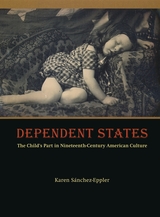 Dependent States: The Child's Part in Nineteenth-Century American Culture
Karen Sánchez-Eppler
University of Chicago Press, 2005 Because childhood is not only culturally but also legally and biologically understood as a period of dependency, it has been easy to dismiss children as historical actors. By putting children at the center of our thinking about American history, Karen Sánchez-Eppler recognizes the important part childhood played in nineteenth-century American culture and what this involvement entailed for children themselves.
Dependent States examines the ties between children's literacy training and the growing cultural prestige of the novel; the way children functioned rhetorically in reform literature to enforce social norms; the way the risks of death to children shored up emotional power in the home; how Sunday schools socialized children into racial, religious, and national identities; and how class identity was produced, not only in terms of work, but also in the way children played. For Sánchez-Eppler, nineteenth-century childhoods were nothing less than vehicles for national reform. Dependent on adults for their care, children did not conform to the ideals of enfranchisement and agency that we usually associate with historical actors. Yet through meticulously researched examples, Sánchez-Eppler reveals that children participated in the making of social meaning. Her focus on childhood as a dependent state thus offers a rewarding corrective to our notions of autonomous individualism and a new perspective on American culture itself.
The Depletion Myth: A History of Railroad Use of Timber
Sherry H. Olson
Harvard University Press, 1971 Sherry Olson traces the timber conversation issue over the full term of evolution of forestry consciousness in America, giving new prominence to the role of industrial consumers in adjusting the use pattern of a major resource. In its preoccupation with growing wood the Forest Service underestimated the ability of consumers to reduce their use of timber. Olson attributes this mistake to confusion of the economic facts of supply and demand with physical facts of production and consumption. This distinction, she believes, could be applied with profit to current problems of resource management.
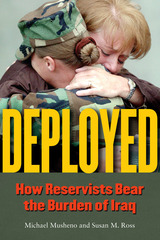 Deployed: How Reservists Bear the Burden of Iraq
Michael Musheno and Susan M. Ross
University of Michigan Press, 2008 "Deployed is an important and deeply moving book. Here, in this story, the heroic tradition of the American citizen-soldier lives on."
---Andrew J. Bacevich, Professor, Boston University, and author of The New American Militarism: How Americans Are Seduced by War "Whatever your feelings about Iraq, Deployed is an important and compelling work that illuminates the real human cost of the war, and gives voice to those compelled to fight it."
---Ken Wells, Senior Editor, Condé Nast Portfolio "Currently, there are few to no books dealing with the sociology of Iraq, and even fewer have empirical data on the experiences of American soldiers. More important, this work provides a strong and needed voice for soldiers---their words are compelling, rich, and moving."
---Morten Ender, Professor of Sociology, United States Military Academy at West Point "This is a unique book that weaves historical, ethnographic, and organizational approaches for a study of Iraq-War military reservists. . . . the authors' findings challenge the pervading wisdom on reservists' motivations for service; the chemistry between family, reserve duty, and relations with regular military; and the effect that service in Iraq had on them."
---Jerry Lembcke, Associate Professor of Sociology, Holy Cross College What is it like to be one of the citizen-soldiers summoned to duty in Iraq and Afghanistan? The events of 9/11 were a call to arms for many reservists, as shock, anger, and fear propelled large numbers to volunteer for the opportunity to serve their country in the Middle East. Even the most patriotic, however, had not expected that the wars would last so long or that the Army Reserve would supply so much of the manpower. Using the soldiers' own voices, Deployed draws upon the life stories of members of an Army Reserve MP Company, who were called to extraordinary service after September 11. The book explores how and why they joined the Army Reserve, how they dealt with the seismic changes in their lives during and after deployment, the evolution of their relationships inside and outside their military unit, and their perspectives on the U.S. Army. Musheno and Ross uncover five pathways that led these citizens to join the reserves, showing how basic needs and cultural idioms combined to stimulate enlistments. Whatever path led to enlistment, the authors find that citizen-soldiers fall into three distinct categories: adaptive reservists who adjust quickly to the huge changes in their lives abroad and at home, struggling reservists whose troubles are more a product of homegrown circumstances than experiences specific to serving in a war zone, and reservists who are dismissive of military life while they live it and oppose the war even as they fight it. Perhaps most important, Deployed challenges the prevailing stereotype of returning soldiers as war-damaged citizens. Jacket photograph: AP Photo/Hutchinson News, Travis Morisse.
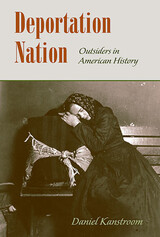 Deportation Nation: Outsiders in American History
Daniel Kanstroom
Harvard University Press, 2007 The danger of deportation hangs over the head of virtually every noncitizen in the United States. In the complexities and inconsistencies of immigration law, one can find a reason to deport almost any noncitizen at almost any time. In recent years, the system has been used with unprecedented vigor against millions of deportees.
We are a nation of immigrants--but which ones do we want, and what do we do with those that we don't? These questions have troubled American law and politics since colonial times.
Deportation Nation is a chilling history of communal self-idealization and self-protection. The post-Revolutionary Alien and Sedition Laws, the Fugitive Slave laws, the Indian "removals," the Chinese Exclusion Act, the Palmer Raids, the internment of the Japanese Americans--all sought to remove those whose origins suggested they could never become "true" Americans. And for more than a century, millions of Mexicans have conveniently served as cheap labor, crossing a border that was not official until the early twentieth century and being sent back across it when they became a burden.
By illuminating the shadowy corners of American history, Daniel Kanstroom shows that deportation has long been a legal tool to control immigrants' lives and is used with increasing crudeness in a globalized but xenophobic world.
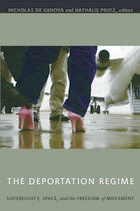 The Deportation Regime: Sovereignty, Space, and the Freedom of Movement
Nicholas De Genova and Nathalie Peutz, eds.
Duke University Press, 2010 This important collection examines deportation as an increasingly global mechanism of state control. Anthropologists, historians, legal scholars, and sociologists consider not only the physical expulsion of noncitizens but also the social discipline and labor subordination resulting from deportability, the threat of forced removal. They explore practices and experiences of deportation in regional and national settings from the U.S.-Mexico border to Israel, and from Somalia to Switzerland. They also address broader questions, including the ontological significance of freedom of movement; the historical antecedents of deportation, such as banishment and exile; and the development, entrenchment, and consequences of organizing sovereign power and framing individual rights by territory. Whether investigating the power that individual and corporate sponsors have over the fate of foreign laborers in Bahrain, the implications of Germany’s temporary suspension of deportation orders for pregnant and ill migrants, or the significance of the detention camp, the contributors reveal how deportation reflects and reproduces notions about public health, racial purity, and class privilege. They also provide insight into how deportation and deportability are experienced by individuals, including Arabs, South Asians, and Muslims in the United States. One contributor looks at asylum claims in light of an unusual anti-deportation campaign mounted by Algerian refugees in Montreal; others analyze the European Union as an entity specifically dedicated to governing mobility inside and across its official borders. The Deportation Regime addresses urgent issues related to human rights, international migration, and the extensive security measures implemented by nation-states since September 11, 2001. Contributors: Rutvica Andrijasevic, Aashti Bhartia, Heide Castañeda , Galina Cornelisse , Susan Bibler Coutin, Nicholas De Genova, Andrew M. Gardner, Josiah Heyman, Serhat Karakayali, Sunaina Marr Maira, Guillermina Gina Nuñez, Peter Nyers, Nathalie Peutz, Enrica Rigo, Victor Talavera, William Walters, Hans-Rudolf Wicker, Sarah S. Willen
 Deported Americans: Life after Deportation to Mexico
Beth Caldwell
Duke University Press, 2019 When Gina was deported to Tijuana, Mexico, in 2011, she left behind her parents, siblings, and children, all of whom are U.S. citizens. Despite having once had a green card, Gina was removed from the only country she had ever known. In Deported Americans legal scholar and former public defender Beth C. Caldwell tells Gina's story alongside those of dozens of other Dreamers, who are among the hundreds of thousands who have been deported to Mexico in recent years. Many of them had lawful status, held green cards, or served in the U.S. military. Now, they have been banished, many with no hope of lawfully returning. Having interviewed over one hundred deportees and their families, Caldwell traces deportation's long-term consequences—such as depression, drug use, and homelessness—on both sides of the border. Showing how U.S. deportation law systematically fails to protect the rights of immigrants and their families, Caldwell challenges traditional notions of what it means to be an American and recommends legislative and judicial reforms to mitigate the injustices suffered by the millions of U.S. citizens affected by deportation.
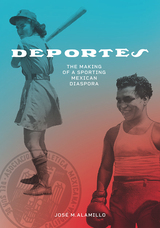 Deportes: The Making of a Sporting Mexican Diaspora
José M Alamillo
Rutgers University Press, 2020 Spanning the first half of the twentieth century, Deportes uncovers the hidden experiences of Mexican male and female athletes, teams and leagues and their supporters who fought for a more level playing field on both sides of the border. Despite a widespread belief that Mexicans shunned physical exercise, teamwork or “good sportsmanship,” they proved that they could compete in a wide variety of sports at amateur, semiprofessional, Olympic and professional levels. Some even made their mark in the sports world by becoming the “first” Mexican athlete to reach the big leagues and win Olympic medals or world boxing and tennis titles.
These sporting achievements were not theirs alone, an entire cadre of supporters—families, friends, coaches, managers, promoters, sportswriters, and fans—rallied around them and celebrated their athletic success. The Mexican nation and community, at home or abroad, elevated Mexican athletes to sports hero status with a deep sense of cultural and national pride. Alamillo argues that Mexican-origin males and females in the United States used sports to empower themselves and their community by developing and sustaining transnational networks with Mexico. Ultimately, these athletes and their supporters created a “sporting Mexican diaspora” that overcame economic barriers, challenged racial and gender assumptions, forged sporting networks across borders, developed new hybrid identities and raised awareness about civil rights within and beyond the sporting world.
The Deposition
Pete Duval
University of Massachusetts Press, 2021 An insurance lawyer driving across Iowa engages a wounded, hitchhiking priest in a metaphysical debate. A vacationing air traffic controller with a penchant for Saint Francis of Assisi is bitten by an ancient parrot. The Marxist owner of a Florida curiosity shop confronts a local church community's rising anger over a jarred fetus, while a fasting husband of an evangelical minister holds bloody communion with the leader of a suburban coyote pack and a Catholic cable news cameraman tracks a missing stigmatist through a Caribbean port city. As cosmic struggles play out against the backdrop of forgotten strip malls, suburban cul-de-sacs, and grimy cities, guidance comes from the unlikeliest of sources. In prose both dreamlike and vivid, the characters in Pete Duval's second collection navigate paths through a landscape of vestigial faith and nagging doubt.
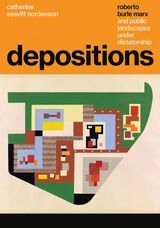 Depositions: Roberto Burle Marx and Public Landscapes under Dictatorship
By Catherine Seavitt Nordenson
University of Texas Press, 2018 Recipient of 2019 John Brinckerhoff Jackson Book Prize, Foundation for Landscape Studies
2021 On the Brinck Book Award Winner “Burle Marx created a new and modern grammar for international landscape design.”
—Lauro Cavalcanti, quoted in the New York Times “The real creator of the modern garden.”
—American Institute of Architects Presenting the first English translation of Burle Marx’s “depositions,” this volume highlights the environmental advocacy of a preeminent Brazilian landscape architect who advised and challenged the country’s military dictatorship.
Roberto Burle Marx (1909–1994) is internationally known as one of the preeminent modernist landscape architects. He designed renowned public landscapes in Brazil, beginning with small plazas in Recife in the 1930s and culminating with large public parks in the early 1960s, most significantly the Parque do Flamengo in Rio de Janeiro. Depositions explores a pivotal moment in Burle Marx’s career—the years in which he served as a member of the Federal Cultural Council created by the military dictatorship in the mid-1960s. Despite the inherent conflict and risk in working with the military regime, Burle Marx boldly used his position to advocate for the protection of the unique Brazilian landscape, becoming a prophetic voice of caution against the regime’s policies of rapid development and resource exploitation. Depositions presents the first English translation of eighteen environmental position pieces that Burle Marx wrote for the journal Cultura , a publication of the Brazilian Ministry of Education and Culture, from 1967 through 1973. Catherine Seavitt Nordenson introduces and contextualizes the depositions by analyzing their historical and political contexts, as well as by presenting pertinent examples of Burle Marx’s earlier public projects, which enables a comprehensive reading of the texts. Addressing deforestation, the establishment of national parks, the place of commemorative sculpture, and the unique history of the Brazilian cultural landscape, Depositions offers new insight into Burle Marx’s outstanding landscape oeuvre and elucidates his transition from prolific designer to prescient counselor.
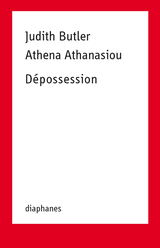 Dépossession
Athena Athanasiou and Judith Butler
Diaphanes, 2016 Dialogue entre Judith Butler et Athena Athanasiou : le débat tourne autour de ceux qui ont perdu leur pays, leur nationalité, leurs biens, tous ceux qui ont été expropriés de leur appartenance au monde. Que signifie cette précarité, cette perte fondamentale, dans une société capitaliste dominée par la logique de la possession ? Est-ce que cette conscience d’expropriation peut amener à une nouvelle forme de résistance, apporter une réponse politique à ceux qui ont été déchus de leurs droits, de leurs biens, en un mot, des conditions de base de la vie elle-même ?
Les soulèvements révolutionnaires au Moyen-Orient et au Maghreb, comme les manifestations sur la place Puerta del Sol, la place Syntagma et le parc Zucotti établissent une nouvelle économie politique et affective du corps dans l’espace public. La rue est l’endroit par excellence des expropriés — de ceux qui défient les forces de police et qui se regroupent spontanément dans des collectifs pour lever la voix, pour être vus et entendus. Le livre offre une introduction à la complexité des nouvelles formes de privation de droits, de dépossession et de contestation politique. Une réflexion sur la puissance du perfomatif ainsi que sur la perte de pouvoir du sujet souverain et moral classique.
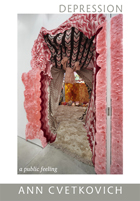 Depression: A Public Feeling
Ann Cvetkovich
Duke University Press, 2012 In Depression: A Public Feeling, Ann Cvetkovich combines memoir and critical essay in search of ways of writing about depression as a cultural and political phenomenon that offer alternatives to medical models. She describes her own experience of the professional pressures, creative anxiety, and political hopelessness that led to intellectual blockage while she was finishing her dissertation and writing her first book. Building on the insights of the memoir, in the critical essay she considers the idea that feeling bad constitutes the lived experience of neoliberal capitalism. Cvetkovich draws on an unusual archive, including accounts of early Christian acedia and spiritual despair, texts connecting the histories of slavery and colonialism with their violent present-day legacies, and utopian spaces created from lesbian feminist practices of crafting. She herself seeks to craft a queer cultural analysis that accounts for depression as a historical category, a felt experience, and a point of entry into discussions about theory, contemporary culture, and everyday life. Depression: A Public Feeling suggests that utopian visions can reside in daily habits and practices, such as writing and yoga, and it highlights the centrality of somatic and felt experience to political activism and social transformation.
Depression and Older People: Towards Securing Well-being in Later Life
Mary Godfrey and Tracy Denby
Bristol University Press, 2004 The literature on depression in old age has tended to be dominated by the medical model with its focus on symptoms and treatment. This report breaks new ground by adopting a psycho-social approach - one that explores depression in the context of the everyday lives of older people. Commissioned by Help the Aged, the report reviews the nature and scope of the evidence base around depression and older people; evaluates current policy and practice responses and identifies gaps in the evidence base and areas for further work. Depression and older people is invaluable reading for anyone involved in the management and delivery of services to older people, as well as academics, students and researchers in the field. It will also be of interest to older people themselves.
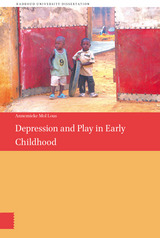 Depression and Play in Early Childhood
Annemieke Mol Lous
Amsterdam University Press, 2015 Depression in early childhood is an underestimated health problem which is known for its severity, endurance, and negative impact on the quality of life of children and their families. The lack of appropriate assessment procedures hinders early identification and therefore the possibilities for intervention and prevention. This dissertation includes three studies about markers of depression in play behavior of young children and the possibilities to use play observation procedures as an assessment tool for early identification of depression in 3- to 6-year old children. In the first two studies, depressed and nondepressed preschoolers were observed in a standardized play procedure including solitary free play, interactive free play, and play narratives with an adult researcher. Depressed children showed less play, and particularly less symbolic play than non-depressed children, and also more fragmented play behavior. This was most visible in play narratives, where induction of sad emotions had a severe dampening effect on depressed children's symbolic play. The third and last study shows that preschool teachers can use a play observation questionnaire, based on the outcomes of the observational studies, to recognize these markers of depression in children's everyday play behavior in the classroom. The findings of these studies offer new insights in the relationship between play and depression and the emotion regulation problems that negatively affect depressed children's play.
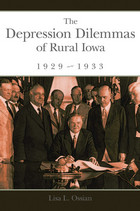 The Depression Dilemmas of Rural Iowa, 1929-1933
Lisa L. Ossian
University of Missouri Press, 2012 To many rural Iowans, the stock market crash on New York’s Wall Street in October 1929 seemed an event far removed from their lives, even though the effects of the crash became all too real throughout the state. From 1929 to 1933, the enthusiastic faith that most Iowans had in Iowan President Herbert Hoover was transformed into bitter disappointment with the federal government. As a result, Iowans directly questioned their leadership at the state, county, and community levels with a renewed spirit to salvage family farms, demonstrating the uniqueness of Iowa’s rural life. Beginning with an overview of the state during 1929, Lisa L. Ossian describes Iowa’s particular rural dilemmas, evoking, through anecdotes and examples, the economic, nutritional, familial, cultural, industrial, criminal, legal, and political challenges that engaged the people of the state. The following chapters analyze life during the early Depression: new prescriptions for children’s health, creative housekeeping to stretch resources, the use of farm “playlets” to communicate new information creatively and memorably, the demise of the soft coal mining industry, increased violence within the landscape, and the movement to end Prohibition. The challenges faced in the early Great Depression years between 1929 and 1933 encouraged resourcefulness rather than passivity, creativity rather than resignation, and community rather than hopelessness. Of particular interest is the role of women within the rural landscape, as much of the increased daily work fell to farm women during this time. While the women addressed this work simply as “making do,” Ossian shows that their resourcefulness entailed complex planning essential for families’ emotional and physical health. Ossian’s epilogue takes readers into the Iowa of today, dominated by industrial agriculture, and asks the reader to consider if this model that stemmed from Depression-era innovation is sustainable. Her rich rural history not only helps readers understand the particular forces at work that shaped the social and physical landscape of the past but also traces how these landscapes have continued in various forms for almost eighty years into this century.
 Depth: An Account of Scientific Explanation
Michael Strevens
Harvard University Press, 2009 What does it mean for scientists to truly understand, rather than to merely describe, how the world works? Michael Strevens proposes a novel theory of scientific explanation and understanding that overhauls and augments the familiar causal approach to explanation. What is replaced is the test for explanatorily relevant causal information: Strevens discards the usual criterion of counterfactual dependence in favor of a criterion that turns on a process of progressive abstraction away from a fully detailed, physical causal story. The augmentations include the introduction of a new, non-causal explanatory relevance relation—entanglement—and an independent theory of the role of black-boxing and functional specification in explanation.
The abstraction-centered notion of difference-making leads to a rich causal treatment of many aspects of explanation that have been either ignored or handled inadequately by earlier causal approaches, including the explanation of laws and other regularities, with particular attention to the explanation of physically contingent high-level laws, idealization in explanation, and probabilistic explanation in deterministic systems, as in statistical physics, evolutionary biology, and medicine.
The result is an account of explanation that has especially significant consequences for the higher-level sciences: biology, psychology, economics, and other social sciences.
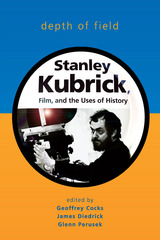 Depth of Field: Stanley Kubrick, Film, and the Uses of History
Edited by Geoffrey Cocks, James Diedrick, and Glenn Perusek
University of Wisconsin Press, 2006 Director of some of the most controversial films of the twentieth century, Stanley Kubrick created a reputation as a Hollywood outsider as well as a cinematic genius. His diverse yet relatively small oeuvre—he directed only thirteen films during a career that spanned more than four decades—covers a broad range of the themes that shaped his century and continues to shape the twenty-first: war and crime, gender relations and class conflict, racism, and the fate of individual agency in a world of increasing social surveillance and control.
In Depth of Field, leading screenwriters and scholars analyze Kubrick's films from a variety of perspectives. They examine such groundbreaking classics as Dr. Strangelove and 2001: A Space Odyssey and later films whose critical reputations are still in flux. Depth of Field ends with three viewpoints on Kubrick's final film, Eyes Wide Shut, placing it in the contexts of film history, the history and theory of psychoanalysis, and the sociology of sex and power. Probing Kubrick's whole body of work, Depth of Field is the first truly multidisciplinary study of one of the most innovative and controversial filmmakers of the twentieth century.
Der Rig-Veda
Karl Friedrich Geldner
Harvard University Press The Rigveda is the oldest Indian and one of the oldest Indo-European texts. It is a collection of 1,028 hymns addressed to the gods, composed in highly poetic and notoriously difficult Archaic Sanskrit. Medieval Indian commentaries and especially the modern Western scholarship of the past 150 years have increasingly shed more light on its poetry, religion, and ritual as well as on its contemporary meaning.
The Rigveda has been translated in scholarly fashion only once during the twentieth century, and that was into German in 1951 by K. F. Geldner and published in three separate volumes of Harvard Oriental Studies, numbers 33, 34, and 35. Renou's French and Elizarenkova's Russian translations closely follow Geldner's. Geldner's volumes have long been out of print; they are reprinted here in one useful reference volume.
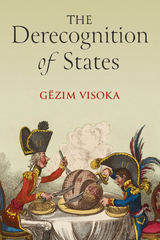 The Derecognition of States
Gëzim Visoka
University of Michigan Press, 2024 Although a great deal is known about the recognition of states, less is known about the practice of derecognition of states, namely why and how states withdraw the recognition of other contested and partially recognized states. The Derecognition of States offers a global and comparative outlook of this unexplored diplomatic practice. Using original empirical research, it addresses the complex processes, justifications, and consequences of state derecognition. In particular, it provides unique insights into five aspirant states facing withdrawal of recognition: Taiwan, Western Sahara, Abkhazia, South Ossetia, and Kosovo.
Gëzim Visoka argues that state derecognition is a highly controversial and unstable practice that has less to do with the unfulfillment of the conditions of statehood by the claimant than with the advancement of the self-interest of the former base state and derecognizing state. The derecognition of states is not a rule; rather, it is an exception in international diplomacy, driven by political expediency and is incompatible with original rationales for granting recognition. Yet, the derecognition of states is far more important than previously recognized in shaping the reversal dynamics of secession and state creation and in influencing regional peace, geopolitical rivalries, and the international order. By analyzing the withdrawal of recognition, the book offers a window into the reversal politics of unbecoming a sovereign state and how the arbitrary beginning and the end of diplomatic relations between states take place.
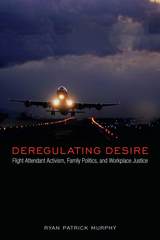 Deregulating Desire: Flight Attendant Activism, Family Politics, and Workplace Justice
Ryan Patrick Murphy
Temple University Press, 2016 In 1975, National Airlines was shut down for 127 days when flight attendants went on strike to protest long hours and low pay. Activists at National and many other U.S. airlines sought to win political power and material resources for people who live beyond the boundary of the traditional family. In Deregulating Desire, Ryan Patrick Murphy, a former flight attendant himself, chronicles the efforts of single women, unmarried parents, lesbians and gay men, as well as same-sex couples to make the airline industry a crucible for social change in the decades after 1970. Murphy situates the flight attendant union movement in the history of debates about family and work. Each chapter offers an economic and a cultural analysis to show how the workplace has been the primary venue to enact feminist and LGBTQ politics. From the political economic consequences of activism to the dynamics that facilitated the rise of what Murphy calls the “family values economy” to the Airline Deregulation Act of 1978, Deregulating Desire emphasizes the enduring importance of social justice for flight attendants in the twenty-first century.
Deregulation and Interdependence in the Asia-Pacific Region
Edited by Takatoshi Ito and Anne O. Krueger
University of Chicago Press, 2000 Recently, real and artificial barriers to international transactions have fallen sharply, causing a rise in the overall volume of international trade. East Asia has been particularly affected by the economic stresses and gains derived from deregulation. Deregulation and Interdependence in the Asia-Pacific Region explores the broadly similar experiences of certain economies in the region—China, Hong Kong, Japan, Korea—in dealing with the potentially volatile process of deregulation, and examines the East Asian response to a rapidly transforming economic environment.
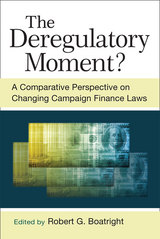 The Deregulatory Moment?: A Comparative Perspective on Changing Campaign Finance Laws
Robert G. Boatright, editor
University of Michigan Press, 2015 For those who assume that increased regulation of political spending is inevitable in democratic nations, recent developments in U.S. campaign finance law appear puzzling. Is deregulation, exemplified by the U.S. Supreme Court’s decision in Citizens United v. FEC, a harbinger of things to come elsewhere or further evidence that the United States remains an anomaly? In this volume, experts on the United States, Canada, Great Britain, Australia, Germany, Sweden, France, and several other European nations explore what deregulation means in the context of political campaigns and demonstrate how such comparisons can inform the study of campaign finance in the U.S. Whereas the contributors do not settle on any single theory of change in campaign finance law or any single perspective on the relationship between changes seen in the U.S. and those in other nations over the past decade, they do concur that the U.S. is rapidly retreating from the types of regulations that defined campaign finance law in most democratic nations during the latter decades of the twentieth century. By tracing and analyzing the recent history of regulation, the contributors shed light on many pressing topics, including the relationship between public opinion and campaign finance law, the role of scandals in inspiring reform, and the changing incentives of political parties, interest groups, and the courts.
Derek Attridge in Conversation
Derek Attridge
Sussex Academic Press, 2022 This volume of conversation not only provides a succinct philosophical biography that highlights the wide range of Attridge's interests. It likewise foregrounds his energetic engagements with literary theory, poetics, and stylistics, as well as his reassessments of contemporary philosophy and literary ideas, specifically those pertaining to the work Jacques Derrida, James Joyce, and J. M. Coetzee. Readers will find in this book a wonderful balancing act as Attridge negotiates the dynamics between the orthodoxies of critical practice and the strategic interventions of deconstructive reading. This book, with an appendix of a chronological listing of Attridge's publications, is an accessible and provocative introduction to the ideas of one of the most brilliant critical voices and generous presences in literary studies in the Anglophone world.
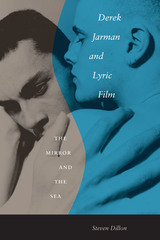 Derek Jarman and Lyric Film: The Mirror and the Sea
By Steven Dillon
University of Texas Press, 2004 Derek Jarman was the most important independent filmmaker in England during the 1980s. Using emblems and symbols in associative contexts, rather than conventional, cause-and-effect narrative, he created films noteworthy for their lyricism and poetic feeling and for their exploration of the gay experience. His style of filmmaking also links Jarman with other prominent directors of lyric film, including Pier Paolo Pasolini, Andrei Tarkovsky, Jean Cocteau, and Jean Genet. This pathfinding book places Derek Jarman in the tradition of lyric film and offers incisive readings of all eleven of his feature-length films, from Sebastiane to Blue. Steven Dillon looks at Jarman and other directors working in a similar vein to establish how lyric films are composed through the use of visual imagery and actual poetry. He then traces Jarman's use of imagery (notably mirrors and the sea) in his films and discusses in detail the relationship between cinematic representations and sexual identity. This insightful reading of Jarman's work helps us better understand how films such as The Last of England and The Garden can be said to cohere and mean without being reduced to clear messages. Above all, Dillon's book reveals how truly beautiful and brilliant Jarman's movies are.
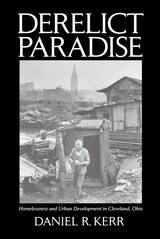 Derelict Paradise: Homelessness and Urban Development in Cleveland, Ohio
Daniel R. Kerr
University of Massachusetts Press, 2011 Seeking answers to the question, "Who benefits from homelessness?" this book takes the reader on a sweeping tour of Cleveland's history from the late nineteenth-century through the early twenty-first. Daniel Kerr shows that homelessness has deep roots in the shifting ground of urban labor markets, social policy, downtown development, the criminal justice system, and corporate power. Rather than being attributable to the illnesses and inadequacies of the unhoused themselves, it is a product of both structural and political dynamics shaping the city. Kerr locates the origins of today's shelter system in the era that followed the massive railroad rebellions of 1877. From that period through the Great Depression, business and political leaders sought to transform downtown Cleveland to their own advantage. As they focused on bringing business travelers and tourists to the city and beckoned upper-income residents to return to its center, they demolished two downtown working-class neighborhoods and institutionalized a shelter system to contain and control the unhoused and unemployed. The precedents from this period informed the strategies of the post–World War II urban renewal era as the "new urbanism" of the late twentieth century. The efforts of the city's elites have not gone uncontested. Kerr documents a rich history of opposition by people at the margins of whose organized resistance and everyday survival strategies have undermined the grand plans crafted by the powerful and transformed the institutions designed to constrain the lives of the homeless.
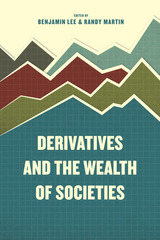 Derivatives and the Wealth of Societies
Edited by Benjamin Lee and Randy Martin
University of Chicago Press, 2016 Derivatives were responsible for one of the worst financial meltdowns in history, one from which we have not yet fully recovered. However, they are likewise capable of generating some of the most incredible wealth we have ever seen. This book asks how we might ensure the latter while avoiding the former. Looking past the usual arguments for the regulation or abolition of derivative finance, it asks a more probing question: what kinds of social institutions and policies would we need to put in place to both avail ourselves of the derivative’s wealth production and make sure that production benefits all of us?
To answer that question, the contributors to this book draw upon their deep backgrounds in finance, social science, art, and the humanities to create a new way of understanding derivative finance that does justice to its social and cultural dimensions. They offer a two-pronged analysis. First, they develop a social understanding of the derivative that casts it in the light of anthropological concepts such as the gift, ritual, play, dividuality, and performativity. Second, they develop a derivative understanding of the social, using financial concepts such as risk, hedging, optionality, and arbitrage to uncover new dimensions of contemporary social reality. In doing so, they construct a necessary, renewed vision of derivative finance as a deeply embedded aspect not just of our economics but our culture.
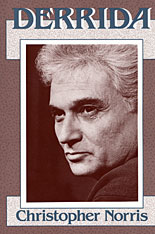 Derrida
Christopher Norris
Harvard University Press, 1987 Jacques Derrida (born 1930) is undoubtedly the single most influential figure in current Anglo-American literary theory. Yet many scholars and students, not to mention general readers, would be hard put to give an account of Derrida’s own writings. In this admirably clear and intelligent introduction, Christopher Norris demonstrates that Derrida’s texts should be understood as belonging more to philosophy than to literature. Norris explains the significance of Derrida’s writing on texts in the Western philosophical tradition, from Plato to Kant, Hegel, and Husserl, placing him squarely within that tradition. He also discusses some of the reasons for the massive institutional resistance that has so far prevented philosophers from engaging seriously with Derrida’s work. This book will be welcomed by readers in search of an introduction to Derrida’s work that neither underrates its difficulties nor invests his ideas with a kind of protective mystique.
Derrida and Differance
David Wood and Robert Bernasconi
Northwestern University Press, 1988 A collection of six essays by British and American philosophers, Derrida and Différance represents recent appropriations of Derrida's thought at the Warwick Workshops on Continental Philosophy. With an introductory letter by and interview with Derrida, Derrida and Différance focuses on the celebrated term "différance," a neologism devised by Derrida to denote the influence of differentiation in the structuring of all signification.
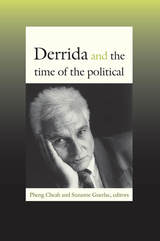 Derrida and the Time of the Political
Pheng Cheah and Suzanne Guerlac, eds.
Duke University Press, 2009 An intellectual event, Derrida and the Time of the Political marks the first time since Jacques Derrida’s death in 2004 that leading scholars have come together to critically assess the philosopher’s political and ethical writings. Skepticism about the import of deconstruction for political thought has been widespread among American critics since Derrida’s work became widely available in English in the late 1970s. While Derrida expounded political and ethical themes from the late 1980s on, there has been relatively little Anglo-American analysis of that later work or its relation to the philosopher’s entire corpus. Filling a critical gap, this volume provides multiple perspectives on the political turn in Derrida’s work, showing how deconstruction bears on political theory and real-world politics. The contributors include distinguished scholars of deconstruction whose thinking developed in close proximity to Derrida’s, as well as leading political theorists and philosophers who engage Derrida’s thought from further afield. The volume opens with a substantial introduction in which Pheng Cheah and Suzanne Guerlac survey Derrida’s entire corpus and position his later work in relation to it. The remaining essays address the concerns that arise out of Derrida’s analysis of politics and the conditions of the political, such as the meaning and scope of democracy, the limits of sovereignty, the relationship between the ethical and the political, the nature of responsibility, the possibility for committed political action, the implications of deconstructive thought for non-Western politics, and the future of nationalism in an era of globalization and declining state sovereignty. The collection is framed by original contributions from Hélène Cixous and Judith Butler. Contributors. Étienne Balibar, Geoffrey Bennington, Wendy Brown, Judith Butler, Pheng Cheah, Hélène Cixous, Rodolphe Gasché, Suzanne Guerlac, Marcel Hénaff, Martin Jay, Anne Norton, Jacques Rancière, Soraya Tlatli, Satoshi Ukai
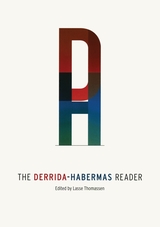 The Derrida-Habermas Reader
Edited by Lasse Thomassen
University of Chicago Press, 2006 Jacques Derrida and Jürgen Habermas have long represented opposite camps in contemporary thought. Derrida, who pioneered the intellectual style of inquiry known as deconstruction, ushered in the postmodern age with his dramatic critique of reason; Habermas, on the other hand, has consistently argued in defense of reason, modernity, and the legacy of the Enlightenment. Their many differences led to a long-standing, if scattered, dialogue, evidence of which has been available in only bits and pieces. But now, for the first time, TheDerrida-Habermas Reader brings these pieces together, along with a collection of essays documenting the intellectual relationship between two of the twentieth century’s preeminent thinkers.
Taken together, Derrida and Habermas’s writings—combined here with contributions by other prominent philosophers and social theorists—tell the story of the two thinkers’ provocative engagement with each other’s ideas. Beyond exploring the conflict between Derrida’s deconstruction and Habermas’s communicative rationality, they show how the Derrida-Habermas encounter changed over the years, becoming more theoretically productive without ever collapsing into mutual rejection or simple compromise.
Lasse Thomassen has divided the essays—including works on philosophy and literature, ethics, politics, and international law—into four parts that cover the full range of thought in which Derrida and Habermas engaged. The last of these sections fittingly includes the thinkers’ jointly signed work on European solidarity and the Iraq War, highlighting the hopes they held in common despite their differences. The wide breadth of this book, along with Thomassen’s lucid introductions to each section, makes The Derrida-Habermas Reader an ideal starting point for anyone interested in one of the most dynamic intellectual debates of our time.
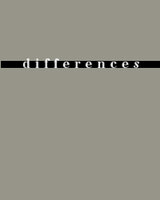 Derrida's Gift, Volume 16
Elizabeth Weed and Ellen Rooney, eds.
Duke University Press In this special issue of differences, leading feminist theorists acknowledge Derrida’s contribution to feminist theory, discuss the crucial place of difference in both Derridian deconstruction and feminist theory, and reflect on the ethical, professional, and epistemological implications of Derrida’s thought for the discipline of women’s studies. In bringing together major feminist critics whose work has been touched by the writings of Derrida, this issue both pays tribute to and reflects upon Derrida’s ideas. Among the essayists included, Jane Gallop considers Derrida’s writings on Levinas; Judith Butler reads Derrida’s final interview in Le Monde in 2004; Elizabeth Grosz signals Derrida as a rare philosopher for whom sexual difference was crucial; Gayatri Chakravorty Spivak explores the figure of the mother’s child in Derrida, focusing on the critique of reproductive heteronormativity and the question of agency in feminism; and Joan Wallach Scott argues for the importance of critique in the academy. The issue also includes an edited transcription of a vibrant discussion between feminist theorists and Derrida called “Women in the Beehive: A Seminar with Jacques Derrida,” which took place at Brown University’s Pembroke Center for Teaching and Research on Women in 1984. Contributors. Fran Bartkowski, Anne-Emmanuelle Berger, Susan Bernstein, Judith Butler, Pheng Cheah, Drucilla Cornell, Jane Gallop, Elizabeth Grosz, Peggy Kamuf, Christie McDonald, Joan Wallach Scott, Gayatri Chakravorty Spivak
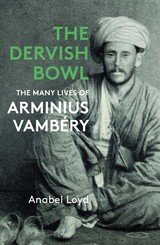 The Dervish Bowl: The Many Lives of Arminius Vambéry
Anabel Loyd
Haus Publishing, 2025 A narrative of the life of Arminius Vámbéry.
Who was Arminius Vámbéry? A poverty-stricken, Jewish autodidact; a linguist, traveler, and writer—or a sometime Zionist, inspiration for Dracula’s nemesis, and British secret agent? Vámbéry wrote his own story many times over, and it was these often highly embroidered accounts of journeys through Persia and Central Asia that saw him acclaimed in Victorian England as an intrepid explorer and daring adventurer. Against the backdrop of the “Great Game,” in which Russia and Britain jostled for territory, influence, and control of the borders and gateways to India and its wealth, Vámbéry played the roles of hero and double-dealer, of fascinated witness and imperialist charlatan.
The Dervish Bowl is the story of these competing narratives and a compelling investigation of both the ever-changing persona Vámbéry created for himself and the man who emerges from his private correspondence and the accounts of both his friends and his enemies, many of whom were themselves major players in the geopolitical adventures of the volatile nineteenth century—a time when Britain’s ambitions for her empire were at their height, yet nothing and no one was quite as they seemed.
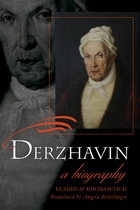 Derzhavin: A Biography
Vladislav Khodasevich, Translated and with an introduction by Angela Brintlinger
University of Wisconsin Press, 2007 Russian poet, soldier, and statesman Gavriil Derzhavin (1743–1816) lived during an epoch of momentous change in Russia—imperial expansion, peasant revolts, war with Turkey, and struggle with Napoleon—and he served three tsars, including Catherine the Great. Here in its first English translation is the masterful biography of Derzhavin by another acclaimed Russian man of letters, Vladislav Khodasevich. Derzhavin occupied a position at the center of Russian life, uniting civic service with poetic inspiration and creating an oeuvre that at its essence celebrated the triumphs of Russia and its rulers, particularly Catherine the Great. His biographer Khodasevich, by contrast, left Russia in 1922, unable to abide the increasingly repressive regime of the Soviets. For Khodasevich, whose lyric poems were as commonplace in their focus as Derzhavin’s odes were grand, this biography was in a sense a rediscovery of a lost and idyllic era, a period when it was possible to aspire to the pinnacles of artistic achievement while still occupying a central role in Russian society. Khodasevich writes with humor, intelligence, and understanding, and his work stands as a monument to the last three centuries of Russian history, lending keen insight into Russia’s past as well as its present and future.
“Khodasevich’s light narrative touch (as translated by Brintlinger) lends a novelistic quality to the biography, making it a genuine tour de force. All students and scholars – of history, literature, poetry, biography – will find something of interest here.”—Choice
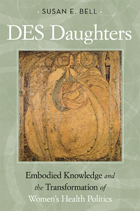 DES Daughters, Embodied Knowledge, and the Transformation of Women's Health Politics in the Late Twentieth Century
Susan E. Bell
Temple University Press, 2009 From the 1940s to the 1970s, millions of women were exposed prenatally to the synthetic estrogen DES, a “wonder drug” intended to prevent miscarriages. However, DES actually had damaging consequences for the women born from DES mothers. The “DES daughters” as they are known, were found to have a rare form of vaginal cancer or were infertile. They were also at risk for miscarriages, stillbirths, and ectopic pregnancies.
In DES Daughters, Susan Bell recounts the experiences of this generation of “victims.” In moving, heartfelt narratives, she presents the voices of those women who developed cancer, those who were cancer-free but have concerns about becoming pregnant, and those who suffered other medical and/or reproductive difficulties.
Bell examines the hierarchy of knowledge and power of scientists, doctors, and daughters, tracing the emergence of a feminist health movement. The “embodied knowledge” of these DES daughters prompted them to become advocates and form a social movement that challenged reproductive medical knowledge specifically, but also the politics of women’s health in general. Bell’s important book chronicles the history and future of these grassroots activists born out of illness, suffering, and uncertainty.
 Des hégémonies brisée
Reiner Schürmann
Diaphanes, 2017 Le b-a ba du métier n’est-il pas d’assurer un fondement, non-fondé mais capable néanmoins d’ancrer les prémisses m’instruisant sur ce que je puis savoir et sur ce que je dois faire ? Comprise ainsi, la norme ne se justifie pas ; en quoi elle est fantasmatique. Mais elle justifie tout ce qui peut devenir phénomène pendant l’époque linguistique à laquelle elle imprime sa marque ; en quoi elle est hégémonique. S’il s’avère qu’un tel référent non-référable à quelque instance supérieure se maintient tant que prédomine une langue, alors l’histoire à retracer sera celle des fantasmes hégémoniques grec, latin, et moderne. Un fantasme est hégémonique quand toute une culture s’y fie comme si elle tenait là au nom de quoi parler et agir. Pareil représenté-chef (hêgemôn) travaille le singulier qui est indicible, en le disant part d’un tout. Les hégémonies tournent le singulier en du particulier.
Il s’agira donc de retracer une histoire de soumissions par nous-mêmes encourues.
Des Moines Register Cookbook
Carol Mcgarvey
University of Iowa Press, 1995 The food pages of The Des Moines Register, Iowa's highly regarded newspaper, have long reflected the wide-ranging tastes of Iowa cooks, both adventurous and traditional. Drawings.
 Descartes and His Contemporaries: Meditations, Objections, and Replies
Edited by Roger Ariew and Marjorie Grene
University of Chicago Press, 1995 Before publishing his landmark Meditations in 1641, Rene Descartes sent his manuscript to many leading thinkers to solicit their objections to his arguments. He included these objections, along with his own detailed replies, as part of the first edition. This unusual strategy gave Descartes a chance to address criticisms in advance and to demonstrate his willingness to consider diverse viewpoints—critical in an age when radical ideas could result in condemnation by church and state, or even death.
Descartes and his Contemporaries recreates the tumultuous intellectual community of seventeenth-century Europe and provides a detailed, modern analysis of the Meditations in its historical context. The book's chapters examine the arguments and positions of each of the objectors—Hobbes, Gassendi, Arnauld, Morin, Caterus, Bourdin, and others whose views were compiled by Mersenne. They illuminate Descartes' relationships to the scholastics and particularly the Jesuits, to Mersenne's circle with its debates about the natural sciences, to the Epicurean movements of his day, and to the Augustinian tradition. Providing a glimpse of the interactions among leading 17th-century intellectuals as they grappled with major philosophical issues, this book sheds light on how Descartes' thought developed and was articulated in opposition to the ideas of his contemporaries.
Descartes and the Resilience of Rhetoric: Varieties of Cartesian Rhetorical Theory
Thomas M. Carr, Jr.
Southern Illinois University Press, 2009 A careful analysis of the rhetorical thought of René Descartes and of a distinguished group of post-Cartesians. Covering a unique range of authors, including Bernard Lamy and Nicolas Malebranche, Carr attacks the idea, which has become commonplace in contemporary criticism, that the Cartesian system is incompatible with rhetoric. Carr analyzes the writings of Balzac, the Port-Royalists Arnauld and Nicole, Malebranche, and Lamy, exploring the evolution of Descartes’ thought into their different theories of rhetoric. He constructs his arguments, probing each author’s writings on rhetoric, persuasion, and attention, to demonstrate the basis for rhetorical thought present in Descartes’ theory of persuasion when it is combined with his psychophysiology of attention.
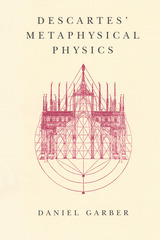 Descartes' Metaphysical Physics
Daniel Garber
University of Chicago Press, 1992 In this first book-length treatment of Descartes' important and influential natural philosophy, Daniel Garber is principally concerned with Descartes' accounts of matter and motion—the joint between Descartes' philosophical and scientific interests. These accounts constitute the point at which the metaphysical doctrines on God, the soul, and body, developed in writings like the Meditations, give rise to physical conclusions regarding atoms, vacua, and the laws that matter in motion must obey.
Garber achieves a philosophically rigorous reading of Descartes that is sensitive to the historical and intellectual context in which he wrote. What emerges is a novel view of this familiar figure, at once unexpected and truer to the historical Descartes.
The book begins with a discussion of Descartes' intellectual development and the larger project that frames his natural philosophy, the complete reform of all the sciences. After this introduction Garber thoroughly examines various aspects of Descartes' physics: the notion of body and its identification with extension; Descartes' rejection of the substantial forms of the scholastics; his relation to the atomistic tradition of atoms and the void; the concept of motion and the laws of motion, including Descartes' conservation principle, his laws of the persistence of motion, and his collision law; and the grounding of his laws in God.
Descartes' Nightmare
Susan McCabe
University of Utah Press, 2008 The Agha Shahid Ali Prize in Poetry was inaugurated in 2003 to honor the late poet, a nationally recognized writer and a former professor at the University of Utah, and is sponsored by the University of Utah Press and the University of Utah Department of English.
Descartes’ Nightmare is the 2007 prizewinning volume selected by this year’s judge, Cole Swenson, of the Iowa Writers’ Workshop.
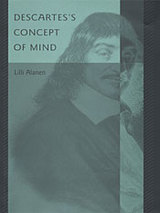 Descartes's Concept of Mind
Lilli Alanen
Harvard University Press, 2003 Descartes's concept of the mind, as distinct from the body with which it forms a union, set the agenda for much of Western philosophy's subsequent reflection on human nature and thought. This is the first book to give an analysis of Descartes's pivotal concept that deals with all the functions of the mind, cognitive as well as volitional, theoretical as well as practical and moral. Focusing on Descartes's view of the mind as intimately united to and intermingled with the body, and exploring its implications for his philosophy of mind and moral psychology, Lilli Alanen argues that the epistemological and methodological consequences of this view have been largely misconstrued in the modern debate.
Informed by both the French tradition of Descartes scholarship and recent Anglo-American research, Alanen's book combines historical-contextual analysis with a philosophical problem-oriented approach. It seeks to relate Descartes's views on mind and intentionality both to contemporary debates and to the problems Descartes confronted in their historical context. By drawing out the historical antecedents and the intellectual evolution of Descartes's thinking about the mind, the book shows how his emphasis on the embodiment of the mind has implications far more complex and interesting than the usual dualist account suggests.
 Descartes’s Dualism
Marleen Rozemond
Harvard University Press, 1998 Descartes, an acknowledged founder of modern philosophy, is identified particularly with mind-body dualism--the view that the mind is an incorporeal entity. But this view was not entirely original with Descartes, and in fact to a significant extent it was widely accepted by the Aristotelian scholastics who preceded him, although they entertained a different conception of the nature of mind, body, and the relationship between them. In her first book, Marleen Rozemond explicates Descartes's aim to provide a metaphysics that would accommodate mechanistic science and supplant scholasticism.
Her approach includes discussion of central differences from and similarities to the scholastics and how these discriminations affected Descartes's defense of the incorporeity of the mind and the mechanistic conception of body. Confronting the question of how, in his view, mind and body are united, she examines his defense of this union on the basis of sensation. In the course of her argument, she focuses on a few of the scholastics to whom Descartes referred in his own writings: Thomas Aquinas, Francisco Suárez, Eustachius of St. Paul, and the Jesuits of Coimbra. This new systematic account of Descartes's dualism amply demonstrates why he still deserves serious study and respect for his extraordinary philosophical achievements.
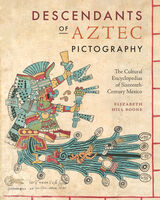 Descendants of Aztec Pictography: The Cultural Encyclopedias of Sixteenth-Century Mexico
By Elizabeth Hill Boone
University of Texas Press, 2021 In the aftermath of the sixteenth-century Spanish conquest of Mexico, Spanish friars and authorities partnered with indigenous rulers and savants to gather detailed information on Aztec history, religious beliefs, and culture. The pictorial books they created served the Spanish as aids to evangelization and governance, but their content came from the native intellectuals, painters, and writers who helped to create them. Examining the nine major surviving texts, preeminent Latin American art historian Elizabeth Hill Boone explores how indigenous artists and writers documented their ancestral culture. Analyzing the texts as one distinct corpus, Boone shows how they combined European and indigenous traditions of documentation and considers questions of motive, authorship, and audience. For Spanish authorities, she shows, the books revealed Aztec ideology and practice, while for the indigenous community, they preserved venerated ways of pictorial expression as well as rhetorical and linguistic features of ancient discourses. The first comparative analysis of these encyclopedias, Descendants of Aztec Pictography analyzes how the painted compilations embraced artistic traditions from both sides of the Atlantic.
 Descent
Arria Deepwater
Omnidawn, 2025 A work of fabulist fiction that centers on the lives and protection of those living in sick, disabled, and other marginalized bodies.
Arria Deepwater’s Descent is a modern fairy tale exploring the vulnerability and strength that come with living in an unconventional body, especially for those living with the experience of disabilities, chronic illness, hyper-medicalization, objectification, and 2SLGBTQIA+ identities. The reader is invited to become an observer of isolation, violation, and the magic of secret joy. Descent moves through entangled connections and dissolving boundaries between humanity and the natural world as it seeks to weave a spell of protection for those whose bodies do not conform, for whom existence is a radical act of rebellion and creativity.
Exploring boundaries of intimacy, fluidity, and grief, Deepwater brings an eco-feminist speculative twist to the growing canon of writers with marginalized identities. Deepwater considers the fractured reality of living in a queer disabled body and how we might find freedom, safety, and spiritual healing despite grief.
Descent is the winner of Omnidawn’s 2022 Fabulist Fiction Contest, chosen by Michelle Ruiz Keil.
Descent from Glory: Four Generations of the John Adams Family
Paul C. Nagel
Harvard University Press, 1999 There has never been any doubt that the Adams family was America’s first family in our politics and memory. This research-based and insightful book is a multigenerational biography of that family from the founder father John through the mordant writer Brooks.
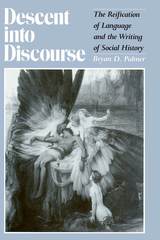 Descent Into Discourse: The Reification of Language and the Writing of Social History
Bryan Palmer
Temple University Press, 1990 "Critical theory is no substitute for historical materialism; language is not life." With this statement, Bryan Palmer enters the debate that is now transforming and disrupting a number of academic disciplines, including political science, women’s studies, and history. Focusing on the ways in which literary or critical theory is being promoted within the field of social history, he argues forcefully that the current reliance on poststructuralism—with its reification of discourse and avoidance of the structures of oppression and struggles of resistance—obscures the origins, meanings, and consequences of historical events and processes.
Palmer is concerned with the emergence of "language" as a central focus of intellectual work in the twentieth century. He locates the implosion of theory that moved structuralism in the direction of poststructuralism and deconstruction in what he calls the descent into discourse. Few historians who champion poststructuralist thought, according to Palmer, appreciate historical materialism’s capacity to address discourse meaningfully. Nor do many of the advocates of language within the field of social history have an adequate grounding in the theoretical making of the project they champion so ardently. Palmer roots his polemical challenge in an effort to "introduce historians more fully to the theoretical writing that many are alluding to and drawing from rather cavalierly." Acknowledging that critical theory can contribute to an understanding of some aspects of the past, Palmer nevertheless argues for the centrality of materialism to the project of history. In specific discussions of how critical theory is constructing histories of politics, class, and gender, he traces the development of the descent into discourse within social history, mapping the limitations of recent revisionist texts. Much of this writing, he contends, is undertheorized and represents a problematic retreat from prior histories that attempted to address such material forces as economic structures, political power, and class struggle.
Descent into Discourse counters current intellectual fashion with an eloquent argument for the necessity to analyze and appreciate lived experience and the structures of subordination and power in any quest for historical meaning.
 The Descent of Artificial Intelligence: A Deep History of an Idea 400 Years in the Making
Kevin Donnelly
University of Pittsburgh Press, 2023 The idea that a new technology could challenge human intelligence is as old as the warning from Socrates and Plato that written language eroded memory. With the emergence of generative artificial intelligence programs, we find ourselves once again debating how a new technology might influence human thought and behavior. Researchers, software developers, and “visionary” tech writers even imagine an AI that will equal or surpass human intelligence, adding to a sense of technological determinism where humanity is inexorably shaped by powerful new machines. But among the hundreds of essays, books, and movies that approach the question of AI, few have asked how exactly scientists and philosophers have codified human thought and behavior. Rather than focusing on technical contributions in machine building, The Descent of Artificial Intelligence explores a more diverse cast of thinkers who helped to imagine the very kind of human being that might be challenged by a machine. Kevin Padraic Donnelly argues that what we often think of as the “goal” of AI has in fact been shaped by forgotten and discredited theories about people and human nature as much as it has been by scientific discoveries, mathematical advances, and novel technologies. By looking at the development of artificial intelligence through the lens of social thought, Donnelly deflates the image of artificial intelligence as a technological monolith and reminds readers that we can control the narratives about ourselves.
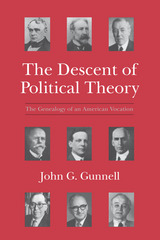 The Descent of Political Theory: The Genealogy of an American Vocation
John G. Gunnell
University of Chicago Press, 1993 This provocative work reveals the origins and development of political theory as it is presently understood—and misunderstood. Tracing the evolution of the field from the nineteenth century to the present, John G. Gunnell shows how current controversies, like those over liberalism or the relationship of theory to practice, are actually the unresolved legacy of a forgotten past. By uncovering this past, Gunnell exposes the forces that animate and structure political theory today.
Gunnell reconstructs the evolution of the field by locating it within the broader development of political science and American social science in general. During the behavioral revolution that swept political science in the 1950s, the relationship between political theory and political science changed dramatically, relegating theory to the margins of an increasingly empirical discipline. Gunnell demonstrates that the estrangement of political theory is rooted in a much older quarrel: the authority of knowledge versus political theory is rooted in a much older quarrel: the authority of knowledge versus political authority, academic versus public discourse. By disclosing the origin of this dispute, he opens the way for a clearer understanding of the basis and purpose of political theory.
As critical as it is revelatory, this thoughtful book should be read by any one interested in the history of political theory or science—or in the relationship of social science to political practice in the United States.
Description of Greece, Volume I: Books 1–2
Pausanias
Harvard University Press, 2004 Antiquity’s original travel guide.
Pausanias, born probably in Lydia in Asia Minor, was a Greek of the second century AD, about 120–180, who traveled widely not only in Asia Minor, Palestine, Egypt, and North Africa, but also in Greece and in Italy, including Rome. He left a description of Greece in ten books, which is like a topographical guidebook or tour of Attica, the Peloponnese, and central Greece, filled out with historical accounts and events and digressions on facts and wonders of nature. His chief interest was in monuments of art and architecture, especially the most famous of them; the accuracy of his descriptions is proved by surviving remains.
The Loeb Classical Library edition of Pausanias is in five volumes; the fifth volume contains maps, plans, illustrations, and a general index.
Description of Greece, Volume II: Books 3–5
Pausanias
Harvard University Press Antiquity’s original travel guide.
Pausanias, born probably in Lydia in Asia Minor, was a Greek of the second century AD, about 120–180, who traveled widely not only in Asia Minor, Palestine, Egypt, and North Africa, but also in Greece and in Italy, including Rome. He left a description of Greece in ten books, which is like a topographical guidebook or tour of Attica, the Peloponnese, and central Greece, filled out with historical accounts and events and digressions on facts and wonders of nature. His chief interest was in monuments of art and architecture, especially the most famous of them; the accuracy of his descriptions is proved by surviving remains.
The Loeb Classical Library edition of Pausanias is in five volumes; the fifth volume contains maps, plans, illustrations, and a general index.
Description of Greece, Volume III: Books 6–8.21
Pausanias
Harvard University Press Antiquity’s original travel guide.
Pausanias, born probably in Lydia in Asia Minor, was a Greek of the second century AD, about 120–180, who traveled widely not only in Asia Minor, Palestine, Egypt, and North Africa, but also in Greece and in Italy, including Rome. He left a description of Greece in ten books, which is like a topographical guidebook or tour of Attica, the Peloponnese, and central Greece, filled out with historical accounts and events and digressions on facts and wonders of nature. His chief interest was in monuments of art and architecture, especially the most famous of them; the accuracy of his descriptions is proved by surviving remains.
The Loeb Classical Library edition of Pausanias is in five volumes; the fifth volume contains maps, plans, illustrations, and a general index.
Description of Greece, Volume IV: Books 8.22–10
Pausanias
Harvard University Press Antiquity’s original travel guide.
Pausanias, born probably in Lydia in Asia Minor, was a Greek of the second century AD, about 120–180, who traveled widely not only in Asia Minor, Palestine, Egypt, and North Africa, but also in Greece and in Italy, including Rome. He left a description of Greece in ten books, which is like a topographical guidebook or tour of Attica, the Peloponnese, and central Greece, filled out with historical accounts and events and digressions on facts and wonders of nature. His chief interest was in monuments of art and architecture, especially the most famous of them; the accuracy of his descriptions is proved by surviving remains.
The Loeb Classical Library edition of Pausanias is in five volumes; the fifth volume contains maps, plans, illustrations, and a general index.
Description of Greece, Volume V: Illustrations and Index
Pausanias
Harvard University Press Antiquity’s original travel guide.
Pausanias, born probably in Lydia in Asia Minor, was a Greek of the second century AD, about 120–180, who traveled widely not only in Asia Minor, Palestine, Egypt, and North Africa, but also in Greece and in Italy, including Rome. He left a description of Greece in ten books, which is like a topographical guidebook or tour of Attica, the Peloponnese, and central Greece, filled out with historical accounts and events and digressions on facts and wonders of nature. His chief interest was in monuments of art and architecture, especially the most famous of them; the accuracy of his descriptions is proved by surviving remains.
The Loeb Classical Library edition of Pausanias is in five volumes; the fifth volume contains maps, plans, illustrations, and a general index.
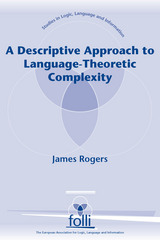 A Descriptive Approach to Language-Theoretic Complexity
James Rogers
CSLI, 1998 Early formal specifications of natural language syntax were quite closely connected to the notion of abstract machines for computing them. This provided a very natural means of gauging the relative difficulty of processing various constructions, as well as offering some insight into the abstract properties of the human language faculty. More recently, this approach has been superseded by one in which languages are specified in terms of systems of constraints on the structure of their sentences. This has made complexity results difficult to obtain. This book introduces a way of obtaining such results. It presents a natural and quite general means of expressing constraints on the structure of trees and shows that the languages that can be specified by systems of such constraints are exactly those computable by a particular standard class of abstract machines. Thus the difficulty of processing a construction can be reduced to the difficulty of expressing the constraints that specify it. The technique is demonstrated by applying it to a fairly complete treatment of English within the framework of Government and Binding theory, with the result of showing that its complexity is much less than has heretofore been assumed.
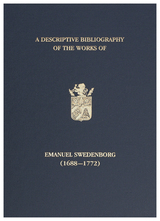 A Descriptive Bibliography of the Works of Emanuel Swedenborg (1688-1772)
Norman Ryder
Swedenborg Foundation Publishers, 2010 A Descriptive Bibliography of the Works of Emanuel Swedenborg (1688-1772) is a reference work that no publisher, library or academic of Swedenborg should be without. Editors and proofreaders will be grateful to be able to look up publishing and bibliographic details of Swedenborg editions spanning over 300 years without having to make trips to various libraries, or trawls through their respective catalogues (not one of which matches Norman Ryder’s Bibliography for the comprehensive detail of its records). For academics, meanwhile, Ryder’s new Bibliography will be useful in providing contexts and overviews of the compositional and publishing history for each of Swedenborg’s individual texts. And for ‘professional’ Swedenborgians, academics and all other interested readers of Swedenborg alike, the Bibliography contains a wealth of useful and fascinating information, revealing, beneath the astonishing depth of its data, the stories and trends behind the reception of Swedenborg’s works across the globe.
Volume One of the Bibliography contains:
· ‘Section A: Swedenborg’s Literary Corpus, 1700-1771’ (an overview and summary listing of Swedenborg’s entire literary output)
· ‘Section B: Bibliographies of Swedenborg’s Works’ (details of all previous bibliographies of Swedenborg)
· ‘Section C: Bibliographical Descriptions, 1700-1742’ (each of Swedenborg’s works written or published during this time period is treated to an introduction concerning its compositional history, followed by detailed bibliographical entries for the manuscripts, first editions, and all subsequent editions and translations of the work known to have appeared, including extracts, accompanied by lists of libraries and institutions known to possess copies of the editions in question)
Also included in the volume are a general introduction; lists of abbreviations; and a glossary of bibliographical terms.
 A Descriptive Bibliography of the Works of Emanuel Swedenborg (1688-1772)
Norman Ryder
Swedenborg Foundation Publishers, 2012 A Descriptive Bibliography of the Works of Emanuel Swedenborg (1688-1772) is a reference work that no publisher, library or academic of Swedenborg should be without. Editors and proofreaders will be grateful to be able to look up publishing and bibliographic details of Swedenborg editions spanning over 300 years without having to make trips to various libraries, or trawls through their respective catalogues (not one of which matches Norman Ryder’s Bibliography for the comprehensive detail of its records). For academics, meanwhile, Ryder’s new Bibliography will be useful in providing contexts and overviews of the compositional and publishing history for each of Swedenborg’s individual texts. And for ‘professional’ Swedenborgians, academics and all other interested readers of Swedenborg alike, the Bibliography contains a wealth of useful and fascinating information, revealing, beneath the astonishing depth of its data, the stories and trends behind the reception of Swedenborg’s works across the globe.
Volume Two of the Bibliography contains:
· ‘Section C: Bibliographic Descriptions, 1743-1755’
Also included in the volume are an introduction; lists of abbreviations; and a glossary of bibliographical terms.
 A Descriptive Catalogue of the Medieval and Renaissance Manuscripts of the University of Notre Dame and Saint Mary's College
David T. Gura
University of Notre Dame Press, 2016 David T. Gura’s innovative catalogue describes the 288 medieval and Renaissance manuscripts held by the University of Notre Dame (Hesburgh Library and Snite Museum of Art) and Saint Mary’s College. Bound manuscripts, leaves, and fragments, which span the late eleventh through the sixteenth century and include bibles, books of hours, calendars, liturgical texts, and much more, are given thorough critical treatment and scholarly description. Organized by repository, each manuscript description is based on Gura's intensive paleographical and codicological analyses, which address features such as material and support, collation, illumination, layout, script types, ownership history, book bindings, and bibliographical references. Scaled diagrams of distinct and variant ruling patterns and border arrangements are included with each catalogue entry to facilitate comparison with each other and with manuscripts outside the collection. Gura’s flexible schematic for analytical manuscript description presents the important aspects of particular genres of the manuscripts, distinguishes their uncommon features, and interprets them.
In his introduction to the catalogue, Gura provides a history of the formation of the manuscript collections, a scholarly overview organized by genre, and a detailed explanation of his analytical schematic. Paratextual materials allow readers to browse all manuscripts in the collections by repository, date, country or region of origin, language, and textual contents. Academic librarians, manuscript dealers and collectors, and the community of scholars, curators, and librarians who work with medieval and Renaissance manuscripts will find this an accessible and valuable resource.
"David T. Gura's fastidious and comprehensive treatment of the manuscripts he catalogues ranks among the very best scholarship I have ever encountered. Both the originality and exceptional detail of this catalogue convey its potential to be a model for similar cataloguing endeavors in the future. This is no mere 'catalogue,' in other words; on the contrary, it represents the future of manuscript taxonomy, a departure from anything I know of for any American collection of manuscripts." —Scott James Gwara, University of South Carolina
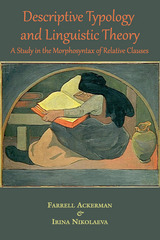 Descriptive Typology and Linguistic Theory: A Study in the Morphology of Relative Clauses
Farrell Ackerman and Irina Nikolaeva
CSLI, 2003 Descriptive grammarians and typologists often encounter unusual constructions or unfamiliar variants of otherwise familiar construction types. Many of these phenomena are puzzling from the perspective of linguistic theories: they neither predict these “anomalies” nor, arguably, provide the tools to describe them insightfully. This book analyzes an unusual type of relative clause found in many related and unrelated languages of Eurasia. While providing a detailed case study of Tundra Nenets, it broadens this inquiry into a detailed typological exploration of this relative clause type. The authors argue that an understanding of this construction requires exploring the (type of) grammar system in which it occurs in order to identify the (set of) independent constructions that motivate its existence. The resulting insights into grammar organization illustrate the usefulness of a construction-theoretic syntax and morphology informed by a developmental systems perspective for the understanding of complex grammatical phenomena.
Desecularizing the Christian Past: Beyond R.A. Markus and the Religious-Secular Divide
Enrico Beltramini
Amsterdam University Press, 2023 The essential objective of this study is to unpack the complicity between historians and secularization theory in the study of late ancient and early medieval Christianity—and then suggest a way out. In this work of historiography of religion, Enrico Beltramini argues that religious history is inherently secular and produces distorted representations of the Christian past. He suggests moving from an epistemological to a hermeneutical approach so that the supernatural worldview of the Christian past can be addressed on its own terms. This work also engages Markus’s saeculum and replaces Markus’s secularized relationship between the Kingdom and the government of the civitas with the Augustinian association of the Kingdom and divine government.
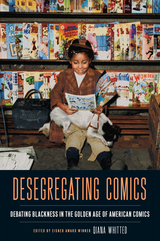 Desegregating Comics: Debating Blackness in the Golden Age of American Comics
Qiana Whitted
Rutgers University Press, 2023 Winner of the Comics Studies Society Edited Book Prize
Shortlisted for the Best Academic / Scholarly Work Eisner Award
Honorable Mention for the Harry Shaw and Katrina Hazzard-Donald Award for Outstanding Work in African-American Popular Culture Studies from the Popular Culture Association
Some comics fans view the industry’s Golden Age (1930s-1950s) as a challenging time when it comes to representations of race, an era when the few Black characters appeared as brutal savages, devious witch doctors, or unintelligible minstrels. Yet the true portrait is more complex and reveals that even as caricatures predominated, some Golden Age comics creators offered more progressive and nuanced depictions of Black people.
Desegregating Comics assembles a team of leading scholars to explore how debates about the representation of Blackness shaped both the production and reception of Golden Age comics. Some essays showcase rare titles like Negro Romance and consider the formal innovations introduced by Black comics creators like Matt Baker and Alvin Hollingsworth, while others examine the treatment of race in the work of such canonical cartoonists as George Herriman and Will Eisner. The collection also investigates how Black fans read and loved comics, but implored publishers to stop including hurtful stereotypes. As this book shows, Golden Age comics artists, writers, editors, distributors, and readers engaged in heated negotiations over how Blackness should be portrayed, and the outcomes of those debates continue to shape popular culture today.
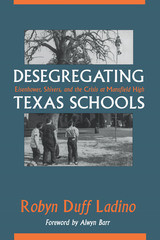 Desegregating Texas Schools: Eisenhower, Shivers, and the Crisis at Mansfield High
By Robyn Duff Ladino
University of Texas Press, 1996 In the famous Brown v. the Board of Education decisions of 1954 and 1955, the United States Supreme Court ruled that "separate but equal" schools for black and white students were unconstitutional. Yet history records that it took more than a decade of legal battles, civil rights protests, and, tragically, violent confrontations before black students gained full access to previously white schools. Mansfield, Texas, a small community southeast of Fort Worth, was the scene of an early school integration attempt. In this book, Robyn Duff Ladino draws on interviews with surviving participants, media reports, and archival research to provide the first full account of the Mansfield school integration crisis of 1956. Ladino explores how power politics at the local, state, and federal levels ultimately prevented the integration of Mansfield High School in 1956. Her research sheds new light on the actions of Governor Allan Shivers—who, in the eyes of the segregationists, actually validated their cause by his political actions—and it underscores President Dwight Eisenhower's public passivity toward civil rights during his first term of office. Despite the short-term failure, however, the Mansfield school integration crisis helped pave the way for the successful integration of Central High School in Little Rock, Arkansas, in 1957. Thus, it deserves a permanent place in the history of the civil rights movement, which this book amply provides.
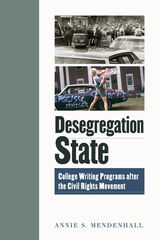 Desegregation State: College Writing Programs after the Civil Rights Movement
Annie S. Mendenhall
Utah State University Press, 2021 The only book-length study of the ways that postsecondary desegregation litigation and policy affected writing instruction and assessment in US colleges, Desegregation State provides a history of federal enforcement of higher education desegregation and its impact on writing programs from 1970 to 1988. Focusing on the University System of Georgia and two of its public colleges in Savannah, one a historically segregated white college and the other a historically Black college, Annie S. Mendenhall shows how desegregation enforcement promoted and shaped writing programs by presenting literacy remediation and testing as critical to desegregation efforts in southern and border states.
Formerly segregated state university systems crafted desegregation plans that gave them more control over policies for admissions, remediation, and retention. These plans created literacy requirements—admissions and graduation tests, remedial classes, and even writing centers and writing across the curriculum programs—that reshaped the landscape of college writing instruction and denied the demands of Black students, civil rights activists, and historically Black colleges and universities for major changes to university systems. This history details the profound influence of desegregation—and resistance to desegregation—on the ways that writing is taught and assessed in colleges today.
Desegregation State provides WPAs and writing teachers with a disciplinary history for understanding racism in writing assessment and writing programs. Mendenhall brings emerging scholarship on the racialization of institutions into the field, showing why writing studies must pay more attention to how writing programs have institutionalized racist literacy ideologies through arguments about student placement, individualized writing instruction, and writing assessment.
Desert Ascetics of Egypt
Darlene L. Brooks Hedstrom
Arc Humanities Press, 2023
Egypt is revered as the home of the famous Desert Ascetics, who first embraced a monastic life and established homosocial communities on the borders of their urban centres in the Nile Valley. Regarded as angels and warriors, the wisdom of the Desert Ascetics formed part of the oral and literary tradition of wonder-working saints whose commitment to asceticism was legendary and inspirational. This book grounds the mythologized stories of Desert Ascetics in the materiality of the desert, demonstrating the closeness of the desert, the connections between non-monastic and monastic communities, and the exciting insights into lived monasticism through the archaeology of monasticism in Egypt.
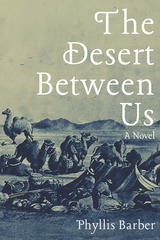 The Desert Between Us: A Novel
Phyllis Barber
University of Nevada Press, 2020 2020 Reading the West Book Awards, Longlist for Fiction
2020 Association for Morman Letters Finalist, Fiction
The Desert Between Us is a sweeping, multi-layered novel based on the U.S. government’s decision to open more routes to California during the Gold Rush. To help navigate this waterless, largely unexplored territory, the War Department imported seventy-five camels from the Middle East to help traverse the brutal terrain that was murderous on other livestock. Geoffrey Scott, one of the roadbuilders, decides to venture north to discover new opportunities in the opening of the American West when he—and the camels—are no longer needed. Geoffrey arrives in St. Thomas, Nevada, a polygamous settlement caught up in territorial fights over boundaries and new taxation. There, he falls in love with Sophia Hughes, a hatmaker obsessed with beauty and the third wife of a polygamist. Geoffrey believes Sophia wants to be free of polygamy and go away with him to a better life, but Sophia’s motivations are not so easily understood. She had become committed to Mormon beliefs in England and had moved to Utah Territory to assuage her spiritual needs. The death of Sophia’s child and her illicit relationship with Geoffrey generate a complex nexus where her new love for Geoffrey competes with societal expectations and a rugged West seeking domesticity. When faced with the opportunity to move away from her polygamist husband and her tumultuous life in St. Thomas, Sophia becomes tormented by a life-changing decision she must face alone.
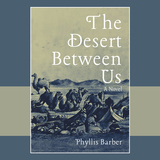 The Desert Between Us: A Novel
Phyllis Barber
University of Nevada Press, 2020 2020 Reading the West Book Awards, Longlist for Fiction
2020 Association for Morman Letters Finalist, Fiction
The Desert Between Us is a sweeping, multi-layered novel based on the U.S. government’s decision to open more routes to California during the Gold Rush. To help navigate this waterless, largely unexplored territory, the War Department imported seventy-five camels from the Middle East to help traverse the brutal terrain that was murderous on other livestock. Geoffrey Scott, one of the roadbuilders, decides to venture north to discover new opportunities in the opening of the American West when he—and the camels—are no longer needed. Geoffrey arrives in St. Thomas, Nevada, a polygamous settlement caught up in territorial fights over boundaries and new taxation. There, he falls in love with Sophia Hughes, a hatmaker obsessed with beauty and the third wife of a polygamist. Geoffrey believes Sophia wants to be free of polygamy and go away with him to a better life, but Sophia’s motivations are not so easily understood. She had become committed to Mormon beliefs in England and had moved to Utah Territory to assuage her spiritual needs. The death of Sophia’s child and her illicit relationship with Geoffrey generate a complex nexus where her new love for Geoffrey competes with societal expectations and a rugged West seeking domesticity. When faced with the opportunity to move away from her polygamist husband and her tumultuous life in St. Thomas, Sophia becomes tormented by a life-changing decision she must face alone.
The Desert Bighorn: Its Life History, Ecology, and Management
Gale Monson
University of Arizona Press, 1980 "A landmark, fundamental for all students in the field. . . . The material, in itself fascinating and lucidly presented, will draw the reader through and increase his understanding of the bighorn at just about every turn of the page." —Orion Nature Book Review
"An intelligently researched and fully documented analysis of this noble rock-climber's life history, and ecology, and the human management of this nearly impossible-to-manage wilderness species." —American Field
"An outstanding and comprehensive work." —Books of the Southwest
"There is quite simply nothing else around that can tell you anywhere near as much about desert sheep, by anywhere near so distinguished a crew of authors." —Safari
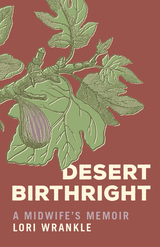 Desert Birthright: A Midwife's Memoir
Lori Wrankle
University of Utah Press, 2025 The coming-of-age memoir of a homebirth midwife in the Southwest
Lori Wrankle was sixteen when she helped deliver her first baby. “I witnessed the entire universe unfold at my feet,” she writes in Desert Birthright. Later, working as a hospital doula, Wrankle observed firsthand the suffering inflicted upon birthing women by male-dominated Western childbirth practices, from casual racism to unnecessary and nonconsensual procedures, including the dreaded “husband stitch.” After a traumatic labor and delivery of her own, she decided to take back woman-centered childbirth and start a homebirth midwifery practice.
Desert Birthright traverses twenty-five years of midwifery, often in fundamentalist polygamist circles, weaving together birth stories with childhood memories as Wrankle grapples with her shifting Mormon faith. Her poetic voice shines—a placenta becomes the tree of life, the folds in a baby’s arm layers of sand in the desert. Desert Birthright is a deeply personal story of life, death, and modern womanhood in the rural Southwest, and of one midwife’s journey of faith, self-discovery, and liberation in the face of adversity.
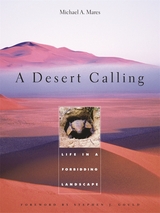 A Desert Calling: Life in a Forbidding Landscape
Michael A. Mares
Harvard University Press, 2002 For most of us the word "desert" conjures up images of barren wasteland, vast, dry stretches inimical to life. But for a great array of creatures, perhaps even more plentiful than those who inhabit tropical rainforests, the desert is a haven and a home. Travel with Michael Mares into the deserts of Argentina, Iran, Egypt, and the American Southwest and you will encounter a rich and memorable variety of these small, tenacious animals, many of them first discovered by Mares in areas never before studied. Accompanying Mares on his forays into these hostile habitats, we observe the remarkable behavioral, physiological, and ecological adaptations that have allowed such little-known species of rodents, bats, and other small mammals to persist in an arid world. At the same time, we see firsthand the perils and pitfalls that await biologists who venture into the field to investigate new habitats, discover new species, and add to our knowledge of the diversity of life.
Filled with the seductions and trials that such adventures entail, A Desert Calling affords an intimate understanding of the biologist's vocation. As he astonishes us with the range and variety of knowledge to be acquired through the determined investigation of little-known habitats, Mares opens a window on his own uncommon life, as well as on the uncommon life of the remote and mysterious corners of our planet.
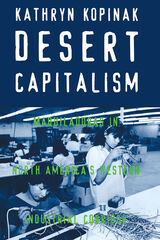 Desert Capitalism: Maquiladoras in North America's Western Industrial Corridor
Kathryn Kopinak
University of Arizona Press, 1996 Progress does not come easily to the maquiladoras. These foreign-owned assembly plants have moved southward from the border into Sonora and Chihuahua, giving rise to the concept of "desert capitalism." However, the plants have not necessarily brought about the improvements in the lives of workers that had been so hopefully expected. Sociologist Kathryn Kopinak here examines the maquiladora industry in Nogales, Sonora, and explores various questions concerning how it is changing with NAFTA and other attempts at regional integration. Focusing on the auto-parts industry, Kopinak observes that few maquiladoras have taken steps toward more sophisticated technology and innovative labor practices anticipated by the "second wave" hypothesis of modernization. She argues instead that the apparent advances have not benefitted the overwhelming majority of Mexican employees by increasing their wages or involving them in the workplace. Women workers in particular are segmented at the bottom of the job ladder. Kopinak provides information on facilities in both Nogales and the town of Imuris to offer a balanced perspective on border and inland maquiladoras. Desert Capitalism draws on interviews with workers about their daily lives in both their home and adopted communities and on interviews with Mexican and U.S. plant managers. Community surveys, newspaper advertisements, and government records are other important sources of data. It also reviews and synthesizes literature published only in Spanish and utilizes creative quantitative statistical techniques. The book thus marks a significant study of people's lives that seeks to contribute to the understanding of ongoing continental economic reorganization, and it holds important lessons for scholars of economics, anthropology, political science, history, sociology, women's studies, and regional planning.
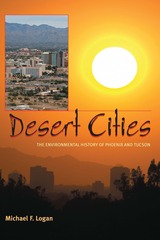 Desert Cities: The Environmental History of Phoenix and Tucson
Michael F. Logan
University of Pittsburgh Press, 2006
Phoenix is known as the “Valley of the Sun,” while Tucson is referred to as “The Old Pueblo.” These nicknames epitomize the difference in the public’s perception of each city. Phoenix continues to sprawl as one of America’s largest and fastest-growing cities. Tucson has witnessed a slower rate of growth, and has only one quarter of Phoenix’s population. This was not always the case. Prior to 1920, Tucson had a larger population. How did two cities, with such close physical proximity and similar natural environments develop so differently?
Desert Cities examines the environmental circumstances that led to the starkly divergent growth of these two cities. Michael Logan traces this significant imbalance to two main factors: water resources and cultural differences. Both cities began as agricultural communities. Phoenix had the advantage of a larger water supply, the Salt River, which has four and one half times the volume of Tucson’s Santa Cruz River. Because Phoenix had a larger river, it received federal assistance in the early twentieth century for the Salt River project, which provided water storage facilities. Tucson received no federal aid. Moreover, a significant cultural difference existed. Tucson, though it became a U.S. possession in 1853, always had a sizable Hispanic population. Phoenix was settled in the 1870s by Anglo pioneers who brought their visions of landscape development and commerce with them.
By examining the factors of watershed, culture, ethnicity, terrain, political favoritism, economic development, and history, Desert Cities offers a comprehensive evaluation that illuminates the causes of growth disparity in two major southwestern cities and provides a model for the study of bi-city resource competition.
 Desert Dreamers
Barbara Glowczewski
University of Minnesota Press, 2016 In the heart of Australia, on the cracked red earth, among wild vegetation, weathered bush, and dried-up creeks, hundreds of invisible pathways exist that become entangled on the earth's surface, underground, and in the sky, clouds, and wind. The Aboriginal people call them Jukurrpa: “the Dreamings.” This web is the Warlpiri land. Practicing the Dreaming, by ritual art, is for the Warlpiri a way to reactivate their ancestral traditions to connect with the cosmos and respond to current social and political issues. In 1979, anthropologist Barbara Glowczewski embarked on a journey to study the Warlpiri in the Australian outback. Struggling at once to maintain their traditions and cultural heritage as well as adapting to the continuing secularization and techno-progress of their European Australian counterparts, she takes us into the landscape, artistic rituals, and turmoil of the Warlpiri over three decades. Becoming accepted among Aboriginal families as a translator, and at the same time a negotiator of two vastly different visions of the earth, contemporary Western culture and the ancient indigenous dreaming culture, Glowczewski created a singular document of ethnological fieldwork and of self-transformation and discovery.
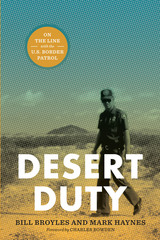 Desert Duty: On the Line with the U.S. Border Patrol
By Bill Broyles and Mark Haynes
University of Texas Press, 2010 While politicians and pundits endlessly debate immigration policy, U.S. Border Patrol agents put their lives on the line to enforce immigration law. In a day's work, agents may catch a load of narcotics, apprehend groups of people entering the country illegally, and intercept a potential terrorist. Their days often include rescuing aliens from death by thirst or murder by border bandits, preventing neighborhood assaults and burglaries, and administering first aid to accident victims, and may involve delivering an untimely baby or helping stranded motorists. As Bill Broyles and Mark Haynes sum it up, "Border Patrol is a hero job," one that too often goes unrecognized by the public. Desert Duty puts a human face on the Border Patrol. It features interviews with nineteen active-duty and retired agents who have worked at the Wellton, Arizona, station that watches over what is arguably the most perilous crossing along the border—a sparsely populated region of the Sonoran Desert with little water and summer temperatures that routinely top 110°F. The agents candidly discuss the rewards and frustrations of holding the line against illegal immigrants, smugglers, and other criminals—while often having to help the very people they are trying to thwart when they get into trouble in the desert. As one agent explains, "The thrill is tracking 'em up before they die. It's a rough ol' way to go—run outta water in this desert."
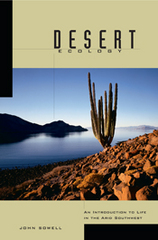 Desert Ecology
John B Sowell
University of Utah Press, 2001 Natural History "An energetic start quickly became a trudge; we glanced back frequently towards our point of departure, an air-conditioned vehicle. Not only did the hot air feel like a blast from a smelter’s furnace, but within minutes the reflected sunlight was doing perceptible damage to any exposed skin. I’m sure I was sweating more than I ever had before, yet my skin was dry...We found ourselves blinking rapidly to keep the eyes moist. After a few more minutes, we turned back for the car, leading our youngest child who would no longer open her eyes."
- John Sowell
Unlike books that merely identify what plants and animals live in the desert, Desert Ecology is a comprehensive but accessible introduction to how these organisms live where they do. Beginning with an overview of the Intermountain, Mojave, Sonoran, and Chihuahuan Deserts, Sowell presents the topographic and the meteorologic conditions that created these regions. He continues with a thorough examination of physiologic and behavioral adaptations that enable plants and animals, even humans, to survive and persist in these inhospitable places.
While basic scientific principles—such as photosynthesis, trophic levels, thermoregulation, and osmoregulation—are presented in terms that nonspecialists will understand, the real draw is the fascinating life histories of dozens of particular organisms. Explore the life cycle of the yucca and creosote bush, trace the wanderings of the gila monster and tenebrionid beetle, breathe in the rhythms of the desert at night.
"This book is for the curious," says the author, for all who enter the "wasteland," on foot or through imagination.
The Desert Fathers
Helen Waddell
University of Michigan Press, 1956 The words of the 4th-century monastics who founded the Desert Rule
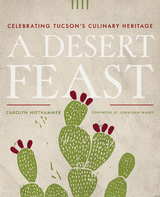 A Desert Feast: Celebrating Tucson's Culinary Heritage
Carolyn Niethammer, Foreword by Johnathan Mabry
University of Arizona Press, 2020 Southwest Book of the Year Award Winner Pubwest Book Design Award Winner Drawing on thousands of years of foodways, Tucson cuisine blends the influences of Indigenous, Mexican, mission-era Mediterranean, and ranch-style cowboy food traditions. This book offers a food pilgrimage, where stories and recipes demonstrate why the desert city of Tucson became American’s first UNESCO City of Gastronomy.
Both family supper tables and the city’s trendiest restaurants feature native desert plants and innovative dishes incorporating ancient agricultural staples. Award-winning writer Carolyn Niethammer deliciously shows how the Sonoran Desert’s first farmers grew tasty crops that continue to influence Tucson menus and how the arrival of Roman Catholic missionaries, Spanish soldiers, and Chinese farmers influenced what Tucsonans ate.
White Sonora wheat, tepary beans, and criollo cattle steaks make Tucson’s cuisine unique. In A Desert Feast, you’ll see pictures of kids learning to grow food at school, and you’ll meet the farmers, small-scale food entrepreneurs, and chefs who are dedicated to growing and using heritage foods. It’s fair to say, “Tucson tastes like nowhere else.”
Desert Frontier: Ecological and Economic Change Along the Western Sahel, 1600-1850
James L.A., Jr. Webb
University of Wisconsin Press, 1994 Desert Frontier is a study of the ecological and economic impact of a long-term trend toward increasing aridity along the southern edge of the western Sahara. Beginning in the early seventeenth century, this climatological trend forced the desert approximately 200–300 kilometers to the south, transforming ethnic identities and ways of life along the length of the Sahel. Based on extensive archival research and on Saharan oral data, Desert Frontier argues that the principal historical dynamics of the precolonial Sahel were determined by this pervasive ecological crisis, rather than by the dynamics of a European-dominated world system.
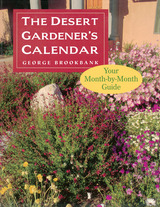 The Desert Gardener's Calendar: Your Month-by-Month Guide
George Brookbank
University of Arizona Press, 1999 What's the best time to plant or prune? When should you fertilize fruit trees? What's the earliest date to set out tomato plants? Gardeners in the desert Southwest can't rely on books that try to cover the whole country. Summer heat, less rain, and shorter, unreliable growing seasons are important factors in the desert. That's why The Desert Gardener's Calendar can be essential to gardening success.
Whether you're raising vegetables, nursing citrus trees, or just trying to keep your front yard looking its best, you'll find that this handy book gives you a valuable month-by-month perspective on the year. It helps you to focus on necessary activities and reminds you of simple tasks you might overlook.It's especially valuable for people who've moved to the desert regions from other parts of the country and follow old gardening dates that seldom apply to their new home.
The Desert Gardener's Calendar is a guide to the maintenance you need to do to keep your garden flourishing and your landscape attractive throughout the year. It combines the month-by-month gardening and landscaping activities from two separate books by George Brookbank—Desert Gardening, Fruits and Vegetables and Desert Landscaping—and was created in response to readers who have found the calendar sections of those books especially invaluable.
And because not all deserts are the same, Brookbank is careful to point out differences in scheduling encountered by gardeners in low- and middle-elevation regions in California and the Southwest. "I believe," says the author, "that if you use this calendar and let your judgment become more accurate with experience, you'll soon be doing everything right." Although that might suggest a day when you don't need this book, chances are good that, if you're a desert gardener, right now you do.
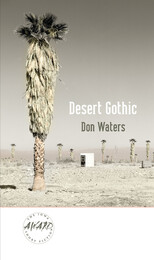 Desert Gothic
Don Waters
University of Iowa Press, 2007 This powerful debut collection, set in the light-filled deserts of Nevada and Arizona, introduces a darkly inventive new voice. Like an early Richard Ford, Don Waters writes with skill, empathy, and an edgy wit of worlds not often celebrated in contemporary literature. In Desert Gothic, Waters unleashes a wild and gritty cast and points them down paths of reckoning, where the characters earn the grace of their hard-won wisdom.
Set in bars, mortuaries, nursing homes, truck stops, and the “poverty motels that encircled downtown’s casino corridor,” Waters’s ten stories are full of misfit transients like Julian, a crematorium worker who decorates abandoned urns to create a “lush underground island,” and the instant Mormon missionary Eli, a hapless divorcé who “always likes people better when they’re a little broken.” Limo drivers, ultra-marathoners, vagabonds, and a distraught novelist-to-be populate the pages of these gritty stories.
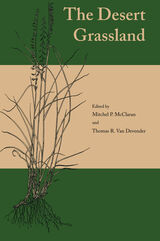 The Desert Grassland
Edited by Mitchel P. McClaran and Thomas R. Van Devender
University of Arizona Press, 1995 The mixed grass and shrub vegetation known to scientists as desert grassland is common to the basins and valleys that skirt the mountain ranges throughout southwestern North America, extending from Arizona, New Mexico and Texas down through thirteen Mexican states. This variegated ground cover is crucial to life in an arid environment. The Desert Grassland offers the most comprehensive study to date of these flora and the rich biotic communities they support.
Leading experts in geography, biology, botany, zoology, and geoscience present new research on the desert grassland and review a vast amount of earlier work. They reveal that present-day grasses once grew in the ice-age forests that existed in these areas before the climate dried and the trees vanished and how the intensity and frequency of fire can influence the plant and animal species of the grassland. They also document how the influence of humans—from Amerindians to contemporary ranchers, public land managers, and real estate developers—has changed the relative abundance of woody and herbaceous species and how the introduction of new plants and domesticated animals to the area has also affected biodiversity. The book concludes with a review of the attempts, both failed and successful, to reestablish plants in desert grasslands affected by overgrazing, drought, and farm abandonment.
Meticulously researched and copiously illustrated, The Desert Grassland is a major contribution to ecological literature. For advanced lay readers as well as students and scholars of history, geography, and ecology, it will be a standard reference work for years to come.
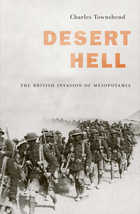 Desert Hell: The British Invasion of Mesopotamia
Charles Townshend
Harvard University Press, 2011 The U.S.-led conquest and occupation of Iraq have kept that troubled country in international headlines since 2003. For America’s major Coalition ally, Great Britain, however, this latest incursion into the region played out against the dramatic backdrop of imperial history: Britain’s fateful invasion of Mesopotamia in 1914 and the creation of a new nation from the shards of war.
The objectives of the expedition sent by the British Government of India were primarily strategic: to protect the Raj, impress Britain’s military power upon Arabs chafing under Ottoman rule, and secure the Persian oil supply. But over the course of the Mesopotamian campaign, these goals expanded, and by the end of World War I Britain was committed to controlling the entire region from Suez to India. The conquest of Mesopotamia and the creation of Iraq were the central acts in this boldly opportunistic bid for supremacy. Charles Townshend provides a compelling account of the atrocious, unnecessary suffering inflicted on the expedition’s mostly Indian troops, which set the pattern for Britain’s follow-up campaigns in Iraq and Afghanistan over the next seven years. He chronicles the overconfidence, incompetence, and dangerously vague policy that distorted the mission, and examines the steps by which an initially cautious strategic operation led to imperial expansion on a vast scale.
Desert Hell is a cautionary tale for makers of national policy. And for those with an interest in imperial history, it raises searching questions about Britain’s quest for global power and the indelible consequences of those actions for the Middle East and the world.
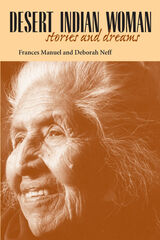 Desert Indian Woman: Stories and Dreams
Frances Manuel and Deborah Neff
University of Arizona Press, 2001 Basket weaver, storyteller, and tribal elder, Frances Manuel is a living preserver of Tohono O’odham culture. Speaking in her own words from the heart of the Arizona desert, she now shares the story of her life. She tells of O’odham culture and society, and of the fortunes and misfortunes of Native Americans in the southwestern borderlands over the past century. In Desert Indian Woman, Frances relates her life and her stories with the wit, humor, and insight that have endeared her to family and friends. She tells of her early childhood growing up in a mesquite brush house, her training in tribal traditions, her acquaintance with Mexican ways, and her education in an American boarding school. Through her recollections of births and deaths, heartache and happiness, we learn of her family’s migration from the reservation to the barrios and back again. In the details of her everyday life, we see how Frances has navigated between O’odham and American societies, always keeping her grandparents’ traditional teachings as her compass. It is extraordinary to hear from a Native American woman like Frances, in her own words and her own point of view, to enter the complex and sensitive aspects of her life experience, her sorrows, and her dreams. We also become privy to her continuing search for her identity across the border, and the ways in which Frances and Deborah have attempted to make sense of their friendship over twenty-odd years. Throughout the book, Deborah captures the rhythms of Frances’s narrative style, conveying the connectedness of her dreams, songs, and legends with everyday life, bringing images and people from faraway times and places into the present. Deborah Neff brings a breadth of experience in anthropology and Southwest Native American cultures to the task of placing Frances Manuel’s life in its broader historical context, illuminating how history works itself out in people’s everyday lives. Desert Indian Woman is the story of an individual life lived well and a major contribution to the understanding of history from a Native American point of view.
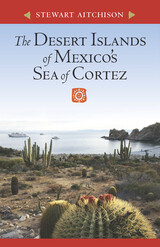 The Desert Islands of Mexico’s Sea of Cortez
Stewart Aitchison
University of Arizona Press, 2010 The desert islands in the Sea of Cortez are little known except to a few intrepid tourists, sailors, and fishermen. Though at first glance these stark islands may appear barren, they are a refuge for an astounding variety of plants and animals. While many of the species are typical of the greater Sonoran Desert region, some are endemic or unique to one or two islands. For example, Isla Santa Catalina is home to the world’s only rattlesnake that has lost its ability to grow a rattle. Other islands host nesting birds, such as Isla Rasa, a tiny, flat flow of basalt lava that attracts nearly half a million elegant and royal terns and Heermann’s gulls each spring.
The Desert Islands of Mexico’s Sea of Cortez is one of the few books devoted to the biogeography of this remarkable part of the world. The book explores the geologic origin of the gulf and its islands, presents some of the basics of island biogeography, details insular life—including residents of the intertidal zone —and provides a brief outlook for preserving this area. More than a simple guidebook, Aitchison’s writing will take both actual and armchair travelers through a gripping tale of natural history.
Like the rest of our fragile planet, the Sea of Cortez and its islands are threatened by humans. Overfishing has eliminated or greatly diminished many fish stocks, and dams on rivers that once flowed into the gulf prevent certain nutrients from reaching the sea. The tenuousness of this area makes the book’s extraordinary photographs and the firsthand descriptions by a well-known teacher, writer, and photographer all the more compelling.
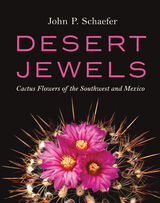 Desert Jewels: Cactus Flowers of the Southwest and Mexico
John P. Schaefer
University of Arizona Press, 2023 Cactus flowers are jewels of the desert—they add brilliant pops of color to our arid surroundings. In this book, renowned Tucson photographer John P. Schaefer brings the exquisite and unexpected beauty of the cactus flower to the page. Hundreds of close-up photographs of cactus flowers native to the U.S. Southwest and Mexico offer a visual feast of color and texture, nuance and light.
These stunning photographs allow us to appreciate the spectacular range of color and form cactus flowers have to offer. For the cactus enthusiast, the book offers a comprehensive collection of high-quality flower photographs unlike any other. The photographs cover more than 250 cactus species organized by genus. The book starts with an introduction by the photographer that is both autobiographical and informative. It offers a glimpse into his process for capturing these elusive desert gems, resulting in photographs so beautiful they were featured as a book of stamps issued by the U.S. Postal Service.
This collection of cactus flowers in bloom is a one-of-a-kind work by a master photographer.
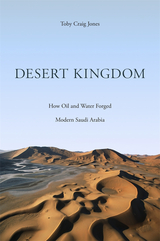 Desert Kingdom: How Oil and Water Forged Modern Saudi Arabia
Toby Craig Jones
Harvard University Press, 2010 Oil and water, and the science and technology used to harness them, have long been at the heart of political authority in Saudi Arabia. Oil’s abundance, and the fantastic wealth it generated, has been a keystone in the political primacy of the kingdom’s ruling family. The other bedrock element was water, whose importance was measured by its dearth. Over much of the twentieth century, it was through efforts to control and manage oil and water that the modern state of Saudi Arabia emerged.
The central government’s power over water, space, and people expanded steadily over time, enabled by increasing oil revenues. The operations of the Arabian American Oil Company proved critical to expansion and to achieving power over the environment. Political authority in Saudi Arabia took shape through global networks of oil, science, and expertise. And, where oil and water were central to the forging of Saudi authoritarianism, they were also instrumental in shaping politics on the ground. Nowhere was the impact more profound than in the oil-rich Eastern Province, where the politics of oil and water led to a yearning for national belonging and to calls for revolution.
Saudi Arabia is traditionally viewed through the lenses of Islam, tribe, and the economics of oil. Desert Kingdom now provides an alternative history of environmental power and the making of the modern Saudi state. It demonstrates how vital the exploitation of nature and the roles of science and global experts were to the consolidation of political authority in the desert.
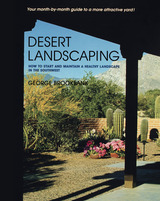 Desert Landscaping: How to Start and Maintain a Healthy Landscape in the Southwest
George Brookbank
University of Arizona Press, 1992 George Brookbank has distilled nearly twenty years' experience—as an extension agent in urban horticulture with the University of Arizona—into a practical book that tells how to avoid problems with desert landscaping before they occur and how to correct those that do. In the first part, "How to Start and Maintain a Desert Landscape," he provides 28 easy-to-use chapters that address concerns ranging from how to start a wildflower garden to how to cope with Texas root rot. In Part Two, "A Month-By-Month Maintenance Guide," he offers a handy almanac that tells what to do and what to watch out for each month of the year, with cross-references to the chapters in Part One. Homeowners who maintain their own landscape will find in this book ways to make the work more satisfying and productive, while those who hire landscape contractors can make sure the work is done effectively and economically. "You'll find all kinds of books on desert landscape design and materials, irrigation system and design, and landscape installation," says Brookbank. "So far as I know, however, this is the only book that tells you what to do with what you've got and how to keep it growing."
CONTENTS
Part 1 - How to Start and Maintain a Desert Landscape
1. Desert Conditions: How They Are "Different"
2. Plants Are Like People: They're Not Alike
3. Use Arid-Land Plants to Save Water
4. How to Irrigate in the Desert
5. How to Design and Install a Drip Irrigation System
6. Soils and Their Improvement I: How to Plant in the Desert
7. Soils and Their Improvement II: How to Use Fertilizers
8. What to Do When Things Go Wrong: A Troubleshooter's Guide
9. How to Avoid—and Repair—Frost Damage
10. How to Control "Weeds"
11. Palo Verde Borer Beetle: What to Do
12. How to Avoid Texas Root Rot
13. When You Move Into an Empty House
14. What to Do About Roots in Drains
15. How to Dig Up Plants and Move Them
16. How to Have Flower Bed Color All Year
17. Landscape Gardening with Containers
18. Starting Wildflowers
19. Starting a Lawn
20. Making and Keeping a Good Hedge
21. Pruning Trees and Shrubs
22. Palm Tree Care
23. Caring for Saguaros, Ocotillos, Avages, and Prickly Pears
24. Roses in the Desert: Hard Work and Some Disappointments
25. Landscaping with Citrus
26. Swimming Pools: Plants, Play, and Water-Saving
27. Landscape Maintenance While You're Away
28. Condominiums: Common Grounds, Common Problems
Part 2 - A Month-by-Month Maintenance Guide
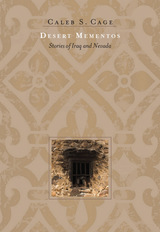 Desert Mementos: Stories of Iraq and Nevada
Caleb S. Cage
University of Nevada Press, 2017 Desert Mementos is a collection of loosely connected short stories set during the early stages of the Iraq War (2004 and 2005). The stories rotate from battles with insurgents and the drudgery of the war machine in Iraq to Nevada, where characters are either preparing for war, escaping it during their leave, or returning home having seen what they’ve seen.
Cage captures similarities in the respective desert landscapes of both Iraq and Nevada, but it is not just a study in contrasting landscapes. The inter-connected stories explore similarities and differences in human needs from the perspectives of vastly different cultures. Specifically, the stories deftly capture the overlap in the respective desert landscapes of each region, the contrasting cultures and worldviews, and the common need for hope. Taken together, the stories represent the arc of a year-long deployment by young soldiers. Cage’s stories are bound together by the soldier’s searing experiences in the desert, bookended by leaving and returning home to Nevada, which in many ways can be just as disorienting as patrolling the Iraq desert.
 Desert Navigator: The Journey of an Ant
Rüdiger Wehner
Harvard University Press, 2020 Winner of the Association of American Publishers PROSE Award for Excellence in Biological and Life Sciences
A world-renowned researcher of animal behavior reveals the extraordinary orienteering skills of desert ants, offering a thrilling account of the sophisticated ways insects function in their natural environments.
Cataglyphis desert ants are agile ultrarunners who can tolerate near-lethal temperatures when they forage in the hot midday sun. But it is their remarkable navigational abilities that make these ants so fascinating to study. Whether in the Sahara or its ecological equivalents in the Namib Desert and Australian Outback, the Cataglyphis navigators can set out foraging across vast expanses of desert terrain in search of prey, and then find the shortest way home. For almost half a century, Rüdiger Wehner and his collaborators have devised elegant experiments to unmask how they do it.
Through a lively and lucid narrative, Desert Navigator offers a firsthand look at the extraordinary navigational skills of these charismatic desert dwellers and the experiments that revealed how they strategize and solve complex problems. Wehner and his team discovered that these insect navigators use visual cues in the sky that humans are unable to see, the Earth’s magnetic field, wind direction, a step counter, and panoramic “snapshots” of landmarks, among other resources. The ants combine all of this information to steer an optimal course. At any given time during their long journey, they know exactly where to go. It is no wonder these nimble and versatile creatures have become models in the study of animal navigation.
Desert Navigator brings to light the marvelous capacity and complexity found in these remarkable insects and shows us how mini brains can solve mega tasks.
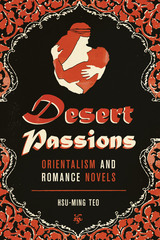 Desert Passions: Orientalism and Romance Novels
By Hsu-Ming Teo
University of Texas Press, 2012 The Sheik—E. M. Hull’s best-selling novel that became a wildly popular film starring Rudolph Valentino—kindled “sheik fever” across the Western world in the 1920s. A craze for all things romantically “Oriental” swept through fashion, film, and literature, spawning imitations and parodies without number. While that fervor has largely subsided, tales of passion between Western women and Arab men continue to enthrall readers of today’s mass-market romance novels. In this groundbreaking cultural history, Hsu-Ming Teo traces the literary lineage of these desert romances and historical bodice rippers from the twelfth to the twenty-first century and explores the gendered cultural and political purposes that they have served at various historical moments. Drawing on “high” literature, erotica, and popular romance fiction and films, Teo examines the changing meanings of Orientalist tropes such as crusades and conversion, abduction by Barbary pirates, sexual slavery, the fear of renegades, the Oriental despot and his harem, the figure of the powerful Western concubine, and fantasies of escape from the harem. She analyzes the impact of imperialism, decolonization, sexual liberation, feminism, and American involvement in the Middle East on women’s Orientalist fiction. Teo suggests that the rise of female-authored romance novels dramatically transformed the nature of Orientalism because it feminized the discourse; made white women central as producers, consumers, and imagined actors; and revised, reversed, or collapsed the binaries inherent in traditional analyses of Orientalism.
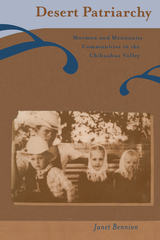 Desert Patriarchy: Mormon and Mennonite Communities in the Chihuahua Valley
Janet Bennion
University of Arizona Press, 2004 On the high desert plateau of northern Mexico, outsiders have taken refuge from the secular world. Here three Anglo communities of Mormons and Mennonites have ordered their lives around male supremacy, rigid religious duty, and a rejection of modern technology and culture. In so doing, they have successfully adapted to this harsh desert environment.
Janet Bennion has lived and worked among these people, and in this book she introduces a new paradigm—"desert patriarchy"—to explain their way of life. This perspective sheds light not only on these particular communities but also on the role of the desert environment in the development and maintenance of fundamentalist ideology in other parts of the United States and around the globe.
Making new connections between the arid environment, opposition to technology, and gender ideology, Bennion shows that it is the interplay of the desert and the unique social traditions and gender dynamics embedded in Anglo patriarchal fundamentalism that accounts for the successful longevity of the Mexican colonies. Her model defines the process by which male supremacy, female autonomous networking, and religious fundamentalism all facilitate successful adaptation to the environment.
More than a theoretical analysis, Desert Patriarchy provides an intimate glimpse into the daily lives of these people, showing how they have taken refuge in the desert to escape religious persecution, the forced secular education of their children, and economic and political marginalization. It particularly sheds light on the ironic autonomy of women within a patriarchal system, showing how fundamentalist women in Chihuahua are finding numerous creative ways to access power and satisfaction in a society structured to subordinate and even degrade them.
Desert Patriarchy richly expands the literature on nontraditional religious movements as it enhances our understanding of how environment can shape society. It offers unique insights into women's status in patriarchal communities and provides a new way of looking at similar communities worldwide.
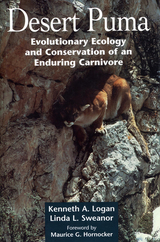 Desert Puma: Evolutionary Ecology And Conservation Of An Enduring Carnivore
Kenneth A. Logan and Linda L. Sweanor; Foreword by Maurice G. Hornocker
Island Press, 2001 Scientists and conservationists are beginning to understand the importance of top carnivores to the health and integrity of fully functioning ecosystems. As burgeoning human populations continue to impinge on natural landscapes, the need for understanding carnivore populations and how we affect them is becoming increasingly acute.Desert Puma represents one of the most detailed assessments ever produced of the biology and ecology of a top carnivore. The husband-and-wife team of Kenneth Logan and Linda Sweanor set forth extensive data gathered from their ten-year field study of pumas in the Chihuahua Desert of New Mexico, also drawing on other reliable scientific data gathered throughout the puma's geographic range. Chapters examine: the evolutionary and modern history of pumas, their taxonomy, and physical description a detailed description and history of the study area in the Chihuahua Desert field techniques that were used in the research puma population dynamics and life history strategies the implications of puma behavior and social organization the relationships of pumas and their preyThe authors provide important new information about both the biology of pumas and their evolutionary ecology -- not only what pumas do, but why they do it. Logan and Sweanor explain how an understanding of puma evolutionary ecology can, and must, inform long-term conservation strategies. They end the book with their ideas regarding strategies for puma management and conservation, along with a consideration of the future of pumas and humans. Desert Puma makes a significant and original contribution to the science not only of pumas in desert ecosystems but of the role of top predators in all environments. It is an essential contribution to the bookshelf of any wildlife biologist or conservationist involved in large-scale land management or wildlife management.
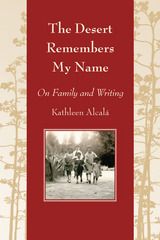 The Desert Remembers My Name: On Family and Writing
Kathleen Alcalá
University of Arizona Press, 2007 My parents always told me I was Mexican. I was Mexican because they were Mexican. This was sometimes modified to “Mexican American,” since I was born in California, and thus automatically a U.S. citizen. But, my parents said, this, too, was once part of Mexico. My father would say this with a sweeping gesture, taking in the smog, the beautiful mountains, the cars and houses and fast-food franchises. When he made that gesture, all was cleared away in my mind’s eye to leave the hazy impression of a better place. We were here when the white people came, the Spaniards, then the Americans. And we will be here when they go away, he would say, and it will be part of Mexico again.
Thus begins a lyrical and entirely absorbing collection of personal essays by esteemed Chicana writer and gifted storyteller Kathleen Alcalá. Loosely linked by an exploration of the many meanings of “family,” these essays move in a broad arc from the stories and experiences of those close to her to those whom she wonders about, like Andrea Yates, a mother who drowned her children. In the process of digging and sifting, she is frequently surprised by what she unearths. Her family, she discovers, were Jewish refugees from the Spanish Inquisition who took on the trappings of Catholicism in order to survive.
Although the essays are in many ways personal, they are also universal. When she examines her family history, she is encouraging us to inspect our own families, too. When she investigates a family secret, she is supporting our own search for meaning. And when she writes that being separated from our indigenous culture is “a form of illiteracy,” we know exactly what she means.
After reading these essays, we find that we have discovered not only why Kathleen Alcalá is a writer but also why we appreciate her so much. She helps us to find ourselves.
Desert Rose: The Life and Legacy of Coretta Scott King
Edythe Scott Bagley with Joe Hilley
University of Alabama Press, 2012 Desert Rose offers an intimate portrait of Coretta Scott King through the eyes of her sister, Edythe Scott Bagley, illuminating the formative experiences that shaped Coretta’s lifelong commitment to justice. From her upbringing in Alabama’s Black Belt to her role as a civil rights icon and global activist, this compelling biography reveals the depth of Coretta’s courage, artistry, and devotion to equality. Bagley’s heartfelt narrative honors a legacy of resilience, love, and leadership that continues to inspire generations.
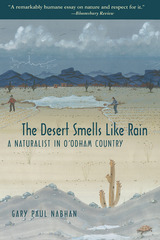 The Desert Smells Like Rain: A Naturalist in O'odham Country
Gary Paul Nabhan
University of Arizona Press, 2002
Published more than forty years ago, The Desert Smells Like Rain remains a classic work about nature, how to respect it, and what transplants can learn from the longtime residents of the Sonoran Desert, the Tohono O’odham people.
In this work, Gary Paul Nabhan brings O’odham voices to the page at every turn. He writes elegantly of how they husband scant water supplies, grow crops, and utilize edible wild foods. Woven through his account are coyote tales, O’odham children’s impressions of the desert, and observations of the political problems that come with living on both sides of an international border. Nabhan conveys the everyday life and extraordinary perseverance of these desert people.
This edition includes a new preface written by the author, in which he reflects on his gratitude for the O’odham people who shared their knowledge with him. He writes about his own heritage and connections to the desert, climate change, and the border. He shares his awe and gratitude for O’odham writers and storytellers who have been generous enough to share stories with those of us from other cultural traditions so that we may also respect and appreciate the smell of the desert after a rain.
Longtime residents of the Sonoran Desert, the Tohono O'odham people have spent centuries living off the land—a land that most modern citizens of southern Arizona consider totally inhospitable. Ethnobotanist Gary Nabhan has lived with the Tohono O'odham, long known as the Papagos, observing the delicate balance between these people and their environment. Bringing O'odham voices to the page at every turn, he writes elegantly of how they husband scant water supplies, grow crops, and utilize wild edible foods. Woven through his account are coyote tales, O'odham children's impressions of the desert, and observations on the political problems that come with living on both sides of an international border. Whether visiting a sacred cave in the Baboquivari Mountains or attending a saguaro wine-drinking ceremony, Nabhan conveys the everyday life and extraordinary perseverance of these desert people in a book that has become a contemporary classic of environmental literature.
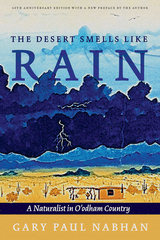 The Desert Smells Like Rain: A Naturalist in O'odham Country
Gary Paul Nabhan
University of Arizona Press, 1982 Published more than forty years ago, The Desert Smells Like Rain remains a classic work about nature, how to respect it, and what transplants can learn from the longtime residents of the Sonoran Desert, the Tohono O’odham people.
In this work, Gary Paul Nabhan brings O’odham voices to the page at every turn. He writes elegantly of how they husband scant water supplies, grow crops, and utilize edible wild foods. Woven through his account are coyote tales, O’odham children’s impressions of the desert, and observations of the political problems that come with living on both sides of an international border. Nabhan conveys the everyday life and extraordinary perseverance of these desert people.
This edition includes a new preface written by the author, in which he reflects on his gratitude for the O’odham people who shared their knowledge with him. He writes about his own heritage and connections to the desert, climate change, and the border. He shares his awe and gratitude for O’odham writers and storytellers who have been generous enough to share stories with those of us from other cultural traditions so that we may also respect and appreciate the smell of the desert after a rain.
Desert sonorous: Stories
Sean Bernard
University of Massachusetts Press, 2015 Undercover space aliens share an RV outside Tucson. A high school girl tries to make sense of the shooting of Gabby Giffords. Basketball fans stalk their team’s head coach. A young couple falls in and out of love over the course of several lifetimes. And teenage cross-country athletes run on and on through these ten stories set amid the strange desert landscapes of the American Southwest. Desert sonorous is a unique and energetic debut collection, blending realism with flashes of experimentation. Contemporary issues—immigration, drought, shootings—hover above a cast of memorable characters in search of life’s deeper meanings. As they struggle along, comic and resigned, intelligent and quiet, sad and frustrated, their strivings resound because their lives are in so many ways our own.
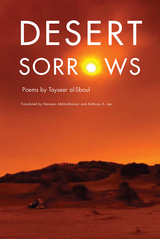 Desert Sorrows: Poems by Tayseer al-Sboul
Tayseer Al-Sboul
Michigan State University Press, 2015 No poet of the twentieth century has captured the experience of Arabic-speaking people in the modern world better than Tayseer al-Sboul. One of Jordan’s most celebrated writers, educated in that country, as well as in Lebanon and Syria, he faced the dilemmas and contradictions of the Arab world during the Cold War years. Caught between tradition and modernity, he dreamed of a great Arab nation. With unflinching courage and brutal honesty, he revealed his life in poems: his family, his connection with his homeland, his rejection of tradition, his flirtation with leftist ideology, his love affairs, his politics, his experience of war and defeat, his inner struggle, his quest for truth. Through al-Sboul’s poems, we understand the struggle of one Arab man to make sense of a world gone mad. Caught between the restrictions of traditional life, the cruelty of war, and the political oppression of the modern Middle East, he was determined to find his own peace, though it proved impossible. After the 1973 Arab-Israeli conflict, he lost all hope and took his own life. Featuring facing-page Arabic-English translations, this volume brings al-Sboul’s poetry into English for the first time.
Desert Survival Skills
By David Alloway
University of Texas Press, 2000 Remote desert locations, including the Chihuahuan Desert of northern Mexico, southern Texas, New Mexico, and Arizona, draw adventurers of all kinds, from the highly skilled and well prepared to urban cowboys who couldn't lead themselves (much less a horse!) to water. David Alloway's goal in this book is to help all of them survive when circumstances beyond their control strand them in the desert environment. In simple, friendly language, enlivened with humor and stories from his own extensive experience, Alloway here offers a practical, comprehensive handbook for both short-term and long-term survival in the Chihuahuan and other North American deserts.
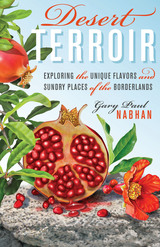 Desert Terroir: Exploring the Unique Flavors and Sundry Places of the Borderlands
By Gary Paul Nabhan
University of Texas Press, 2012 Why does food taste better when you know where it comes from? Because history—ecological, cultural, even personal—flavors every bite we eat. Whether it’s the volatile chemical compounds that a plant absorbs from the soil or the stories and memories of places that are evoked by taste, layers of flavor await those willing to delve into the roots of real food. In this landmark book, Gary Paul Nabhan takes us on a personal trip into the southwestern borderlands to discover the terroir—the “taste of the place”—that makes this desert so delicious. To savor the terroir of the borderlands, Nabhan presents a cornucopia of local foods—Mexican oregano, mesquite-flour tortillas, grass-fed beef, the popular Mexican dessert capirotada, and corvina (croaker or drum fish) among them—as well as food experiences that range from the foraging of Cabeza de Vaca and his shipwrecked companions to a modern-day camping expedition on the Rio Grande. Nabhan explores everything from the biochemical agents that create taste in these foods to their history and dispersion around the world. Through his field adventures and humorous stories, we learn why Mexican oregano is most potent when gathered at the most arid margins of its range—and why foods found in the remote regions of the borderlands have surprising connections to foods found by his ancestors in the deserts of the Mediterranean and the Middle East. By the end of his movable feast, Nabhan convinces us that the roots of this fascinating terroir must be anchored in our imaginations as well as in our shifting soils.
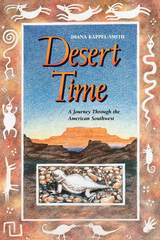 Desert Time
Diana Kappel-Smith
University of Arizona Press, 1992 New Englander Diana Kappel-Smith explored the great deserts of the American West over an 18-month period. Traveling largely alone through the Southwest and parts of Idaho and Oregon, she logged 25,000 miles and discovered facets of the desert—and its human inhabitants—that may surprise even long-time residents.
"You come to trust her company and to savor her observations: she is the sort of guide who gestures at what you would otherwise step across—or on—without noticing. She calls her collection 'an introduction to particulars.' These she infuses with radiance." —Los Angeles Times Book Review
"With prose that is both lyrical and down-to-earth, Kappel-Smith makes readers aware of the fragility of the desert and the necessity to preserve these wonderful, alien and mysterious places." —San Francisco Chronicle
"We glimpse moments of experience, rendered both in words and in conscientious line drawings. The book has a gentle, meandering tone. It consciously refuses to manufacture dramatic events." —Christian Science Monitor
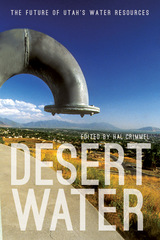 Desert Water: The Future of Utah's Water Resources
Hal Crimmel
University of Utah Press, 2014 Hal Crimmel has brought the findings of science together with the experienced voices of environmental social scientists, humanists, and activists to provide perspective on Utah water issues. The matters discussed are relevant beyond this one state, as similar conditions and concerns, especially over supply and demand in the face of demographic and climate change, exist throughout the West. Some of the essays are scientific and analytical; others literary and personal. Together they draw attention to problems that Utah residents and policy makers must address but also emphasize ways to build solutions. Desert Water will help citizens, policy makers, and anyone interested in Utah’s water supply and use—as everyone in the state should be—understand the real challengesand ethicsinvolved in managing this vital, finite resource. By awareness, these essays should create a sense of urgency for finding workable solutions.
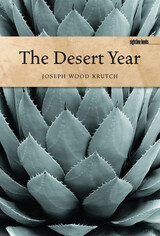 The Desert Year
Joseph Wood Krutch
University of Iowa Press, 1952 Now back in print, Joseph Wood Krutch’s Burroughs Award–winning The Desert Year is as beautiful as it is philosophically profound. Although Krutch—often called the Cactus Walden—came to the desert relatively late in his life, his curiosity and delight in his surroundings abound throughout The Desert Year, whether he is marveling at the majesty of the endless dry sea, at flowers carpeting the desert floor, or at the unexpected appearance of an army of frogs after a heavy rain. Krutch’s trenchant observations about life prospering in the hostile environment of Arizona’s Sonoran Desert turn to weighty questions about humanity and the precariousness of our existence, putting lie to Western denials of mind in the “lower” forms of life: “Let us not say that this animal or even this plant has ‘become adapted’ to desert conditions. Let us say rather that they have all shown courage and ingenuity in making the best of the world as they found it. And let us remember that if to use such terms in connection with them is a fallacy then it can only be somewhat less a fallacy to use the same terms in connection with ourselves.” This edition contains 33 exacting drawings by noted illustrator Rudolf Freund. Closely tied to Krutch’s uncluttered text, the drawings tell a story of ineffable beauty.
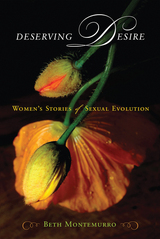 Deserving Desire: Women's Stories of Sexual Evolution
Montemurro, Beth
Rutgers University Press, 2015 Women experience considerable changes in their bodies, lives, and identity between the ages of twenty and seventy, including marriage, motherhood, the dissolution of relationships, and menopause, all of which often impact sexuality. In Deserving Desire, Beth Montemurro takes a wide-ranging look at the evolution of women’s sexuality over time, with a specific focus on the development of sexual subjectivity—that is sexual confidence, agency, and a sense of entitlement to sexual desire.
Detailed stories of the ninety-five women in this study explore how they become more comfortable with their bodies, when most begin to enjoy sex, feel confident and positive about engaging in it, and how they become sexual subjects in control of their bodies. Deserving Desire explores the complex multi-stage process in which sexual subjectivity evolves over a woman’s lifetime. As girls, they learn about sex and how those around them—parents, peers, religion and media—regard sex. Physical and emotional transitions such as having a baby or ending a relationship further affect women’s sexual confidence and desire. Montemurro emphasizes that sexual subjectivity is about feeling in control of sexual decision making and acting purposefully and confidently.
Though adolescent sexuality has been a major focus of sociological research, few studies have examined, as Montemurro does here, the development of sexuality through women’s lives and the events that change the way women feel about themselves, their bodies, and their relationships.
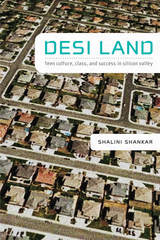 Desi Land: Teen Culture, Class, and Success in Silicon Valley
Shalini Shankar
Duke University Press, 2008 Desi Land is Shalini Shankar’s lively ethnographic account of South Asian American teen culture during the Silicon Valley dot-com boom. Shankar focuses on how South Asian Americans, or “Desis,” define and manage what it means to be successful in a place brimming with the promise of technology. Between 1999 and 2001 Shankar spent many months “kickin’ it” with Desi teenagers at three Silicon Valley high schools, and she has since followed their lives and stories. The diverse high-school students who populate Desi Land are Muslims, Hindus, Christians, and Sikhs, from South Asia and other locations; they include first- to fourth-generation immigrants whose parents’ careers vary from assembly-line workers to engineers and CEOs. By analyzing how Desi teens’ conceptions and realizations of success are influenced by community values, cultural practices, language use, and material culture, she offers a nuanced portrait of diasporic formations in a transforming urban region. Whether discussing instant messaging or arranged marriages, Desi bling or the pressures of the model minority myth, Shankar foregrounds the teens’ voices, perspectives, and stories. She investigates how Desi teens interact with dialogue and songs from Bollywood films as well as how they use their heritage language in ways that inform local meanings of ethnicity while they also connect to a broader South Asian diasporic consciousness. She analyzes how teens negotiate rules about dating and reconcile them with their longer-term desire to become adult members of their communities. In Desi Land Shankar not only shows how Desi teens of different socioeconomic backgrounds are differently able to succeed in Silicon Valley schools and economies but also how such variance affects meanings of race, class, and community for South Asian Americans.
Desierto: Memories of the Future
By Charles Bowden, foreword by William deBuys
University of Texas Press, 2018 “A dark, troubling vision of life in the desert, defined broadly; of mountain lions and drug kingpins, Mexican hopes and Indian feuds.”
—Los Angeles Times “In these powerful epic tales of the Sonora Desert, Bowden peoples the harsh land on both sides of the US-Mexican border with saints and sinners, but his enduring hero is the desert itself.”
—Kirkus Reviews
 Design and Debris: A Chaotics of Postmodern American Fiction
Joseph Conte
University of Alabama Press, 2002 Reading eight major contemporary authors through the lens of chaos theory, Conte offers new and original interpretations of works that have been the subject of much critical debate Design and Debris discusses the relationship between order and disorder in the works of John Hawkes, Harry Mathews, John Barth, Gilbert Sorrentino, Robert Coover, Thomas Pynchon, Kathy Acker, and Don DeLillo. In analyzing their work, Joseph Conte brings to bear a unique approach adapted from scientific thought: chaos theory. His chief concern is illuminating those works whose narrative structures locate order hidden in disorder (whose authors Conte terms “proceduralists”), and those whose structures reflect the opposite, disorder emerging from states of order (whose authors Conte calls “disruptors”). Documenting the paradigm shift from modernism, in which artists attempted to impose order on a disordered world, to postmodernism, in which the artist portrays the process of “orderly disorder,” Conte shows how the shift has led to postmodern artists' embrace of science in their treatment of complex ideas. Detailing how chaos theory interpenetrates disciplines as varied as economics, politics, biology, and cognitive science, he suggests a second paradigm shift: from modernist specialization to postmodern pluralism. In such a pluralistic world, the novel is freed from the purely literary and engages in a greater degree of interactivity-between literature and science, and between author and reader. Thus, Conte concludes, contemporary literature is a literature of flux and flexibility.
Design and Development of Multi-Lane Smart Electromechanical Actuators
Fawaz Yahya Annaz
The Institution of Engineering and Technology, 2014 The unavoidable element in the development of flight control systems (to date) has been in hydraulic actuators. This has been the case primarily because of their proven reliability and the lack of alternative technologies. However, the technology to build electromechanically actuated primary flight control systems is now available, which may mark the end of the hydraulic actuation systems - an important step for the development of the future 'all-electric' aircraft.
 Design and Discomfort: Teaching Shakespeare and Race
Edited by Laura B. Turchi
Arizona Center for Medieval and Renaissance Studies, 2025 What does it mean to teach Shakespeare in a world reckoning with racism and injustice? Explore new and innovative strategies for transforming discomfort into dialogue.
Design and Discomfort confronts the complexities of teaching Shakespeare in today’s classrooms, where discussions of race, bias, and historical legacies can provoke discomfort—but also transformation. Edited by Laura B. Turchi, this collection brings together educators and teaching artists who share innovative strategies for rethinking Shakespeare’s role in education.
Rather than treating Shakespeare as an untouchable authority, the contributors explore how his works can be a springboard for broader conversations about identity and justice. They advocate for performance-based and student-driven approaches that help students see themselves—their communities, their families, and their lived experiences—in the complex and seemingly distant world of Shakespeare.
This open-access volume provides both conceptual essays and practical lesson designs for educators navigating the intersections of Shakespeare and race. By embracing discomfort as part of the learning process, Design and Discomfort reframes how Shakespeare should be taught in classrooms today.
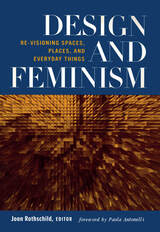 Design and Feminism: Re-visioning Spaces, Places, and Everyday Things
Joan Rothschild
Rutgers University Press, 1999 How well do our designed environments--the places and spaces where we live, work, and play--meet our aesthetic and functional needs? Increasingly, the distinction between the spaces considered public and private or work and home is becoming more blurred. As a result, innovative designs are needed to meet the challenges of our ever-changing environment. Our streets, parks, dwellings and tools are designed to a "one-size-fits-all" standard, and the responses of the design community to meet diverse needs have been mixed at best. Design and Feminism offers feminist critiques of these inadequate design standards, and suggest ideas, projects, and programs for change.
The interdisciplinary essays reflect the writers' diverse fields- architecture, planning, industrial and graphic design, and architectural, urban, and design history. Essays cover such subject as rethinking the American city, graphic design and the urban landscape, working at home, theories of women and design, and a trio of essays on industrial designs. A review essay of the literature in these fields- the first of its kind- rounds out the collection.
Contributors are Amelia Amon, Wendy E. Brawer, Cheryl Buckley, Sue Cavanagh, Alethea Cheng, Roberta M. Feldman, Etain Fitzpatrick, Alice T. Friedman, Dolores Hayden, Ghislaine Hermanuz, Barbara Knecht, Ellen Lupton, Maggie Mahboubian, Francine Monaco, Nancy Perkins, Victoria Rosner, Joan Rothschild, Susana Torre, Lynne Walker, and Leslie Kanes Weismann.
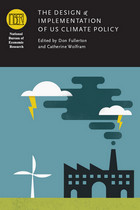 The Design and Implementation of US Climate Policy
Edited by Don Fullerton and Catherine D. Wolfram
University of Chicago Press, 2012 Economic research on climate change has been crucial in advancing our understanding of the consequences associated with global warming as well as the costs and benefits of the various policies that might reduce emissions of greenhouse gases. As nations work to develop climate policies, economic insights into their design and implementation are ever more important. With a balance between theoretical and empirical approaches, The Design and Implementation of US Climate Policy looks at the possible effects of various climate policies on a range of economic outcomes. The studies that comprise the volume examine topics that include the coordination—or lack thereof—between the federal and state governments, implications of monitoring and enforcing climate policy, and the specific consequences of various climate policies for the agricultural, automotive, and buildings sectors.
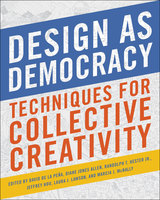 Design as Democracy: Techniques for Collective Creativity
Edited by David de la Pena, Diane Jones Allen, Randolph T. Hester Jr., Jeffrey Hou, Laura J. Lawson, and Marcia J. McNally
Island Press, 2017 Winner of the Environmental Design Research Association's 2018 Book Award
How can we design places that fulfill urgent needs of the community, achieve environmental justice, and inspire long-term stewardship? By bringing community members to the table, we open up the possibility of exchanging ideas meaningfully and transforming places powerfully. Collaboration like this is hands-on democracy in action. It’s up close. It’s personal. For decades, participatory design practices have helped enliven neighborhoods and promote cultural understanding. Yet, many designers still rely on the same techniques that were developed in the 1950s and 60s. These approaches offer predictability, but hold waning promise for addressing current and future design challenges. Design as Democracy: Techniques for Collective Creativity is written to reinvigorate democratic design, providing inspiration, techniques, and case stories for a wide range of contexts.
Edited by six leading practitioners and academics in the field of participatory design, with nearly 50 contributors from around the world, Design as Democracy shows how to design with communities in empowering and effective ways. The flow of the book’s nine chapters reflects the general progression of community design process, while also encouraging readers to search for ways that best serve their distinct needs and the culture and geography of diverse places. Each chapter presents a series of techniques around a theme, from approaching the initial stages of a project, to getting to know a community, to provoking political change through strategic thinking. Readers may approach the book as they would a cookbook, with recipes open to improvisation, adaptation, and being created anew.
Design as Democracy offers fresh insights for creating meaningful dialogue between designers and communities and for transforming places with justice and democracy in mind.
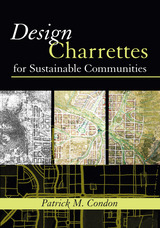 Design Charrettes for Sustainable Communities
Patrick M. Condon
Island Press, 2007 A step-by-step guide to more synthetic, holistic, and integrated urban design strategies, Design Charrettes for Sustainable Communities is a practical manual to accomplish complex community design decisions and create more green, clean, and equitable communities.
The design charrette has become an increasingly popular way to engage the public and stakeholders in public planning, and Design Charrettes for Sustainable Communities shows how citizens and officials can use this tool to change the way they make decisions, especially when addressing issues of the sustainable community.
Designed to build consensus and cooperation, a successful charrette produces a design that expresses the values and vision of the community. Patrick Condon outlines the key features of the charrette, an inclusive decision-making process that brings together citizens, designers, public officials, and developers in several days of collaborative workshops.
Drawing on years of experience designing sustainable urban environments and bringing together communities for charrettes, Condon’s manual provides step-by-step instructions for making this process work to everyone’s benefit. He translates emerging sustainable development concepts and problem-solving theory into concrete principles in order to explain what a charrette is, how to organize one, and how to make it work to produce sustainable urban design results.
Design, Control and Monitoring of Tidal Stream Turbine Systems
Mohamed Benbouzid
The Institution of Engineering and Technology, 2023 The worldwide potential of electric power from tidal currents is potentially between 100 and 120 GW. The technology uses the ebb and flow currents off coasts to drive submerged turbines. The high load factor and the predictable resource characteristics make tidal energy an attractive, reliable power source. The technology is advancing rapidly towards maturity; several projects have now reached a relatively mature stage and are close to completion, but challenges remain. Topics for ongoing research include hydrodynamics and turbine design, as well as the power conversion interface (including the electric generator), control, and monitoring and maintenance challenges.
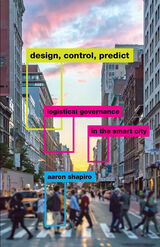 Design, Control, Predict: Logistical Governance in the Smart City
Aaron Shapiro
University of Minnesota Press, 2020 An in-depth look at life in the “smart” city
Technology has fundamentally transformed urban life. But today’s “smart” cities look little like what experts had predicted. Aaron Shapiro shows us the true face of the revolution in urban technology, taking the reader on a tour of today’s smart city. Along the way, he develops a new lens for interpreting urban technologies—logistical governance—to critique an urban future based on extraction and rationalization.
Through ethnographic research, journalistic interviews, and his own hands-on experience, Shapiro helps us peer through cracks in the smart city’s facade. He investigates the true price New Yorkers pay for “free,” ad-funded WiFi, finding that it ultimately serves the ends of commercial media. He also builds on his experience as a bike courier for a food delivery startup to examine how promises of “flexible employment” in the gig economy in fact pave the way for strict managerial control. And he turns his eye toward hot-button debates around police violence and new patrol technologies, asking whether algorithms are really the answer to reforming our cities’ ongoing crises of criminal justice.
Through these gripping accounts of the new technological urbanism, Design, Control, Predict makes vital contributions to conversations around data privacy and algorithmic governance. Shapiro brings much-needed empirical research to a field that has often relied on “10,000-foot views.” Timely, important, and expertly researched, Design, Control, Predict doesn’t just help us comprehend urbanism today—it advances strategies for critiquing and resisting a dystopian future that can seem inevitable.
Design Discourse: History, Theory, Criticism
Edited by Victor Margolin
University of Chicago Press, 1989 Although design infuses every object in the material world and gives form to immaterial processes as well, it is only recently that design itself has become the focus of intellectual debate. In Design Discourse, Victor Margolin gathers together a body of new writing in the emerging field of design studies. The contributors argue in different ways for a rethinking of design in light of its cultural significance and its powerful position in today's society.
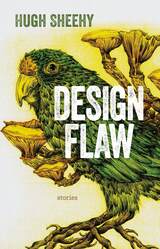 Design Flaw: Stories
Hugh Sheehy
Acre Books, 2022 Hugh Sheehy’s riveting new collection draws heavily from the genres of horror, mystery, science fiction, and myth.
These are tales of seekers, often damaged, who find themselves caught up in skewed realities, facing lurking threats, violent deaths, strange entities, and alienating technologies. Confronted with unsettling, escalating, circumstances, the disparate cast of characters are driven toward self-revelation and perverse moments of poignancy.
A troubled high schooler traps a peer in an underground storage space. A traumatized felon returns home to rob the man who molested him as a child. A videogame help-line operator suspects a regular caller, obsessed with a disturbing role-playing game, of real-life misdeeds. In the title story, an unhappy couple adopts a “designer animal,” a genetic hybrid created to be the perfect pet. But the “grot” makes trouble in the neighborhood, becoming emblematic of a deeper problem. “Something is wrong with the world,” the narrator’s husband explains. “A design flaw. It’s so thoroughly corrupted, I’m not sure how to fix it.”
Inventive and unpredictable, these thirteen stories are wholly immersive, showing Sheehy at his captivating best.
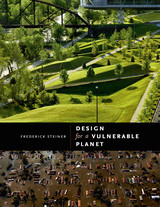 Design for a Vulnerable Planet
By Frederick Steiner
University of Texas Press, 2011 We inhabit a vulnerable planet. The devastation caused by natural disasters such as the southern Asian tsunami, Hurricanes Katrina and Ike, and the earthquakes in China's Sichuan province, Haiti, and Chile—as well as the ongoing depletion and degradation of the world's natural resources caused by a burgeoning human population—have made it clear that "business as usual" is no longer sustainable. We need to find ways to improve how we live on this planet while minimizing our impact on it. Design for a Vulnerable Planet sounds a call for designers and planners to go beyond traditional concepts of sustainability toward innovative new design that fosters regeneration and resilience. Drawing on his own and others' experiences across three continents, Frederick Steiner advocates design practice grounded in ecology and democracy and informed by critical regionalism and reflection. He begins by establishing the foundation for a more ecological approach to planning and design, adopting a broad view of ecology as encompassing human and natural, urban and wild environments. Steiner explores precedents for human ecological design provided by architect Paul Cret, landscape architect Ian McHarg, and developer George Mitchell while discussing their planning for the University of Texas campus, the Lake Austin watershed, and The Woodlands. Steiner then focuses on emerging Texas urbanism and extends his discussion to broader considerations beyond the Lone Star State, including regionalism, urbanism, and landscape in China and Italy. He also examines the lessons to be learned from human and natural disasters such as 9/11, Hurricane Katrina, and the BP oil spill. Finally, Steiner offers a blueprint for designing with nature to help heal the planet's vulnerabilities.
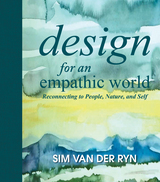 Design for an Empathic World: Reconnecting People, Nature, and Self
Sim Van der Ryn
Island Press, 2014 Despite an uncertain economy, the market for green building is exploding. The US green building market has expanded dramatically since 2008 and is projected to double in size by 2015 (from $42 billion in construction starts to $135 billion). But green-building pioneer Sim Van der Ryn says, “greening” our buildings is not enough. He advocates for “empathic design”, in which a designer not only works in concert with nature, but with an understanding of and empathy for the end user and for ones self. It is not just one of these connections, but all three that are necessary to design for a future that is more humane, equitable, and resilient.
Sim’s lifelong focus has been in shifting the paradigm in architecture and design. Instead of thinking about design primarily in relation to the infrastructure we live in and with—everything from buildings to wireless routing—he advocates for a focus on the people who use and are affected by this infrastructure. Basic design must include a real understanding of human ecology or end-user preferences. Understanding ones motivations and spirituality, Sim believes, is critical to designing with empathy for natural and human communities.
In Design for an Empathic World Van der Ryn shares his thoughts and experience about the design of our world today. With a focus on the strengths and weaknesses in our approach to the design of our communities, regions, and buildings he looks at promising trends and projects that demonstrate how we can help create a better world for others and ourselves. Architects, urban designers, and students of architecture will all enjoy this beautifully illustrated book drawing on a rich and revered career of a noted leader in their field. The journey described in Design for an Empathic World will help to inspire change and foster the collaboration and thoughtfulness necessary to achieve a more empathic future.
 Design for Business: Volume 1
Edited by Gjoko Muratovski
Intellect Books, 2012 Centered around the research findings of marketing and design consultants whose clients include Coca-Cola, P&G, General Motors, Deloitte, and Vodafone, among many others, Design for Business takes a practical approach to the role of design as a strategic resource to business. Including the studies of eminent academics, graphic designers, and corporate consultants who have worked with Bentley, Cadbury, British Airways, MasterCard, the Sydney and London Olympics, Nespresso, NFL, and many others, this collection assembles reflections from the people who help define the design and branding strategies of some of the most successful companies in the world. One of the few books available today that brings together rigorous studies on design and business from a multidisciplinary perspective, Design for Business also features a transcript from a conversation between editor Gjoko Muratovski and Dana Arnett, CEO of the US-based design and branding consultancy VSA Partners, in which the latter shares his experience working for more than thirty years with top companies such as IBM, Harley-Davidson, Nike, Converse, GAP, Caterpillar, and General Electric and explains why research and strategy is important in design and branding.
 Design for Business: Volume 2
Edited by Gjoko Muratovski
Intellect Books, 2014 One of very few books to bring together business and design, this collection features essays on topics ranging from branding and sustainability to business-driven design education. The centerpiece of the volume is an essay on simplicity in design by Per Mollerup, a distinguished Scandinavian designer, professor, and author. Bolstering this are transcripts of two interviews with the former global art director for Nike for the 2012 London Olympics, paired with a paper on Nike’s design and marketing strategies for the Olympic Games. Other features include a transcript of an interview with Dan Formosa, a New York-based design consultant, design researcher, and founding member of the iconic Smart Design studio; an essay on the importance of a research-led design practice in typography; a consideration of color and brand identity; an essay on packaging design testing methods; a study of greenwashing, sustainability, and communication design; a case study on organizational management by design; an essay on strategic decision-making in new product development; research on how Australian businesses are hiring designers; and an exciting case study on the design partnership between the hearing aid company BHS and the design studio Designworks that has revolutionized a health care sector.
Design for Business: Volume 3
Edited by Gjoko Muratovski
Intellect Books, 2015 This collection continues the successful Design for Business series, gathering work by scholars, researchers, and professionals that aim to raise awareness of design as a strategic business resource by consolidating it with other divergent, yet highly influential fields. Volume 3 covers such topics as the branding of a nation, care for the aging, public transportation, airports, workplace interiors, manufacturing, economic competitiveness, and public funding for new product development. First presented at the Design for Business research conference in Melbourne, Australia, the contributions assembled here will together keep pushing the interaction of design and business forward in productive, innovative ways.
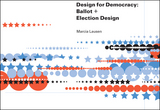 Design for Democracy: Ballot and Election Design
Marcia Lausen
University of Chicago Press, 2007 In November 2000, when the now-infamous "butterfly ballot" confused crucial Florida voters during a hotly contested presidential race, the importance of well-designed ballots to a functioning democracy caught the nation's attention. Recognizing that our entire voting process—from registering to vote to following instructions at the polling place—can be almost as confusing as the Florida ballot, Design for Democracy builds on the lessons of 2000 by presenting innovative steps for redesigning elections in the service of citizens.
Handsomely designed itself, this volume showcases adaptable design models that can improve almost every part of the election process by maximizing the clarity and usability of ballots, registration forms, posters and signs, informational brochures and guides, and even administrative materials for poll workers. Design for Democracy also lays out specific guidelines—covering issues of color palette, typography, and image use—that anchor the comprehensive election design system devised by the group of design specialists from whose name the book takes its title. Part of a major AIGA strategic program, this group's prototypes and recommendations have already been used successfully in major Illinois and Oregon elections and, collected here, are likely to spread across the country as more people become aware of the myriad benefits and broad applicability of improved election design.
An essential tool for designers and election officials, lawmakers and citizens, Design for Democracy harnesses the power of design to increase voter confidence, promote government transparency, and, perhaps most important, create an informed electorate.
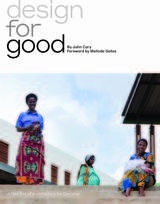 Design for Good: A New Era of Architecture for Everyone
John Cary
Island Press, 2017 "I can't recommend John Cary's book, Design for Good, highly enough. His argument...is clear and revolutionary." —Melinda Gates
“That’s what we do really: we do miracles,” said Anne-Marie Nyiranshimiyimana, who learned masonry in helping to build the Butaro Hospital, a project designed for and with the people of Rwanda using local materials. This, and other projects designed with dignity, show the power of good design. Almost nothing influences the quality of our lives more than the design of our homes, our schools, our workplaces, and our public spaces. Yet, design is often taken for granted and people don’t realize that they deserve better, or that better is even possible.
In Design for Good, John Cary offers character-driven, real-world stories about projects around the globe that offer more—buildings that are designed and created with and for the people who will use them. The book reveals a new understanding of the ways that design shapes our lives and gives professionals and interested citizens the tools to seek out and demand designs that dignify.
For too long, design has been seen as a luxury, the province of the rich, not the poor. That can no longer be acceptable to those of us in the design fields, nor to those affected by design that doesn’t consider human aspects.
From the Mulan Primary School in Guangdong, China to Kalamazoo College’s Arcus Center for Social Justice Leadership, the examples in the book show what is possible when design is a collaborative, dignified, empathic process. Building on a powerful foreword by philanthropist Melinda Gates, Cary draws from his own experience as well as dozens of interviews to show not only that everyone deserves good design, but how it can be achieved. This isn’t just another book for and about designers. It’s a book about the lives we lead, inextricably shaped by the spaces and places we inhabit.
 Design for Human Ecosystems: Landscape, Land Use, and Natural Resources
John Tillman Lyle; Foreword by Joan Woodward
Island Press, 1999 For more than 30 years, John Tillman Lyle (1934-1998) was one of the leading thinkers in the field of ecological design. Design for Human Ecosystems, originally published in 1985, is his classic text that explores methods of designing landscapes that function in the sustainable ways of natural ecosystems. The book provides a framework for thinking about and understanding ecological design, along with a wealth of real-world examples that bring to life Lyle's key ideas. Lyle traces the historical growth of design approaches involving natural processes, and presents an introduction to the principles, methods, and techniques that can be used to shape landscape, land use, and natural resources in an ecologically sensitive and sustainable manner. Lyle argues that careful design of human ecosystems recognizes three fundamental concerns: scale (the relative size of the landscape and its connections with larger and smaller systems), the design process itself, and the underlying order that binds ecosystems together and makes them work. He discusses the importance of each of these concerns, and presents a workable approach to designing systems that effectively accounts for all of them. The theory presented is supported throughout by numerous case studies that illustrate its practical applications. This new edition features a foreword by Joan Woodward, noted landscape architecture professor and colleague of Lyle, that places the book in the context of current ecological design thinking and discusses Lyle's contributions to the field. It will be a valuable resource for landscape architects, planners, students of ecological design, and anyone interested in creating landscapes that meet the needs of all an area's inhabitants -- human and nonhuman alike.
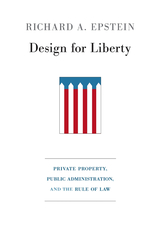 Design for Liberty: Private Property, Public Administration, and the Rule of Law
Richard A. Epstein
Harvard University Press, 2011 Following a vast expansion in the twentieth century, government is beginning to creak at the joints under its enormous weight. The signs are clear: a bloated civil service, low approval ratings for Congress and the President, increasing federal-state conflict, rampant distrust of politicians and government officials, record state deficits, and major unrest among public employees.
In this compact, clearly written book, the noted legal scholar Richard Epstein advocates a much smaller federal government, arguing that our over-regulated state allows too much discretion on the part of regulators, which results in arbitrary, unfair decisions, rent-seeking, and other abuses. Epstein bases his classical liberalism on the twin pillars of the rule of law and of private contracts and property rights—an overarching structure that allows private property to keep its form regardless of changes in population, tastes, technology, and wealth. This structure also makes possible a restrained public administration to implement limited objectives. Government continues to play a key role as night-watchman, but with the added flexibility in revenues and expenditures to attend to national defense and infrastructure formation.
Although no legal system can eliminate the need for discretion in the management of both private and public affairs, predictable laws can cabin the zone of discretion and permit arbitrary decisions to be challenged. Joining a set of strong property rights with sound but limited public administration could strengthen the rule of law, with its virtues of neutrality, generality, clarity, consistency, and forward-lookingness, and reverse the contempt and cynicism that have overcome us.
|
|
